Namibia and South Africa Tour Report 2019
21 October 2019



















































































































































































Beautiful Etaambura Lodge in remote Kaokoland is always a favourite of our guests (Image by Inger Vandyke)
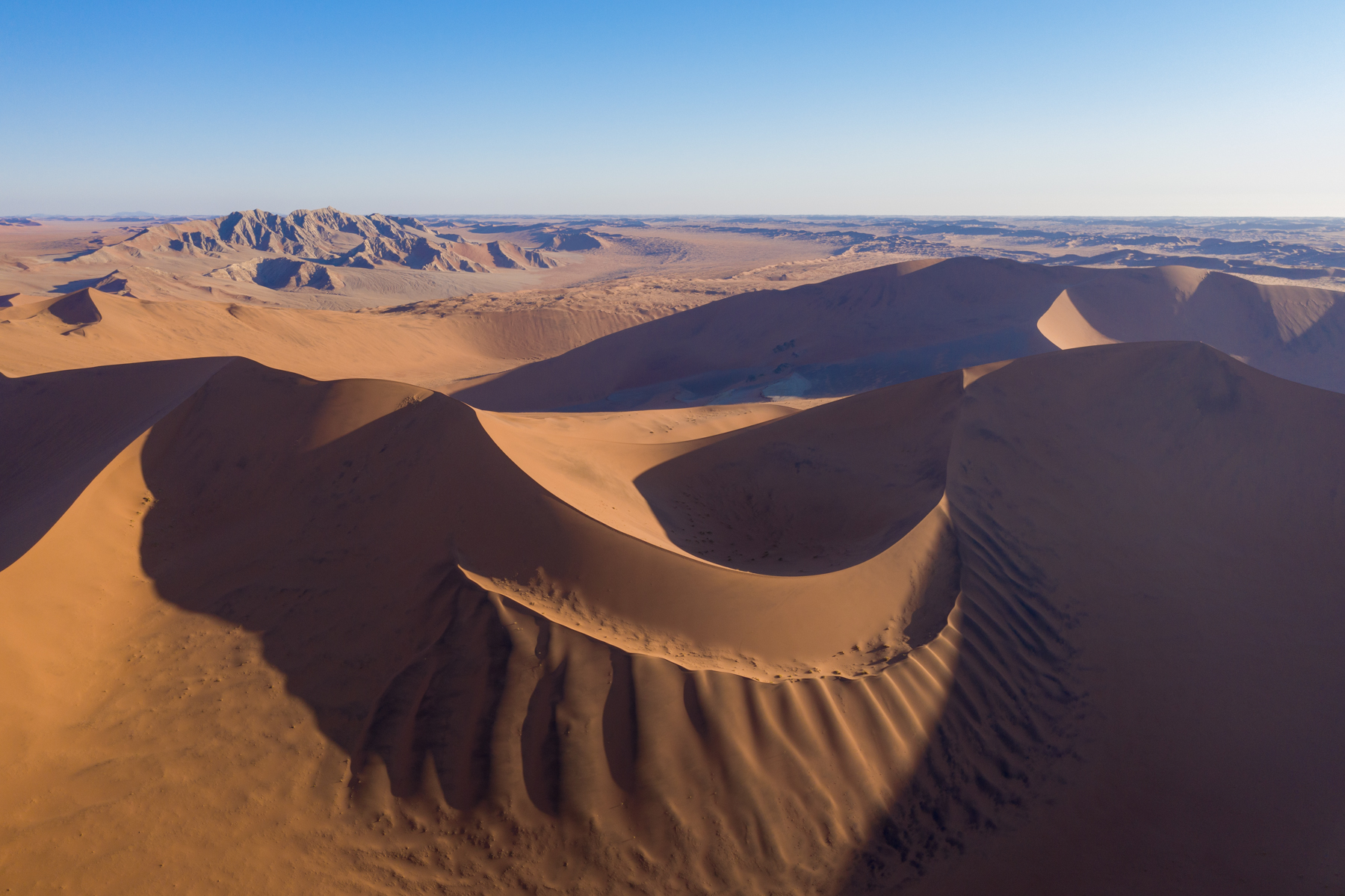
Aerial photography in Sossusvlei is one of the most sublime experiences in all of Africa (image by Inger Vandyke)

The Etosha Elephant bull that we all fell in love with! (Image by Inger Vandyke)
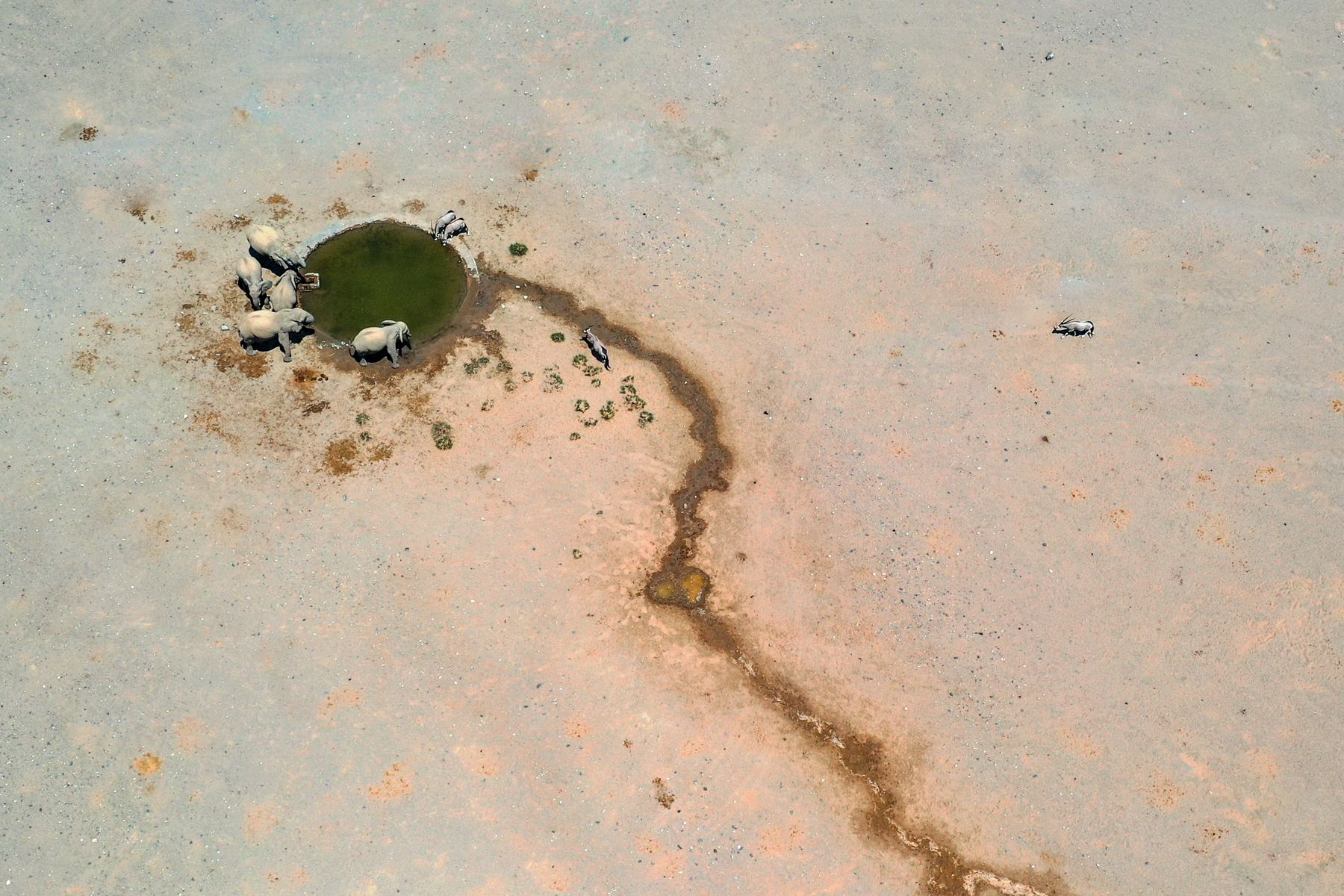
Aerial view of elephants and oryx in remote north-western Namibia (image by Inger Vandyke)

A Himba girl carries washing to the well in remote Kaokoland (Image by Inger Vandyke)

Skeleton Coast roadworks from the air (image by Inger Vandyke)

An Etosha elephant grazing on the thorny bushes near the Etosha Pan (Image by Inger Vandyke)
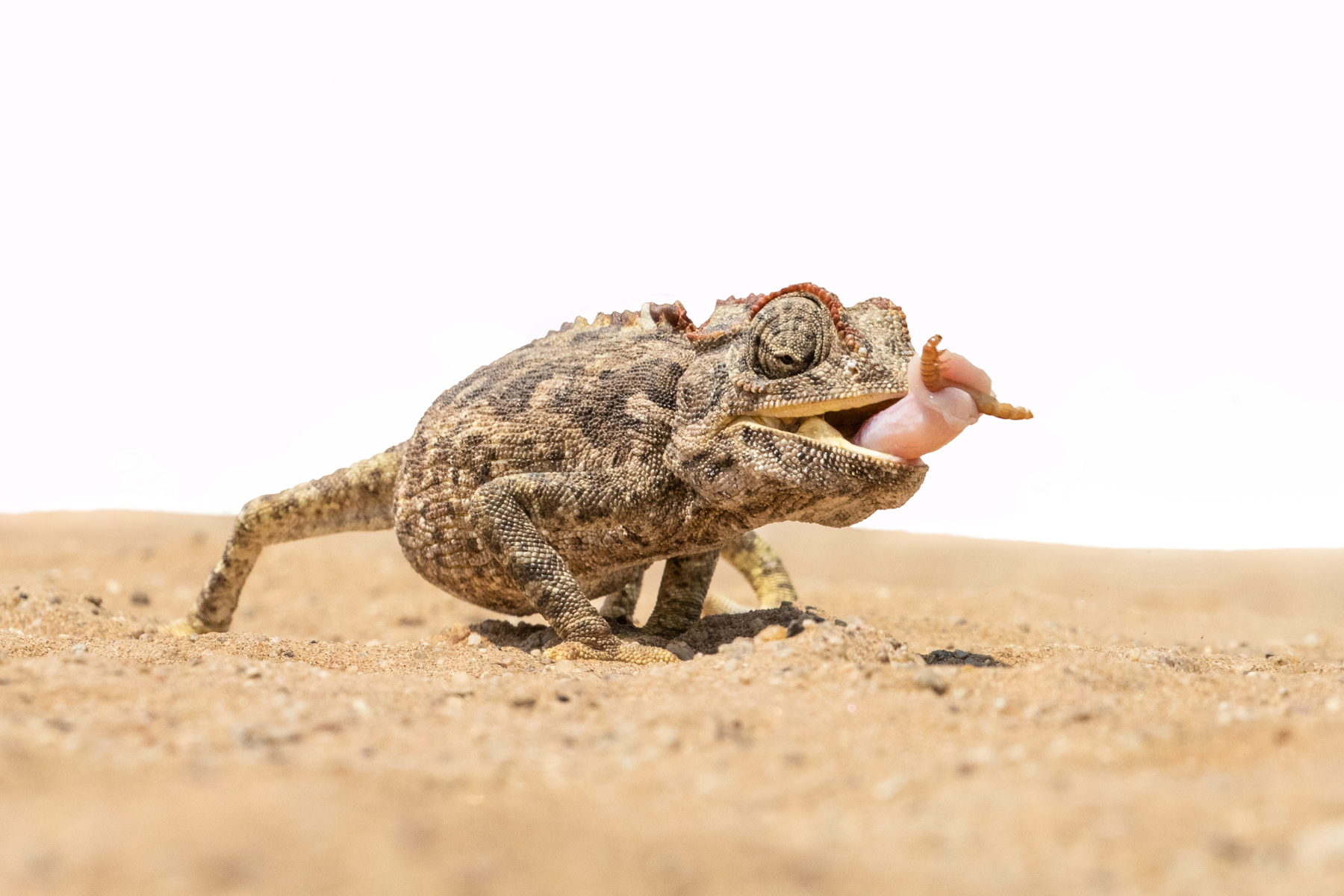
Who knew? A Namaqua Chameleon actually 'grabs' its meals using the end of its tongue! (image by Inger Vandyke)

Damara Dik Diks are almost "Bambi-like" they are so sweet (Image by Inger Vandyke)

Although common, Pied Crows look quite splendid against the red basalts of Palmwag Concession (Image by Inger Vandyke)
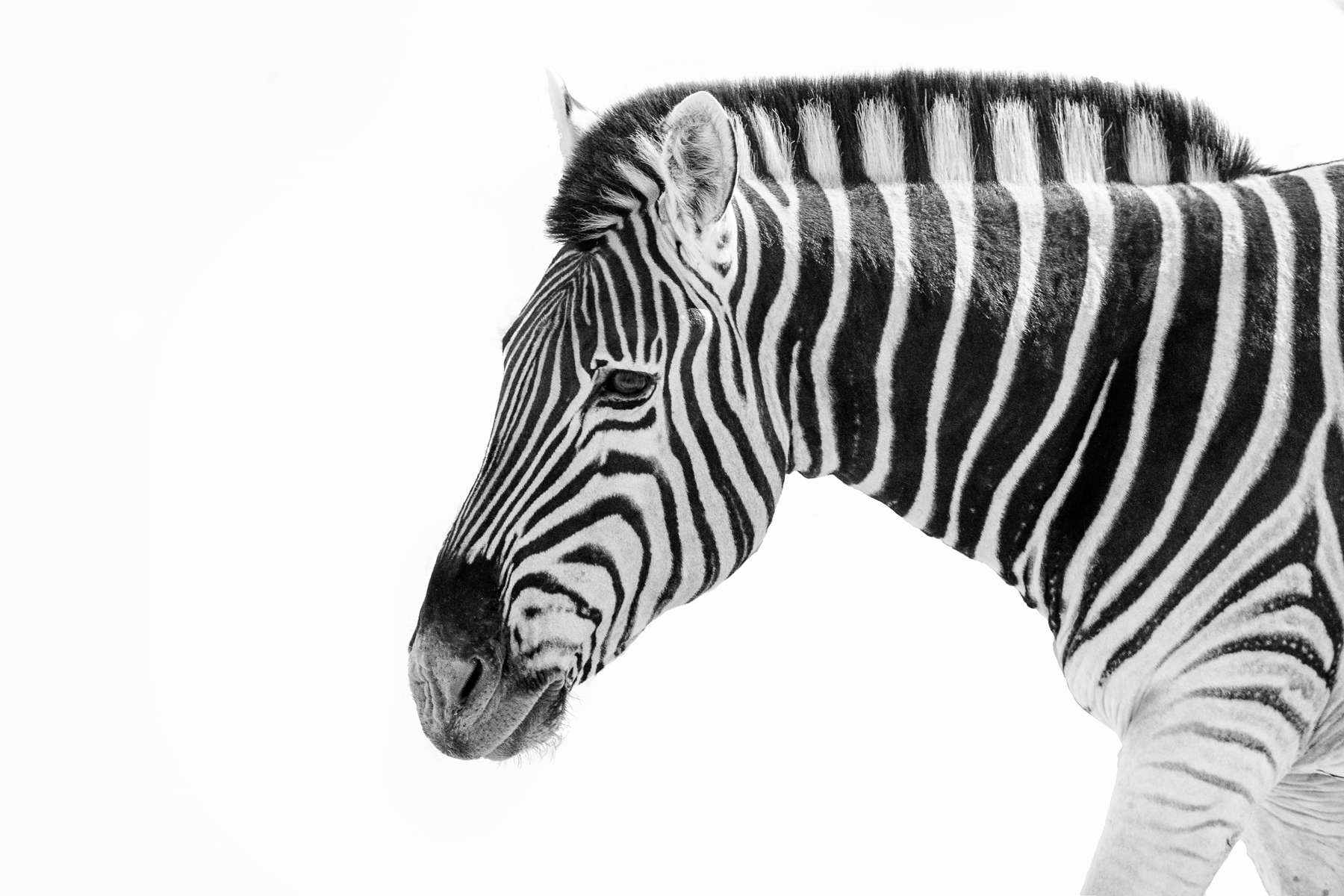
Zebra Portrait in black and white (image by Inger Vandyke)
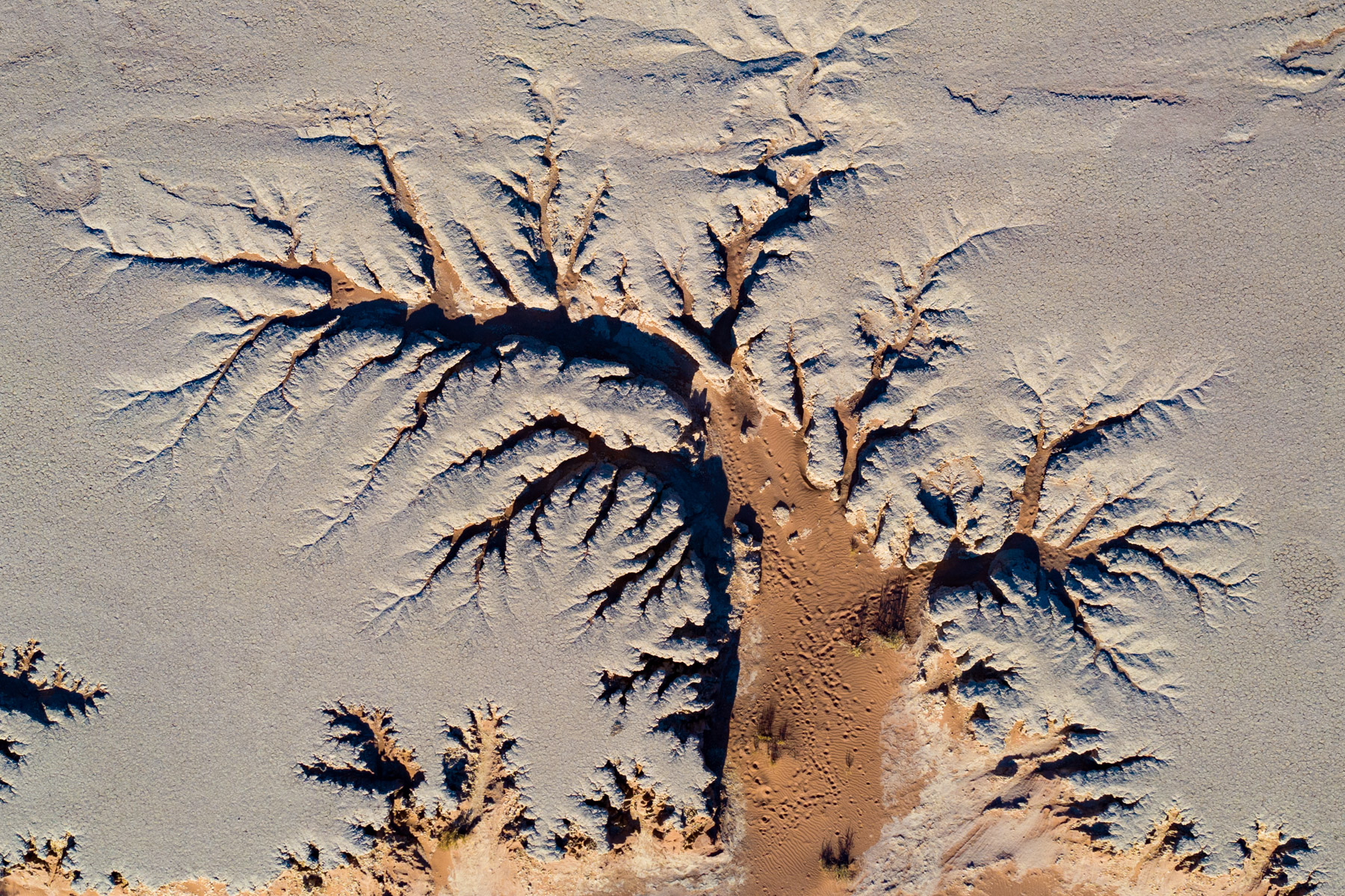
Aerial detail of Deadvlei (image by Inger Vandyke)

Himba women wear an Eha, or large cone shell, as decoration after they marry (Image by Inger Vandyke)

The rose coloured landscapes of Palmwag act as beautiful backdrops for photographing giraffes (Image by Inger Vandyke)

A curious Rock Hyrax looks at us from near the balcony at Etaambura (Image by Inger Vandyke)
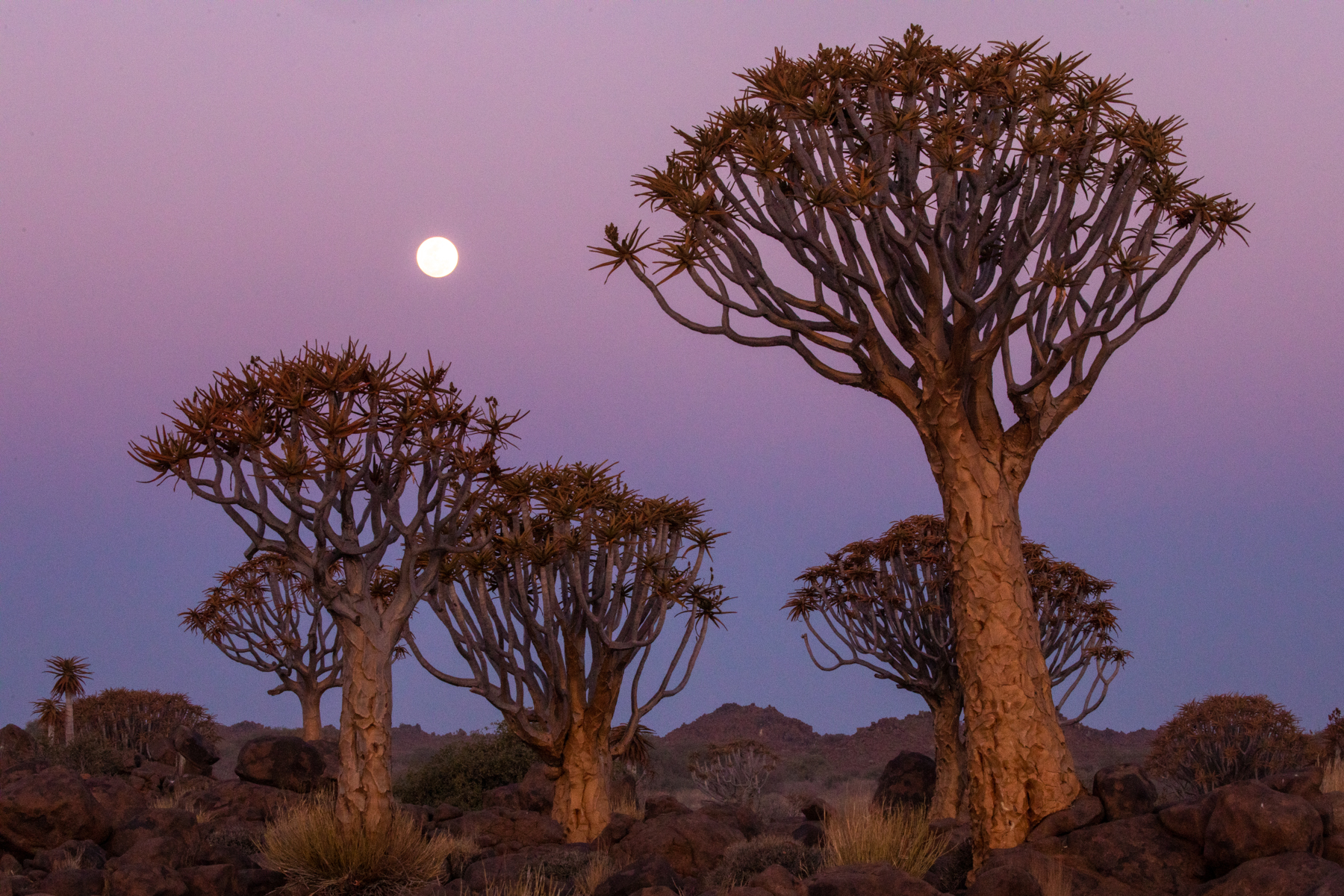
The setting moon at the Quiver Tree Forest in Keetmanshoop (image by Inger Vandyke)

Sand ripple detail at Sossusvlei (Image by Inger Vandyke)
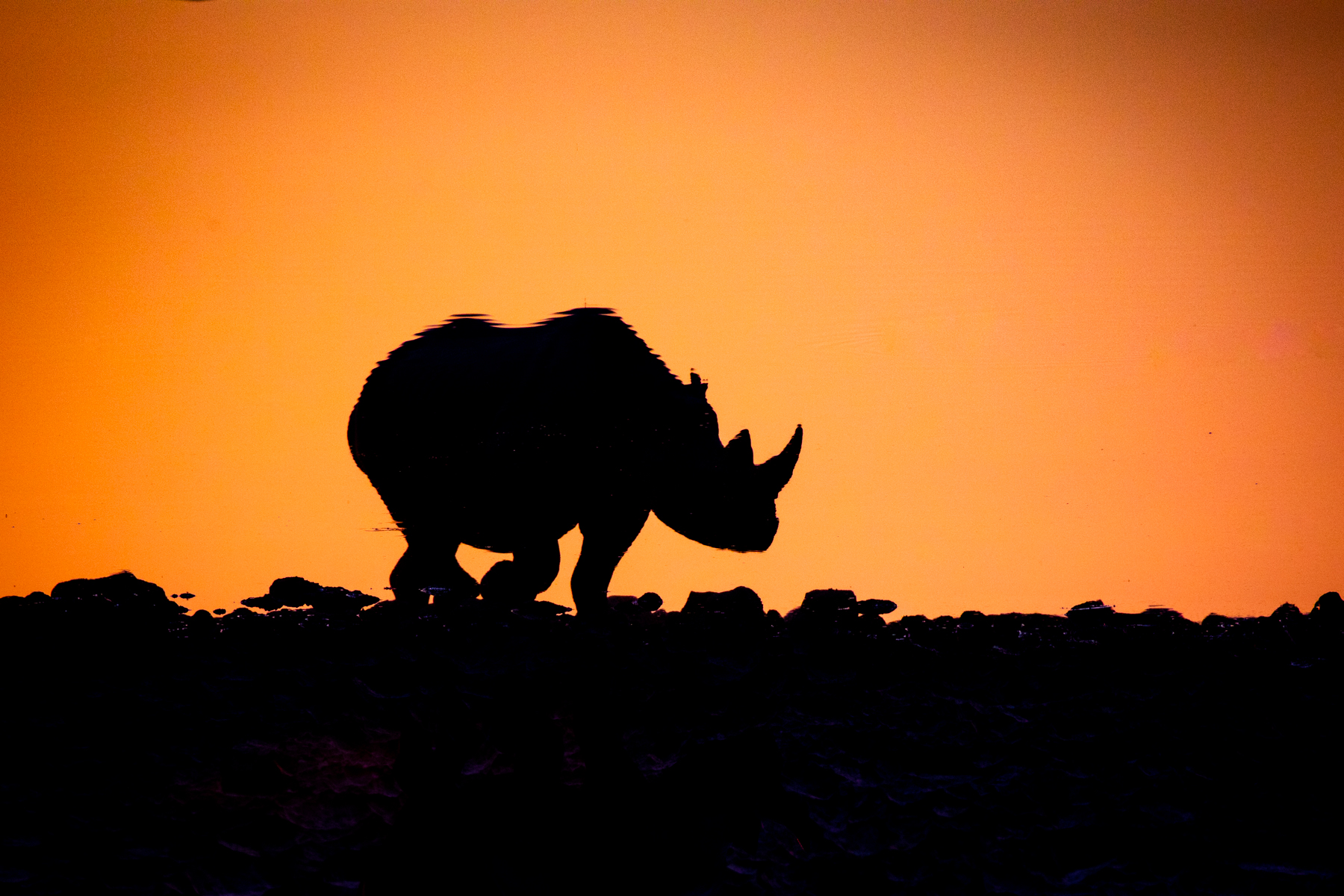
Rhino Reflections (image by Inger Vandyke)
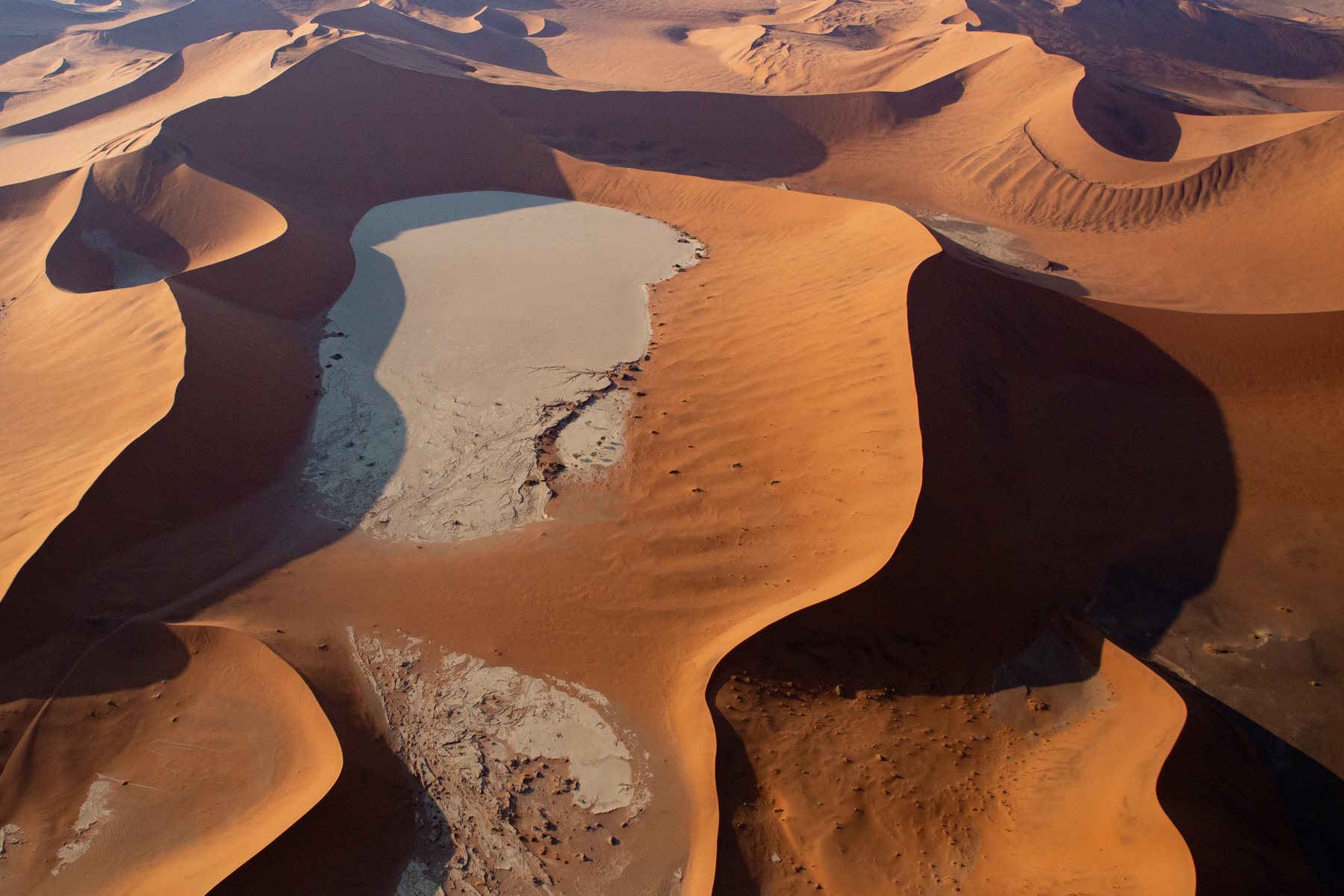
Deadvlei from the air (image by Inger Vandyke)

A backlit Oryx one late afternoon in the Kgalagadi Transfrontier Reserve (Image by Inger Vandyke)

An abandoned oil rig on the remote Skeleton Coast (Image by Inger Vandyke)

A pair of young male Springbok practice rutting at sunrise in the Kgalagadi Transfrontier Reserve (Image by Inger Vandyke)
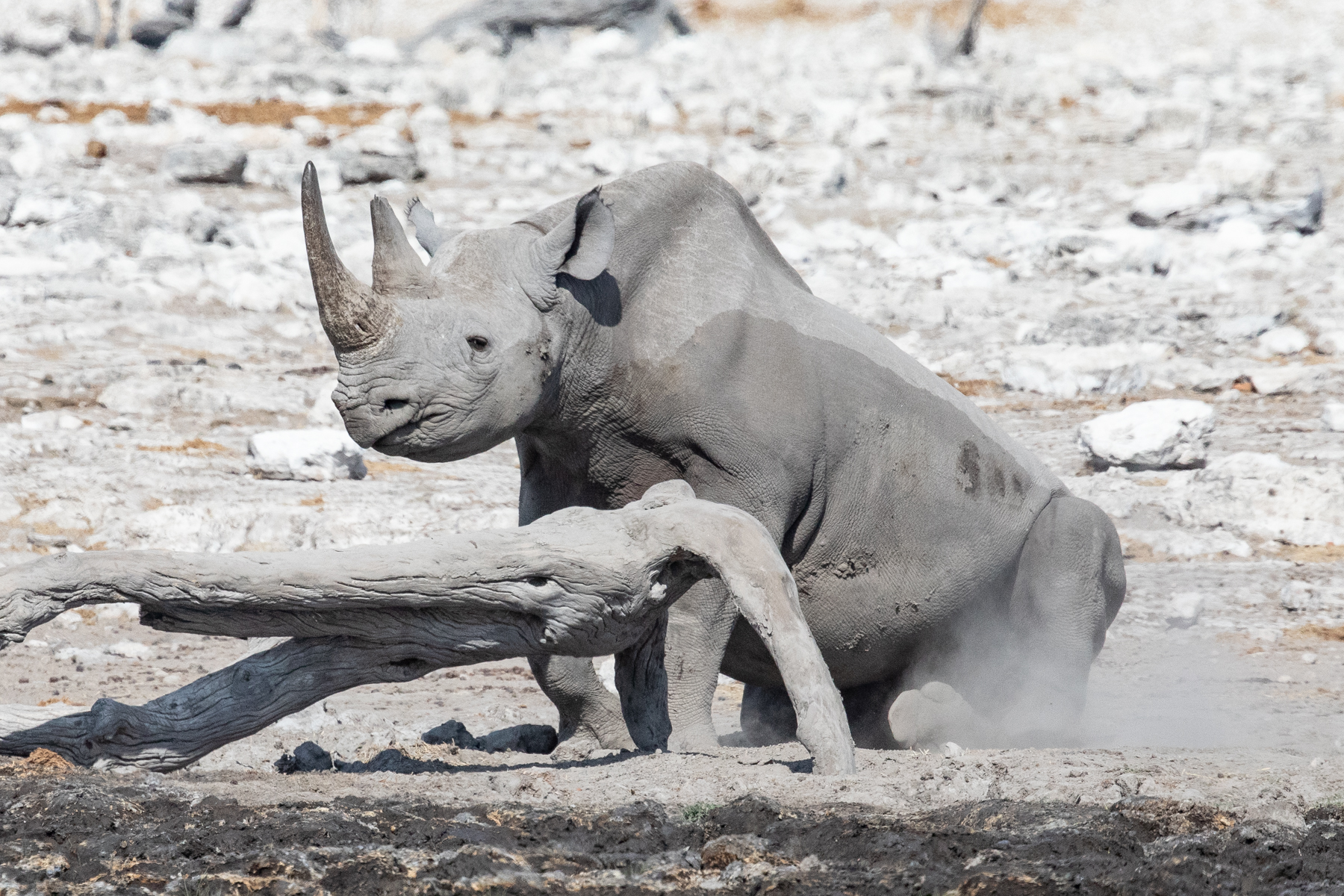
A Black Rhino decides to lie down behind a piece of wood after his drink at Rietfontein waterhole in Etosha (image by Inger Vandyke)
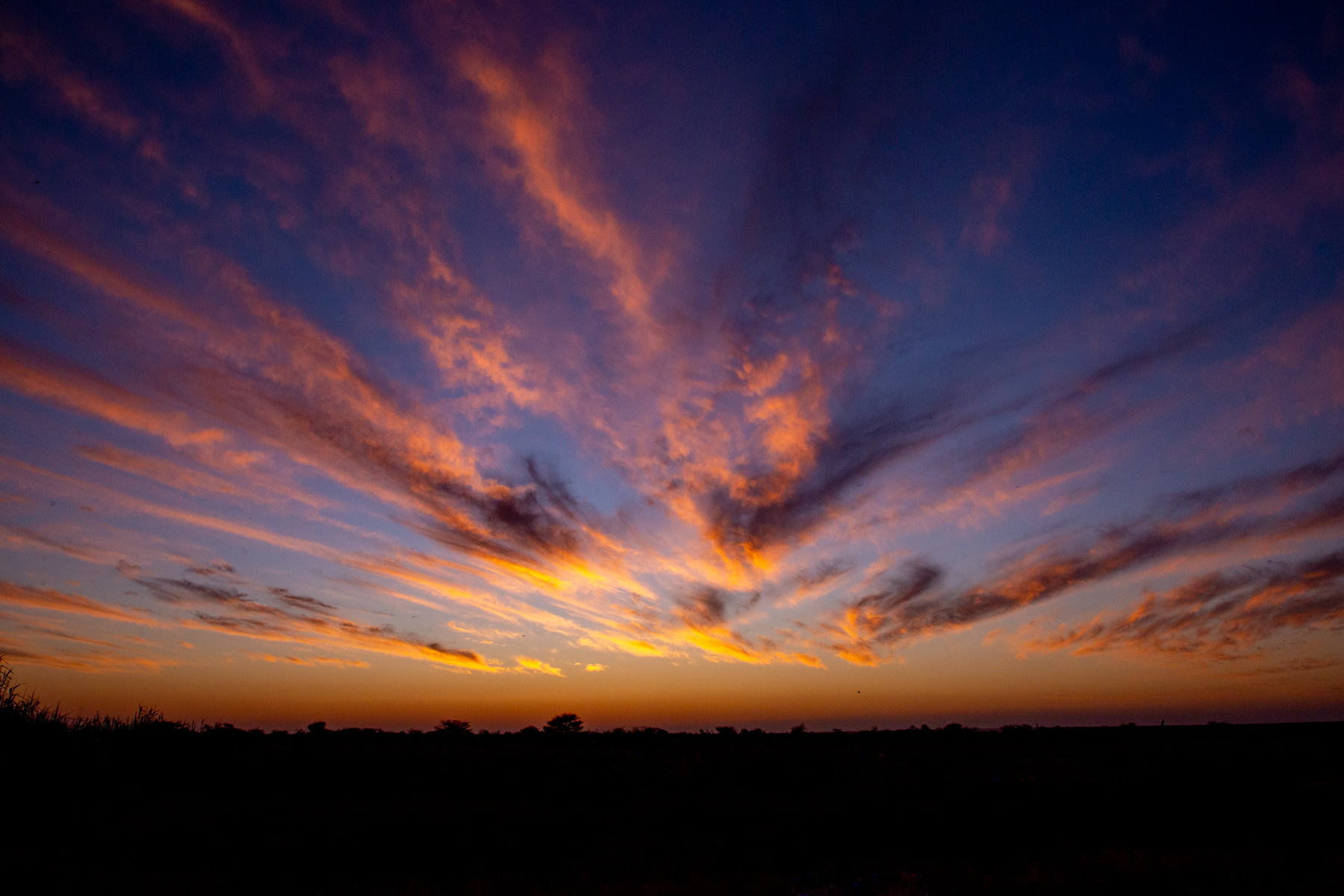
One of the many spectacular sunsets we witnessed on our tours (image by Inger Vandyke)

A memorable sunset at Palmwag Lodge (Image by Inger Vandyke)

"Look at my big ears!" A baby Desert Elephant plays Dumbo (Image by Inger Vandyke)

A healthy Black-backed Jackal fights with a mangy one over a seal carcass (Image by Inger Vandyke)
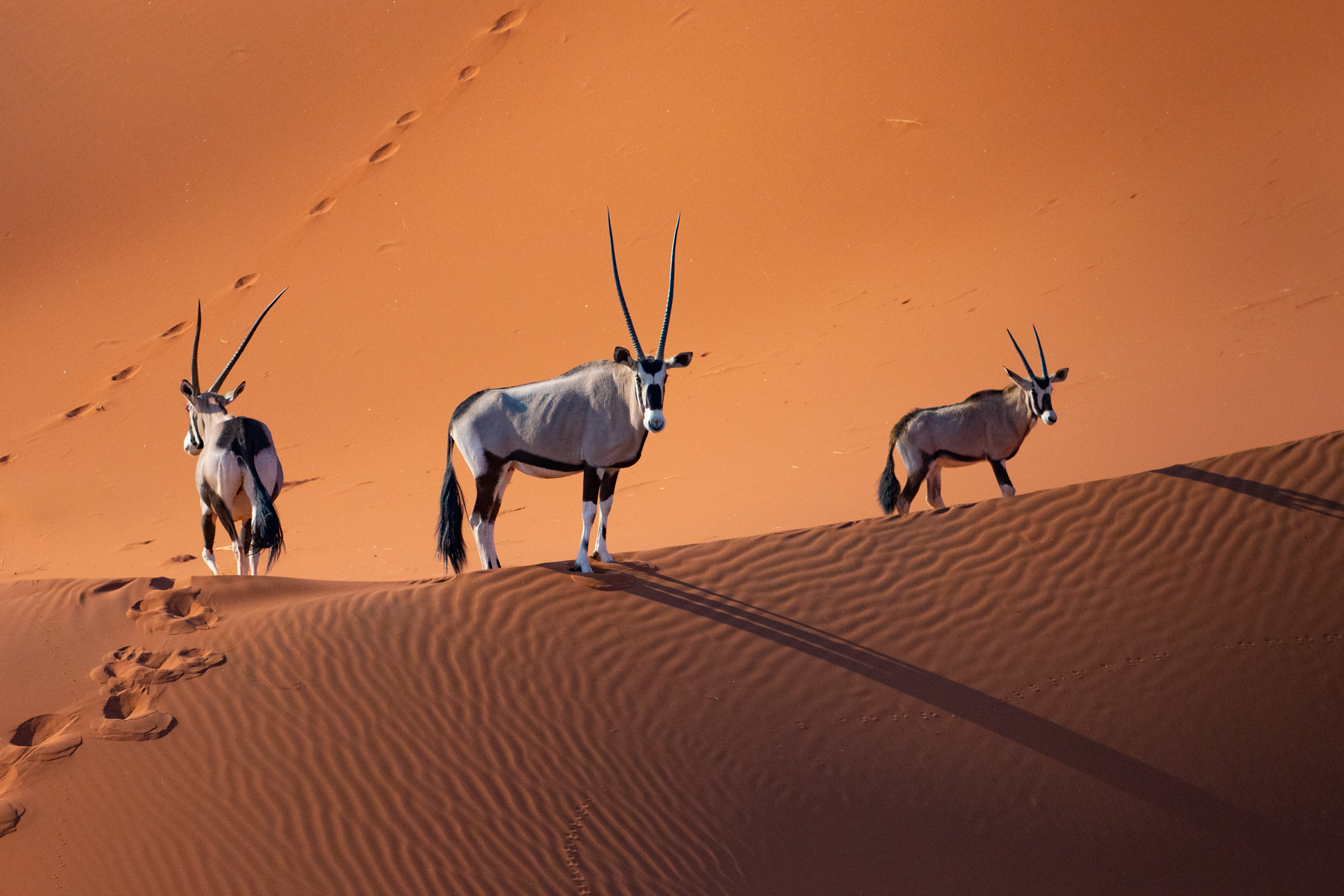
Three Oryx on a dune taking from our aerial flight in a helicopter with no doors! (image by Inger Vandyke)
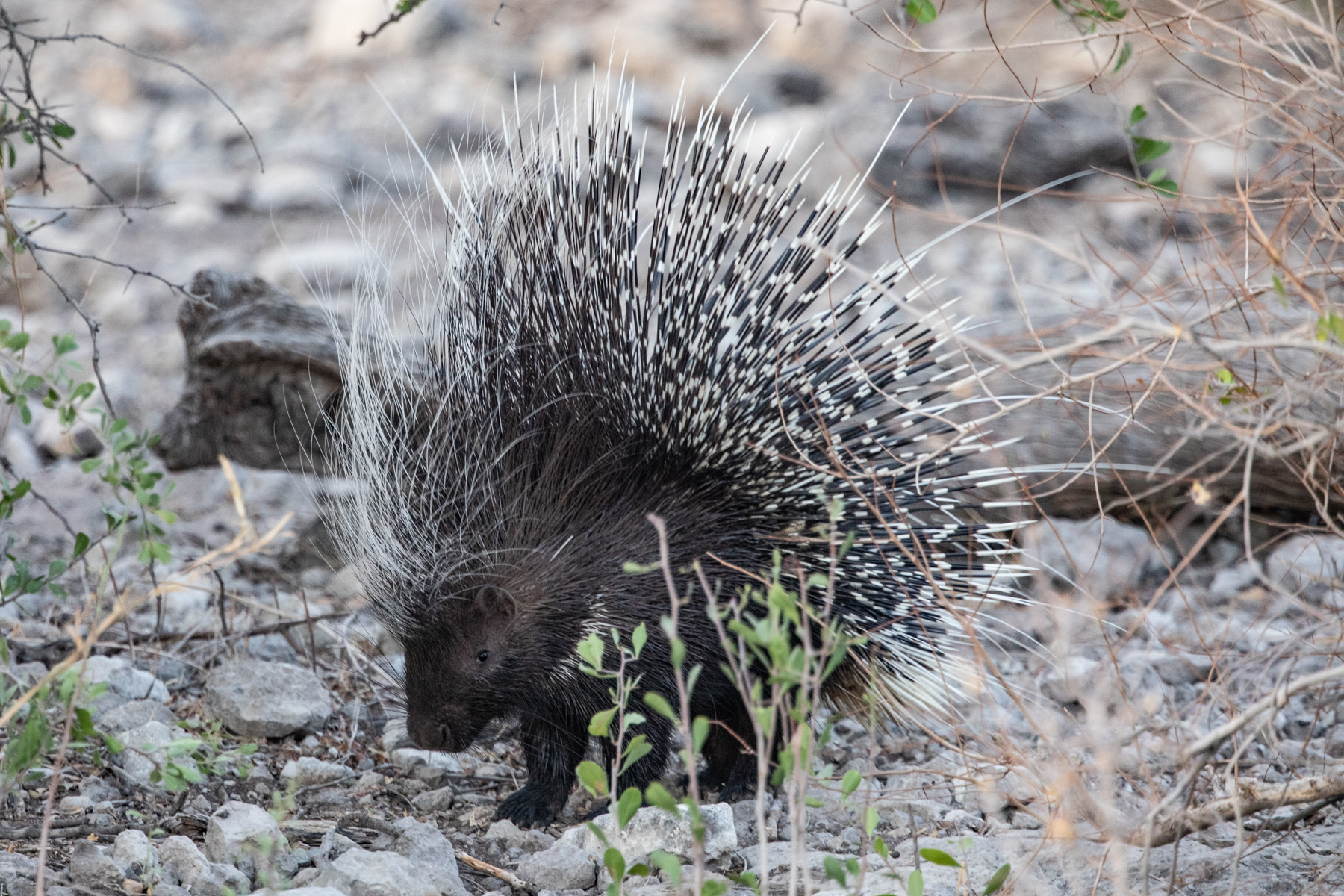
A rare sighting of a Porcupine in Etosha close to sunset. He even drummed his quills to display near the guests on our tour! (image by Inger Vandyke)

Photographing zebras next to a giraffe is a wonderful way to gauge exactly how tall a giraffe is! (Image by Inger Vandyke)
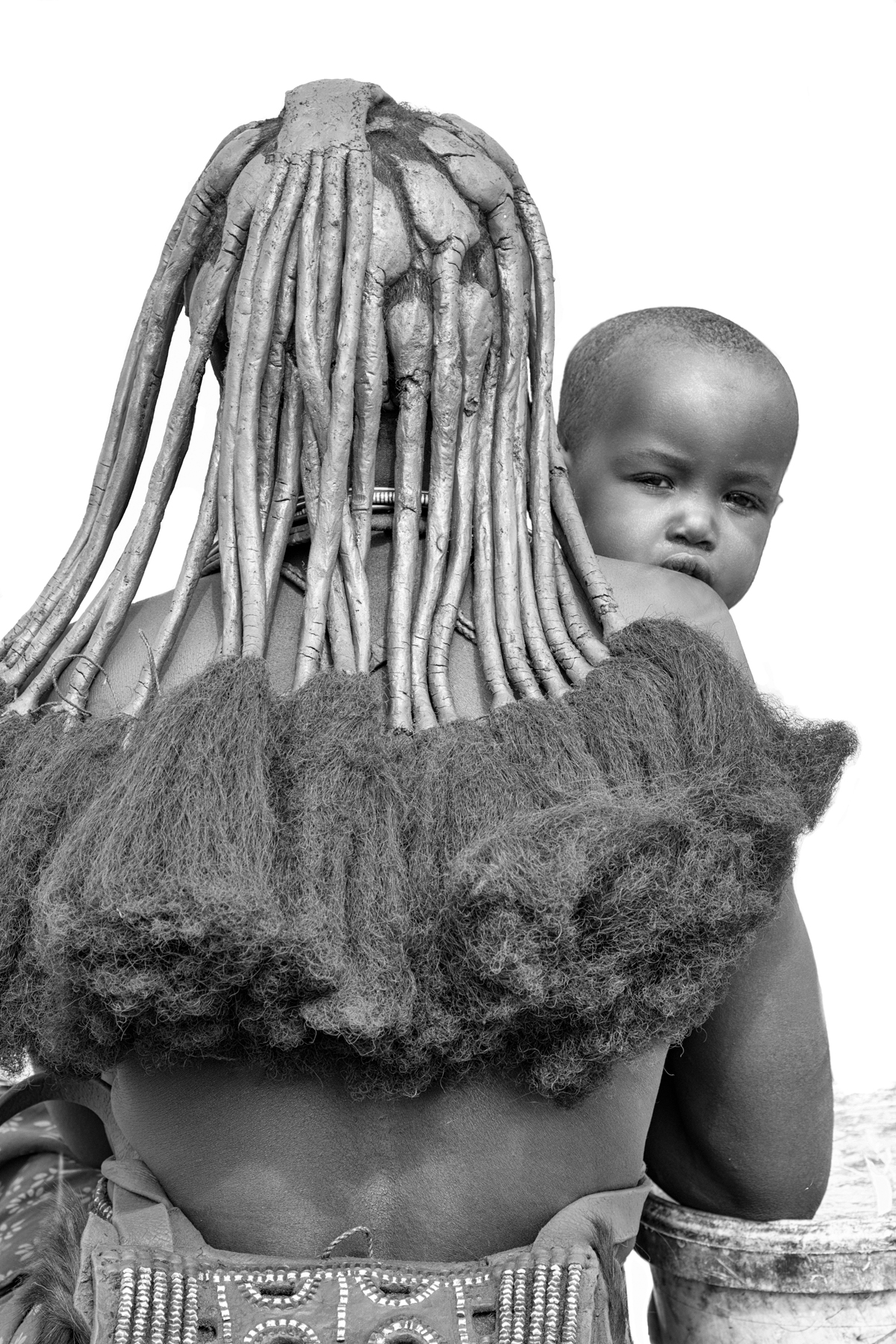
Himba children grow surrounded by so much beauty (image by Inger Vandyke)

The starkly beautiful landscapes of Kaokoland in northern Namibia. This was very close to the border between Namibia and Angola (Image by Inger Vandyke)
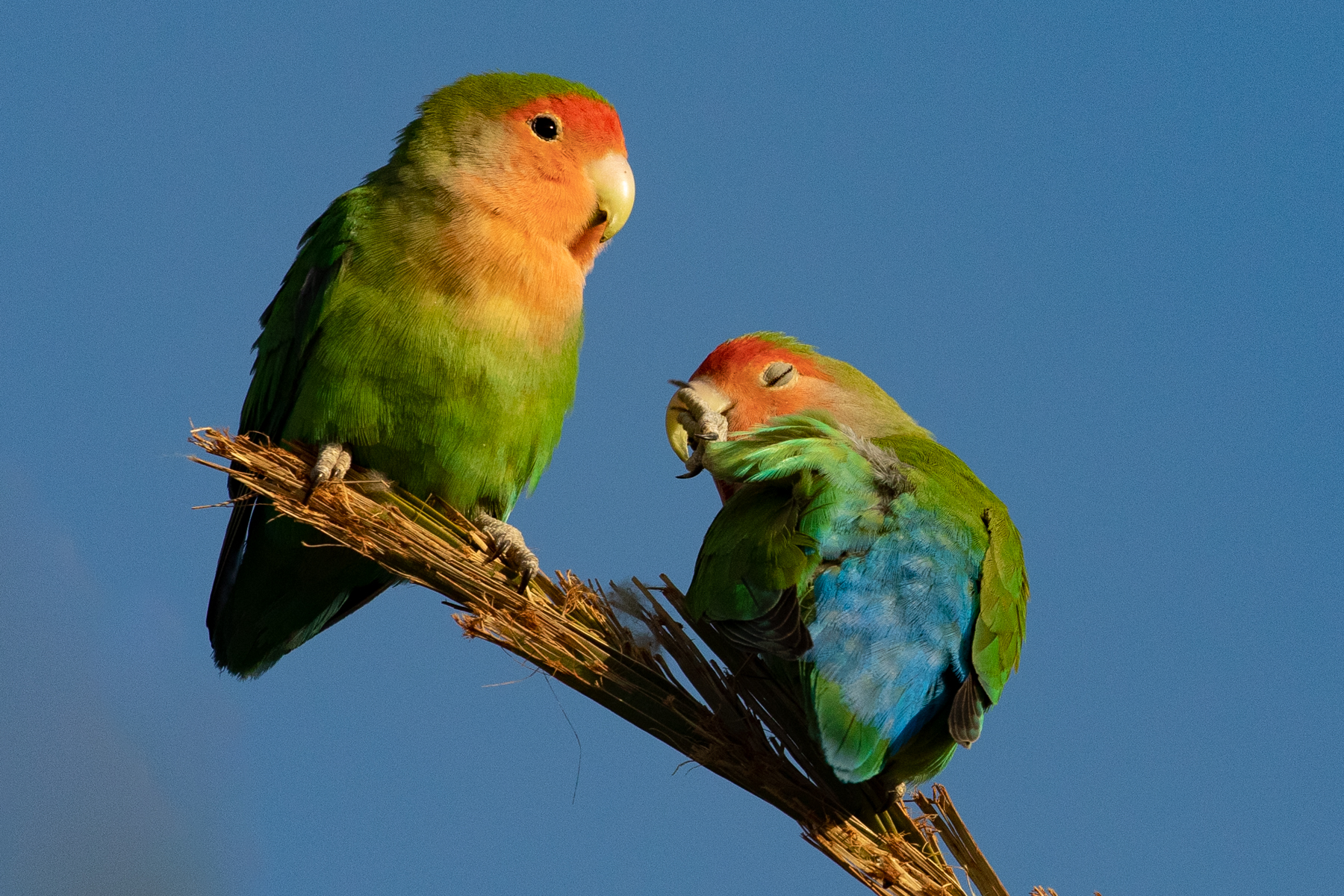
A pair of Rosy-faced Lovebirds enjoy the early morning sun at the Quiver Tree Forest (Image by Inger Vandyke)
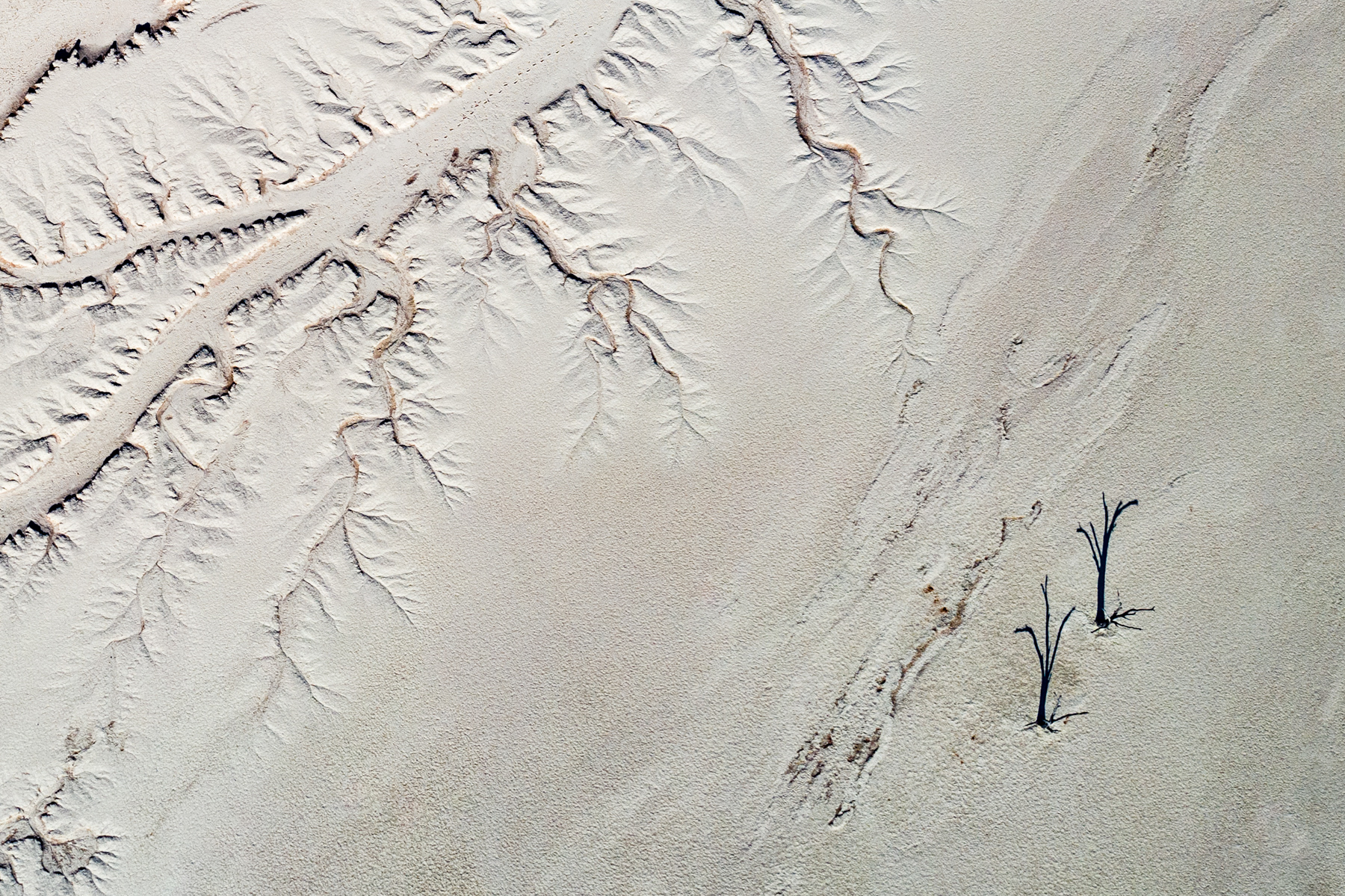
The unbearable lightness of trees (image by Inger Vandyke)

A young Etosha elephant dustbathing at the waterhole in Okaukuejo (Image by Inger Vandyke)

When you find an unexpected macro shot in Porcupine quills (Image by Inger Vandyke)

Desert Elephants and Oryx (Image by Inger Vandyke)

Portrait of a Cape Fur Seal (Image by Inger Vandyke)

Giraffes in the Hoarasib ephemeral riverbed (Image by Inger Vandyke)

Is it playtime yet? Young lions in Etosha embrace after a drink (Image by Inger Vandyke)

Welwitschia in the beautiful concession of Torra (Image by Inger Vandyke)

A beautiful solo Acacia Tree at Salvadora waterhole in Etosha (Image by Inger Vandyke)

The Charitsaub lion pride takes a rest in the rushes for the afternoon but there's always playtime for cubs (Image by Inger Vandyke)

Portrait of a beautiful Zemba girl in Kamanjab (Image by Inger Vandyke)
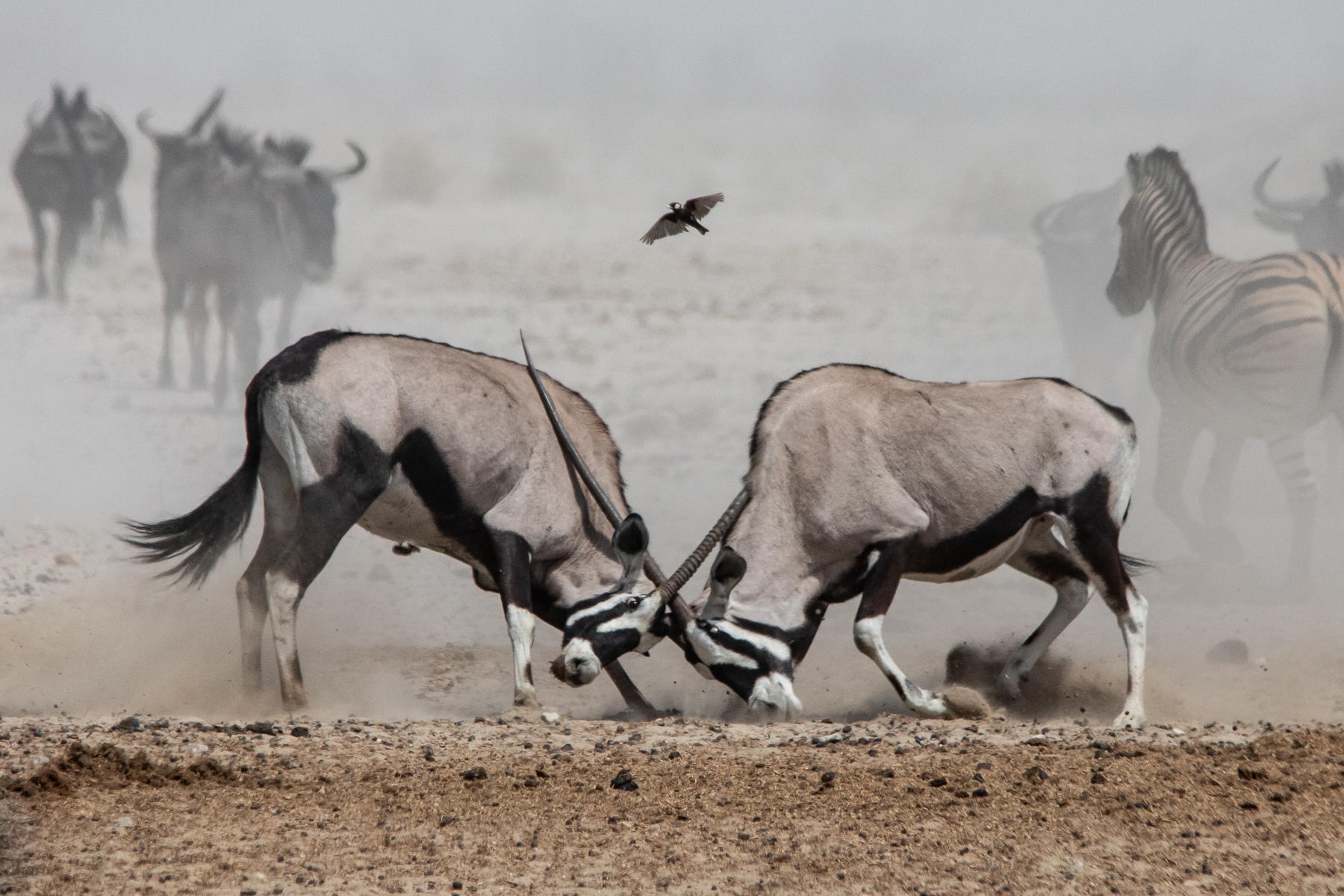
When activity at a waterhole gets tough, the tough Oryx get going. Even the birds get scared! (Image by Inger Vandyke)

Tjiintje with her new baby in Kaokoland (Image by Inger Vandyke)
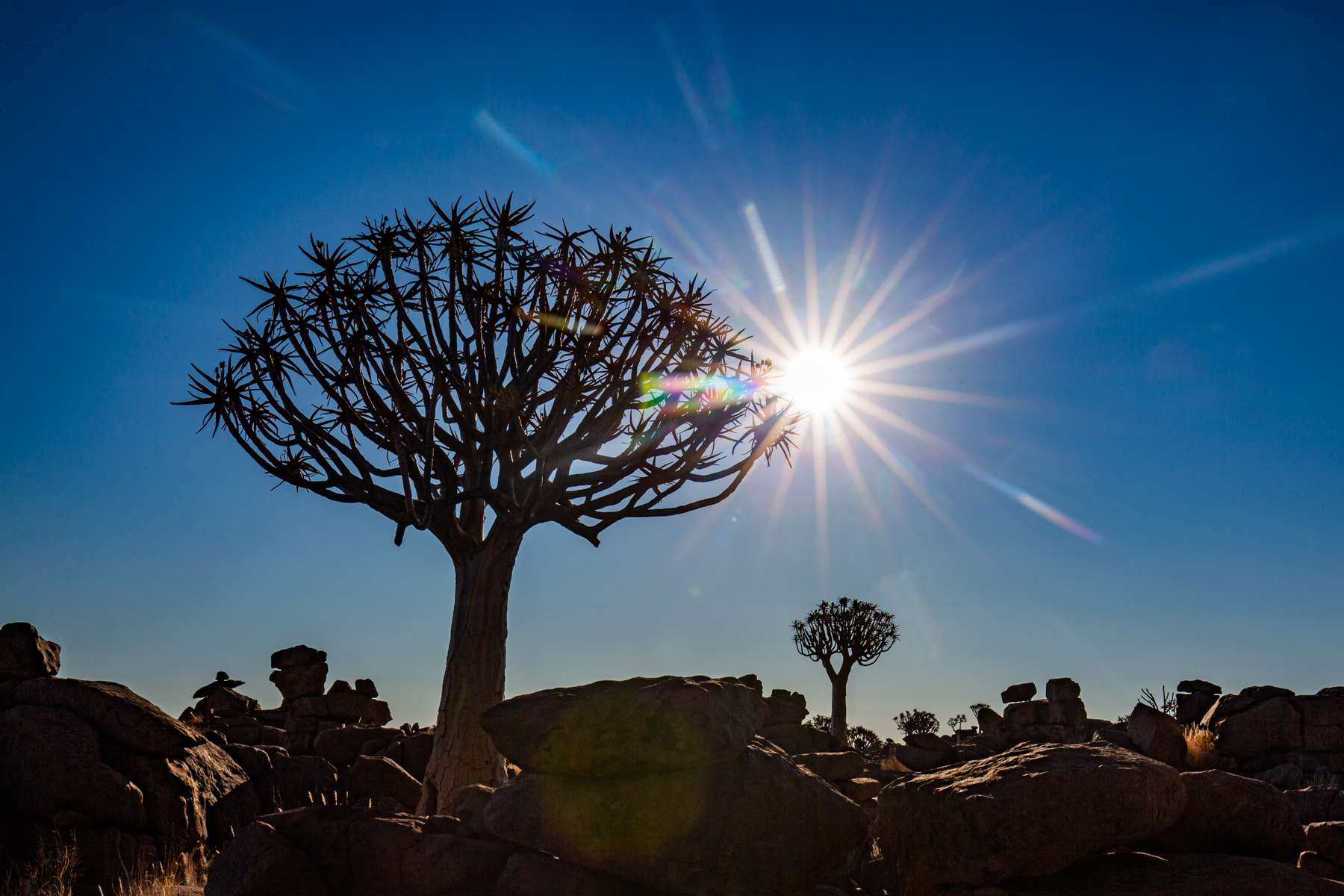
Quiver Tree sun burst (Image by Inger Vandyke)

Zebras have such a passive aggressive attitude towards each other! (Image by Inger Vandyke)

Who are you looking at? An early morning Meerkat in the Kalahari (Image by Inger Vandyke)

A Fitzsimmons Burrowing Skink in Dorrob National Park (Image by Inger Vandyke)

A close up of our favourite old male elephant on the trip (Image by Inger Vandyke)

Himbas holding hands (Image by Inger Vandyke)

The newest member of headman Uapenga's family (Image by Inger Vandyke)

Random Oryx wandering through a herd of Desert Elephants in the Hoanib (Image by Inger Vandyke)

Negative space shot of a resting Springbok in the Kalahari (Image by Inger Vandyke)

Zebra detail (Image by Inger Vandyke)
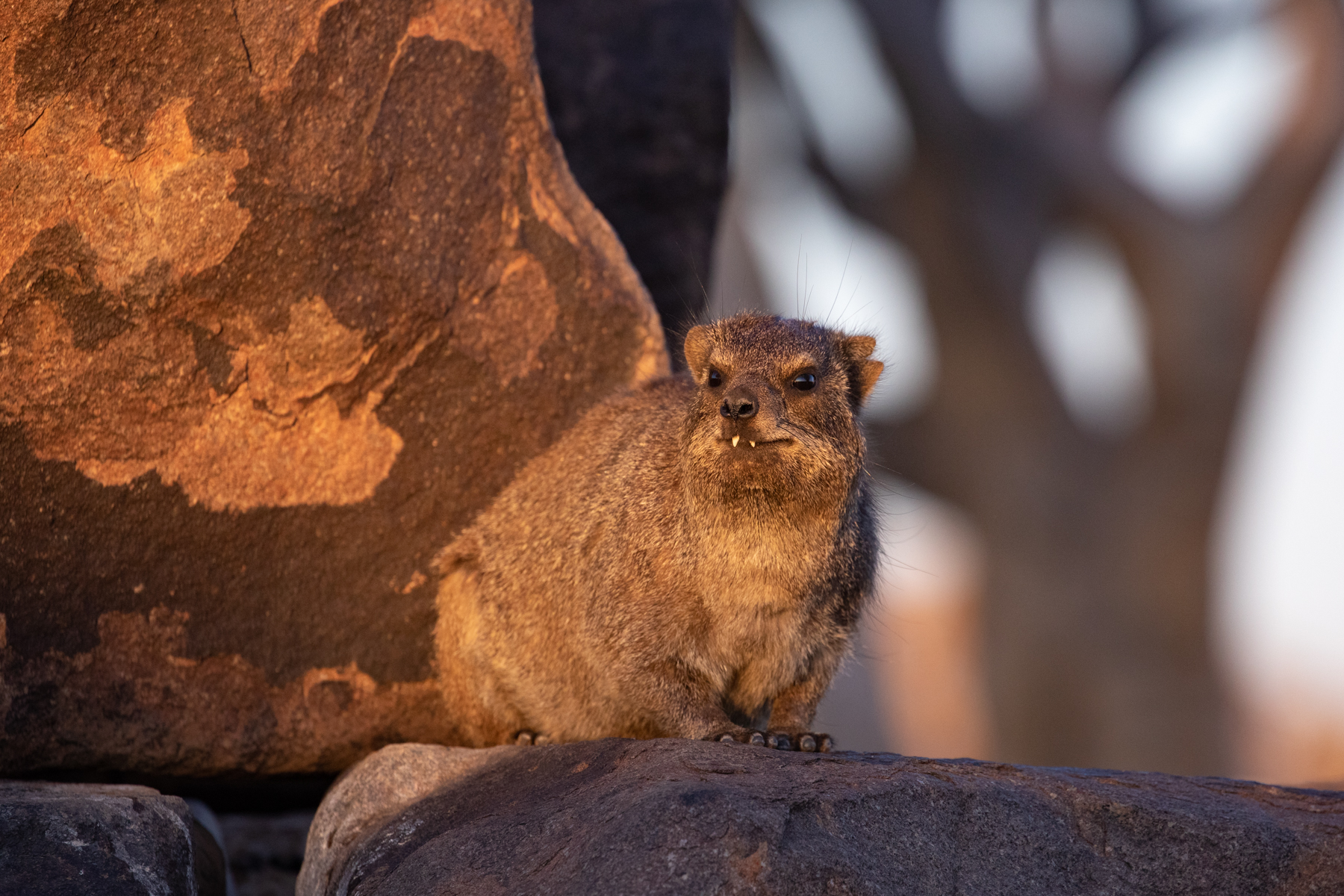
Rock Hyraxes can look quite buck-teethed when they look at you (Image by Inger Vandyke)

Thousands of flamingoes congregate in Dorrob National Park. Their swathes of pink are easily seen from a scenic plane flight (Image by Inger Vandyke)

"When you're finished its our turn to take a drink!" Giraffes waiting patiently for their turn at the waterhole (Image by Inger Vandyke)

Displaying Ruppell's Korhaans in remote Kaokoland (Image by Inger Vandyke)

A lioness and her cub rest in the shade after devouring their prey of a young Rhino (Image by Inger Vandyke)
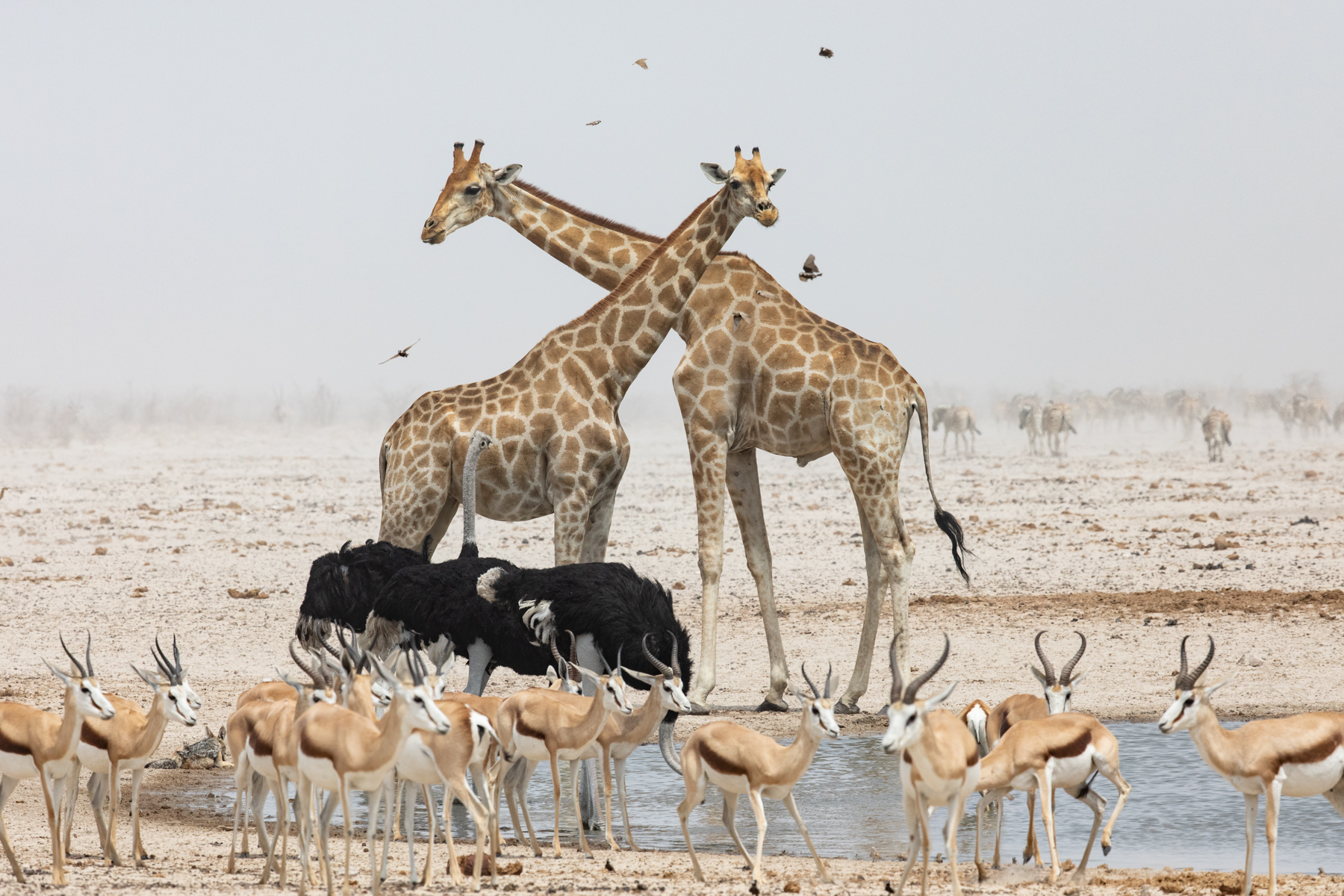
Peak hour at M'bari water hole in Etosha (image by Inger Vandyke)

Just another fantastic waterhole scene in Etosha (Image by Inger Vandyke)
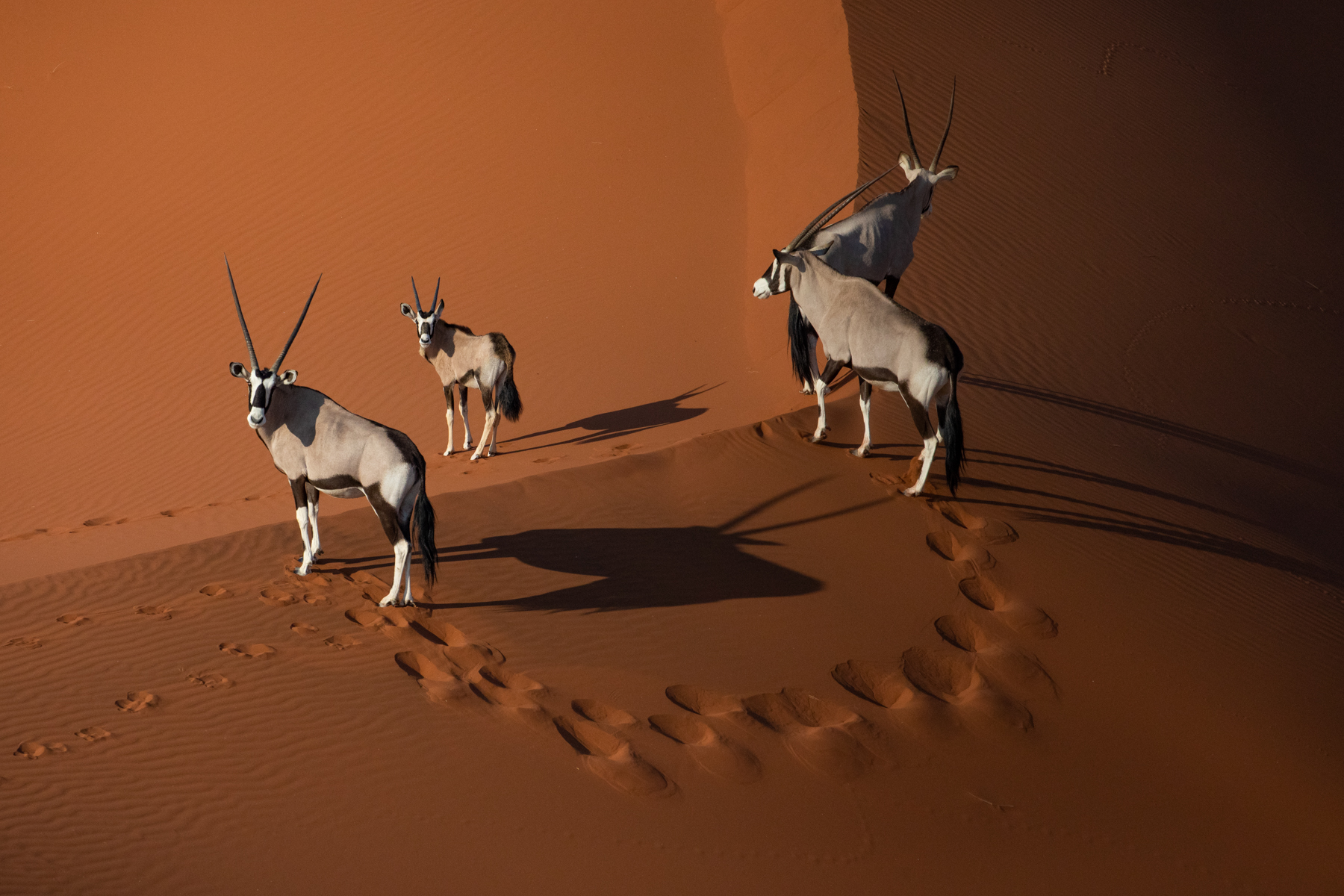
A group of Oryx on the dunes in Sossusvlei taken from our scenic helicopter flight at sunrise (image by Inger Vandyke)

An odd sight of a Black-backed Jackal in the seals at Cape Cross (Image by Inger Vandyke)
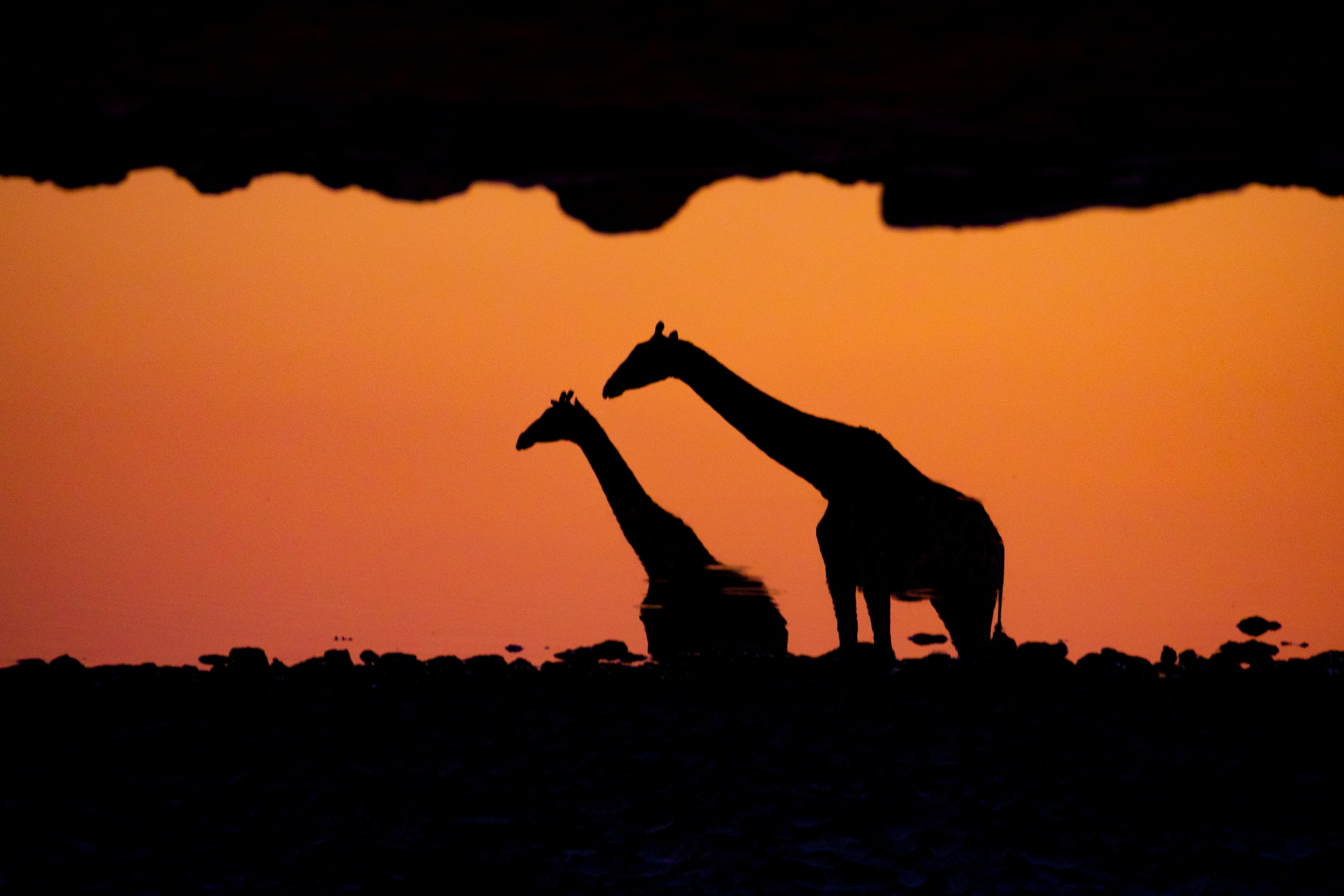
The journey (image by Inger Vandyke)

A Crowned Lapwing watches us in the Kgalagadi Transfrontier Reserve (Image by Inger Vandyke)
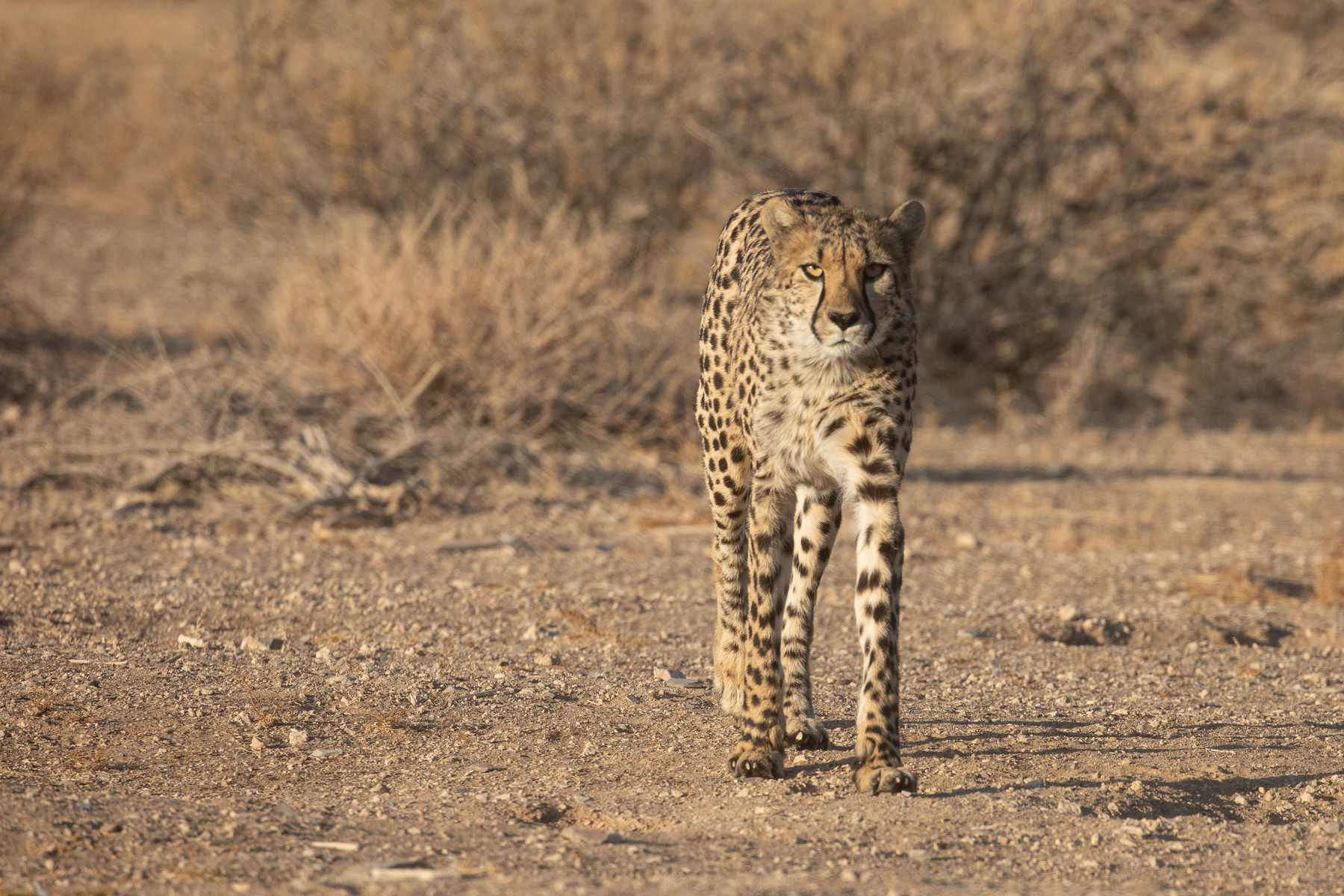
A Cheetah ambles towards us (image by Inger Vandyke)

Pigeon pair of giraffes in Etosha (Image by Inger Vandyke)

Portrait of a lioness who is part of the Charitsaub pride in Etosha (Image by Inger Vandyke)
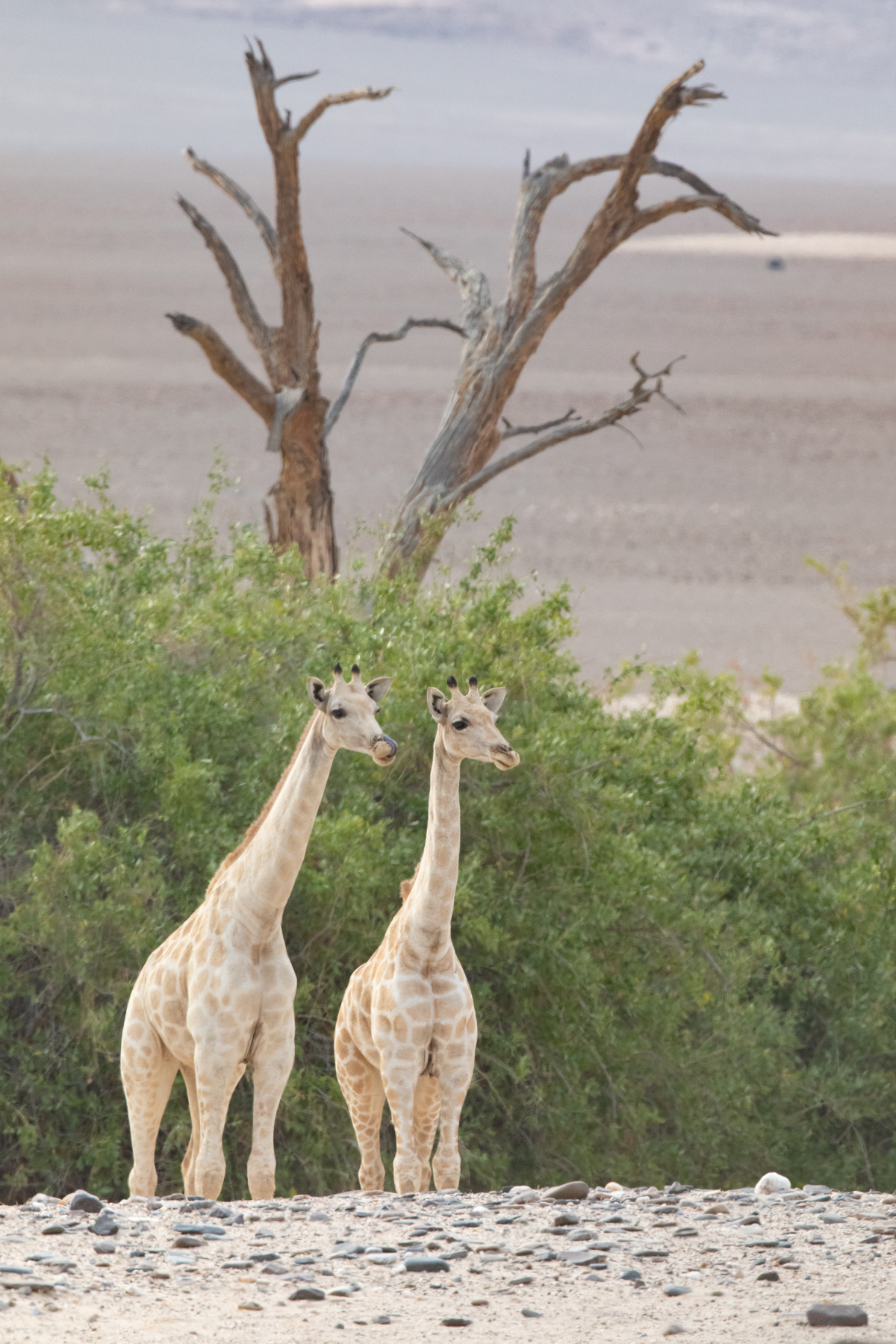
Giraffes imitating trees in the Hoarasib ephemeral river (image by Inger Vandyke)
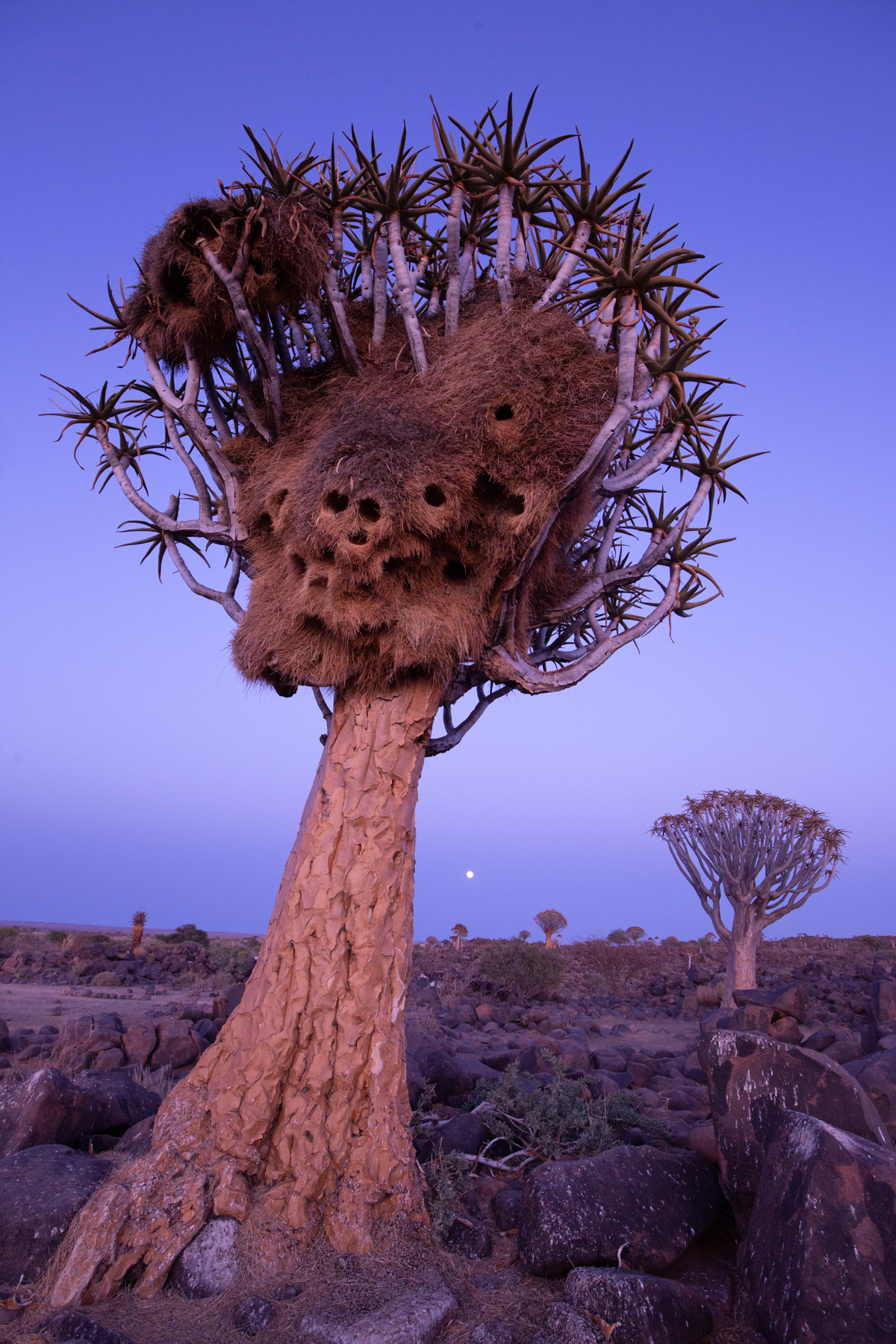
Quiver Trees in blue hour (image by Inger Vandyke)

A little Himba boy awkwardly holds his puppy (Image by Inger Vandyke)

Drone's eye view of Puzurira and her little brother taking their goats to water at a well in Kaokoland (Image by Inger Vandyke)

The newest edition to the Hoanib herd of Desert Elephants (Image by Inger Vandyke)

Desert Roses at Sesriem (Image by Inger Vandyke)
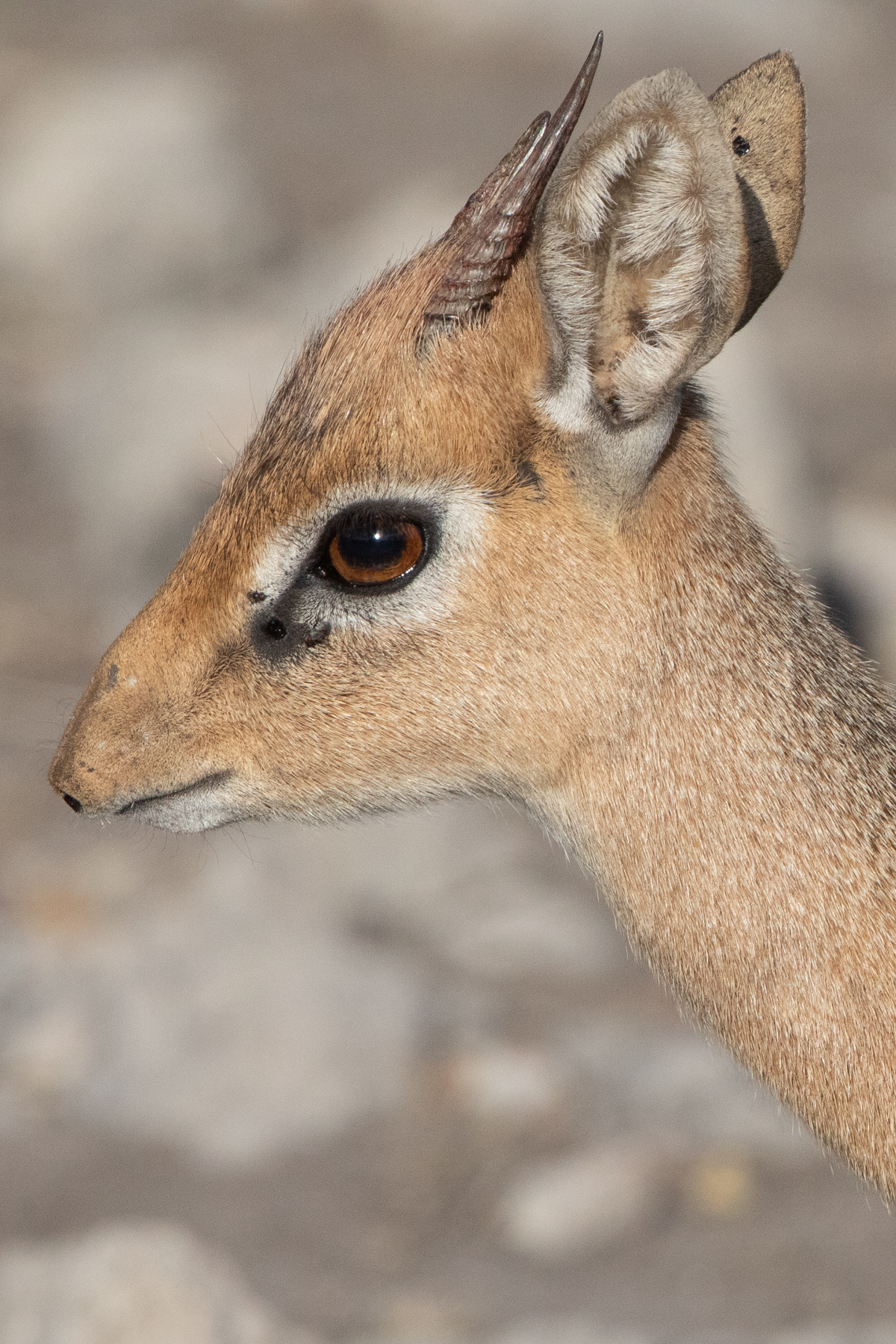
Portrait of a Damara Dik Dik in Etosha (image by Inger Vandyke)
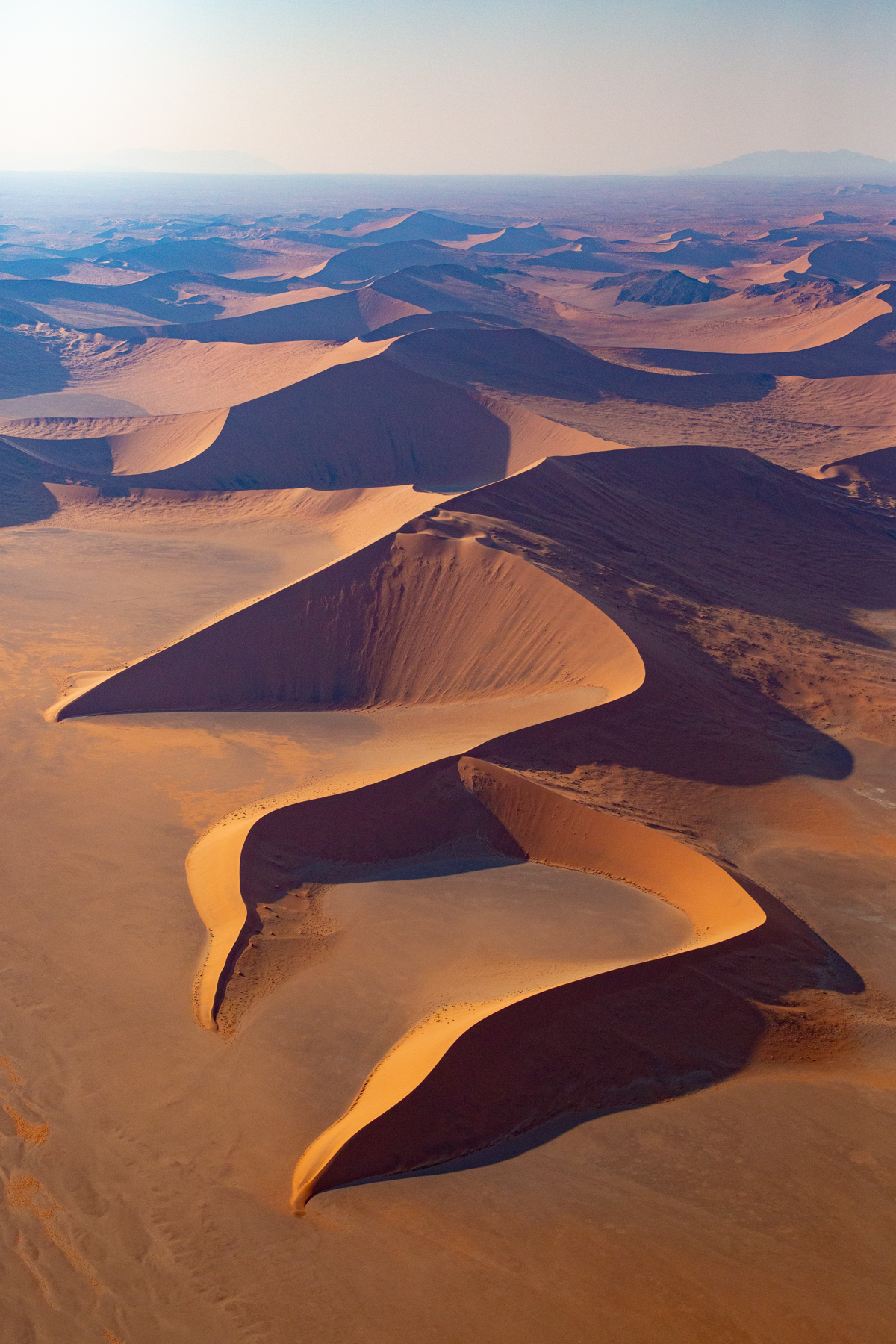
The iconic Devil's Fork in Sossusvlei (image by Inger Vandyke)

"Hey! This waterhole is MINE! Stay away!" A young Desert Elephant guards his waterhole from an Oryx (Image by Inger Vandyke)

An aerial view of Sossus Dune Lodge (Image by Inger Vandyke)
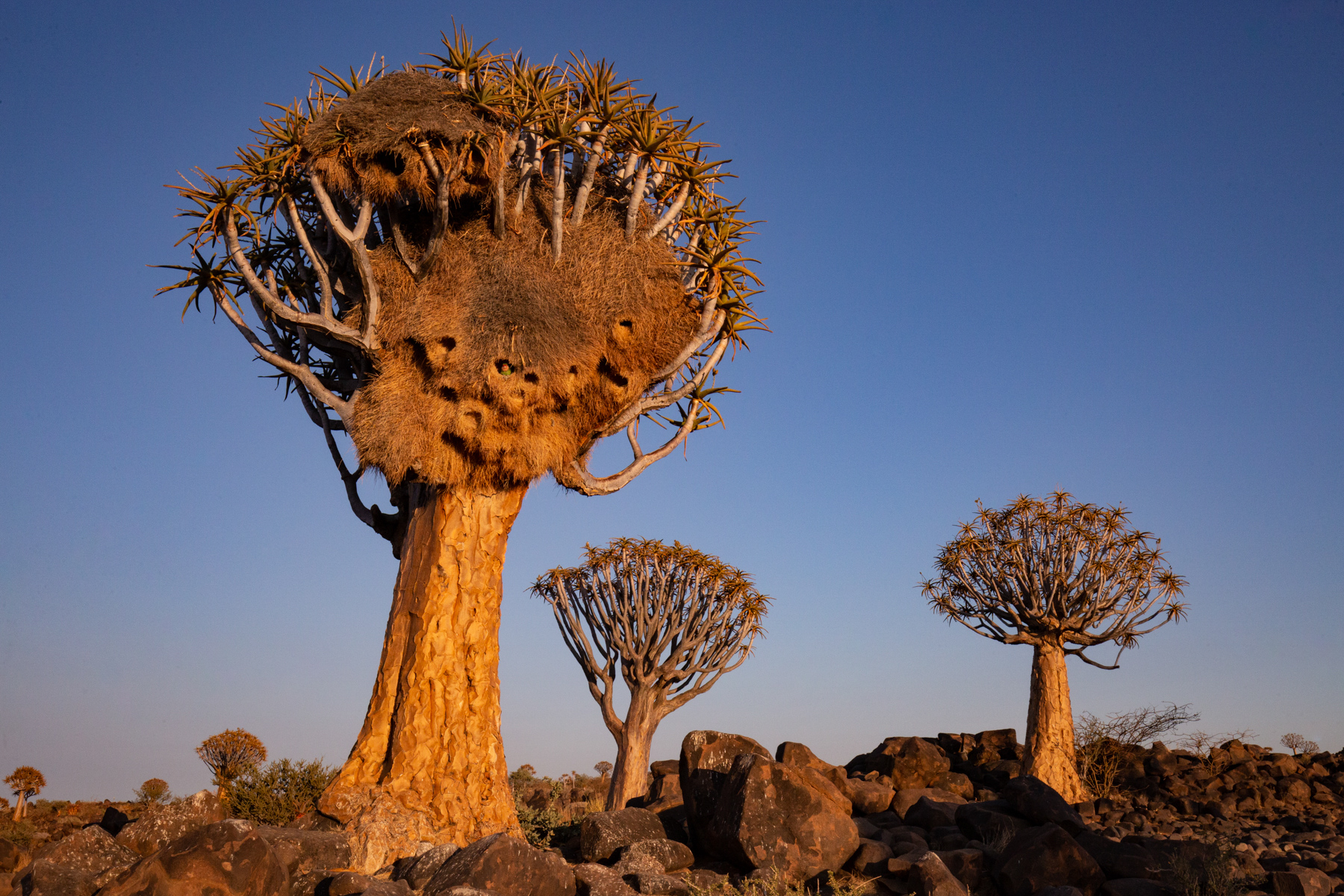
Sociable Weaver nest in a Quiver Tree (image by Inger Vandyke)

Can you ever have too many beautiful sunsets? (Image by Inger Vandyke)

Breathtaking sunset from Etaambura Lodge (Image by Inger Vandyke)
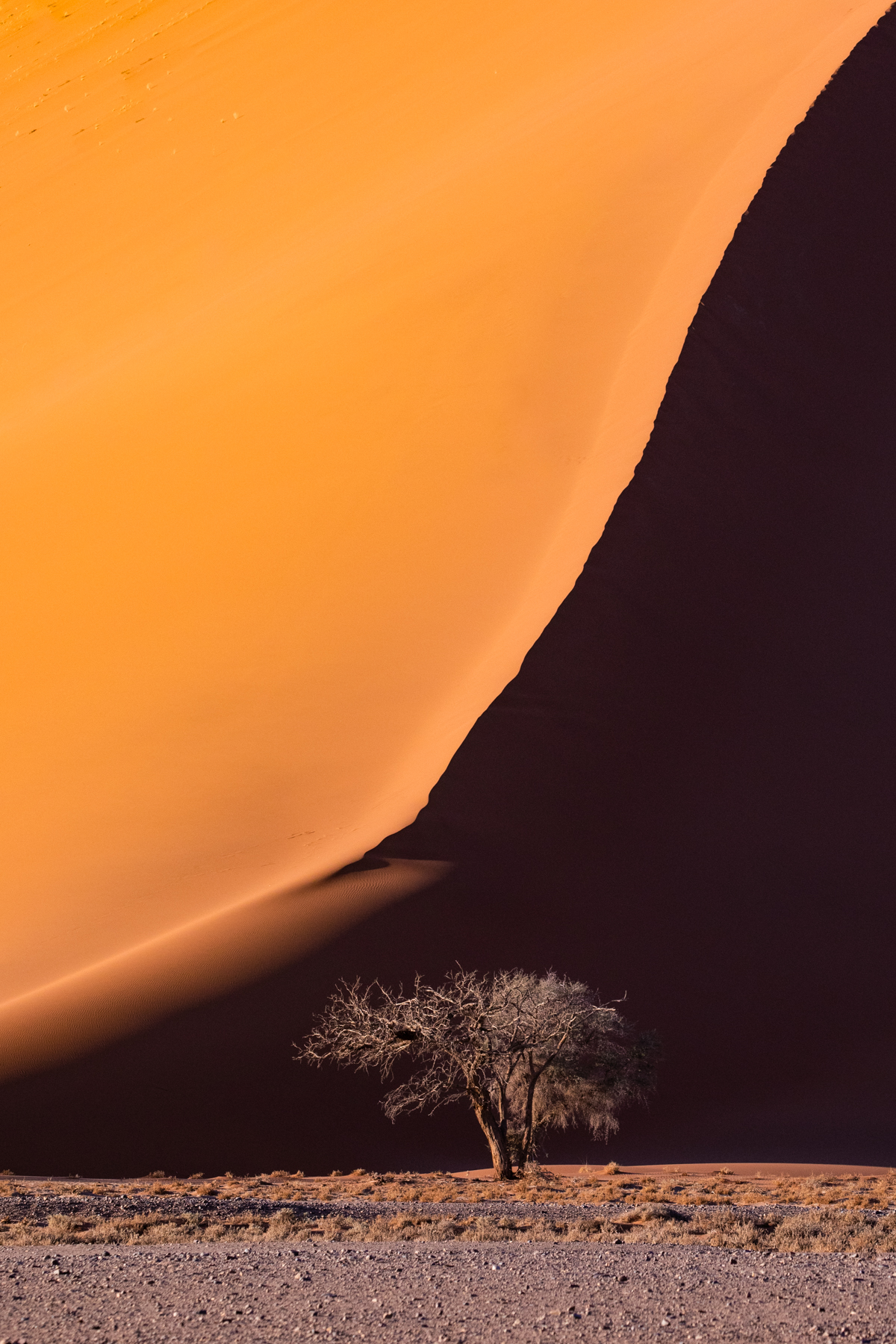
Beauty in simplicity. Sossusvlei at sunrise (image by Inger Vandyke)

Portrait of Elizabeth, a Herero lady in Sesfontein (Image by Inger Vandyke)

The next generation - a cub from the Charitsaub pride (Image by Inger Vandyke)

Kovipiriko - her natural expression is frowning so to capture her warm smile is a wonderful experience (Image by Inger Vandyke)

Quiver Tree in the moonlight (Image by Inger Vandyke)

The remains of a wreck on Namibia's iconic Skeleton Coast (Image by Inger Vandyke)

Flamingos take flight off the coast of Walvis Bay in southern Namibia (Image by Inger Vandyke)

Nesting Cape Sparrows at the small aircraft terminal in Walvis Bay (Image by Inger Vandyke)

Looking into the eye of an elephant in Etosha (Image by Inger Vandyke)
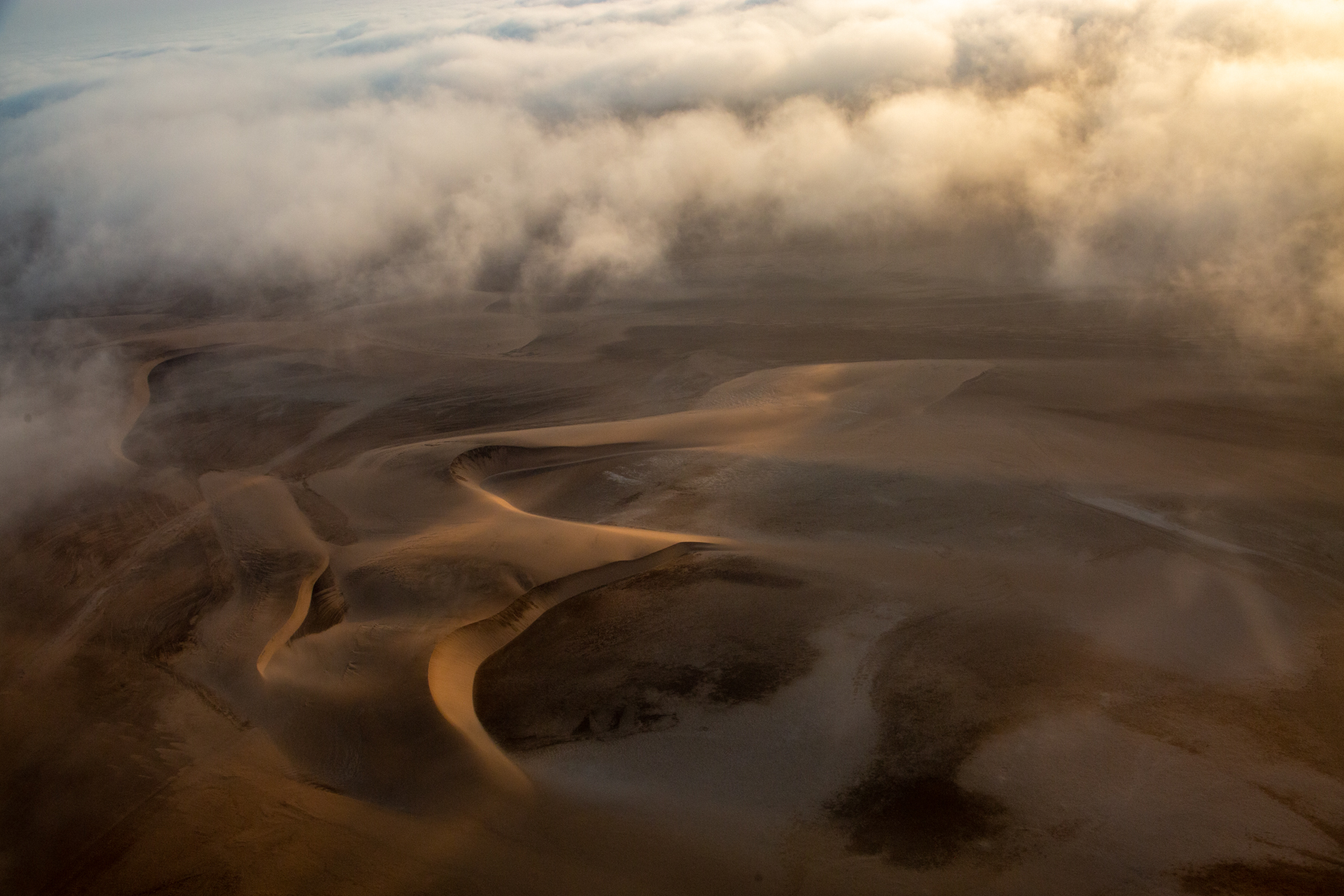
Sun shines through the encroaching fog over the Skeleton Coast in Namibia (image by Inger Vandyke)
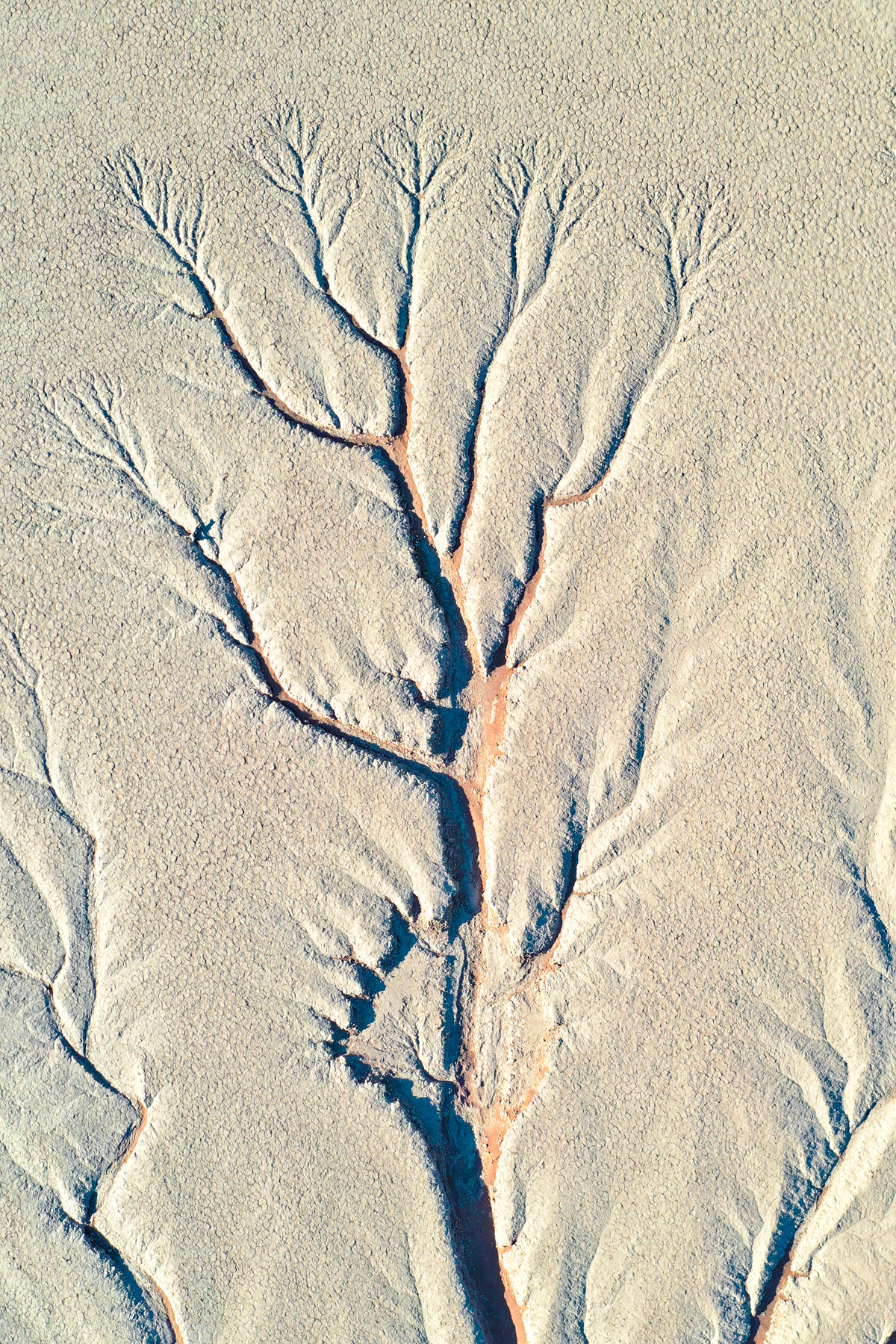
Deadvlei aerial detail shows ancient paths of water through the clay pan (image by Inger Vandyke)

Ngombe and her baby boy at Palmwag Concession (Image by Inger Vandyke)
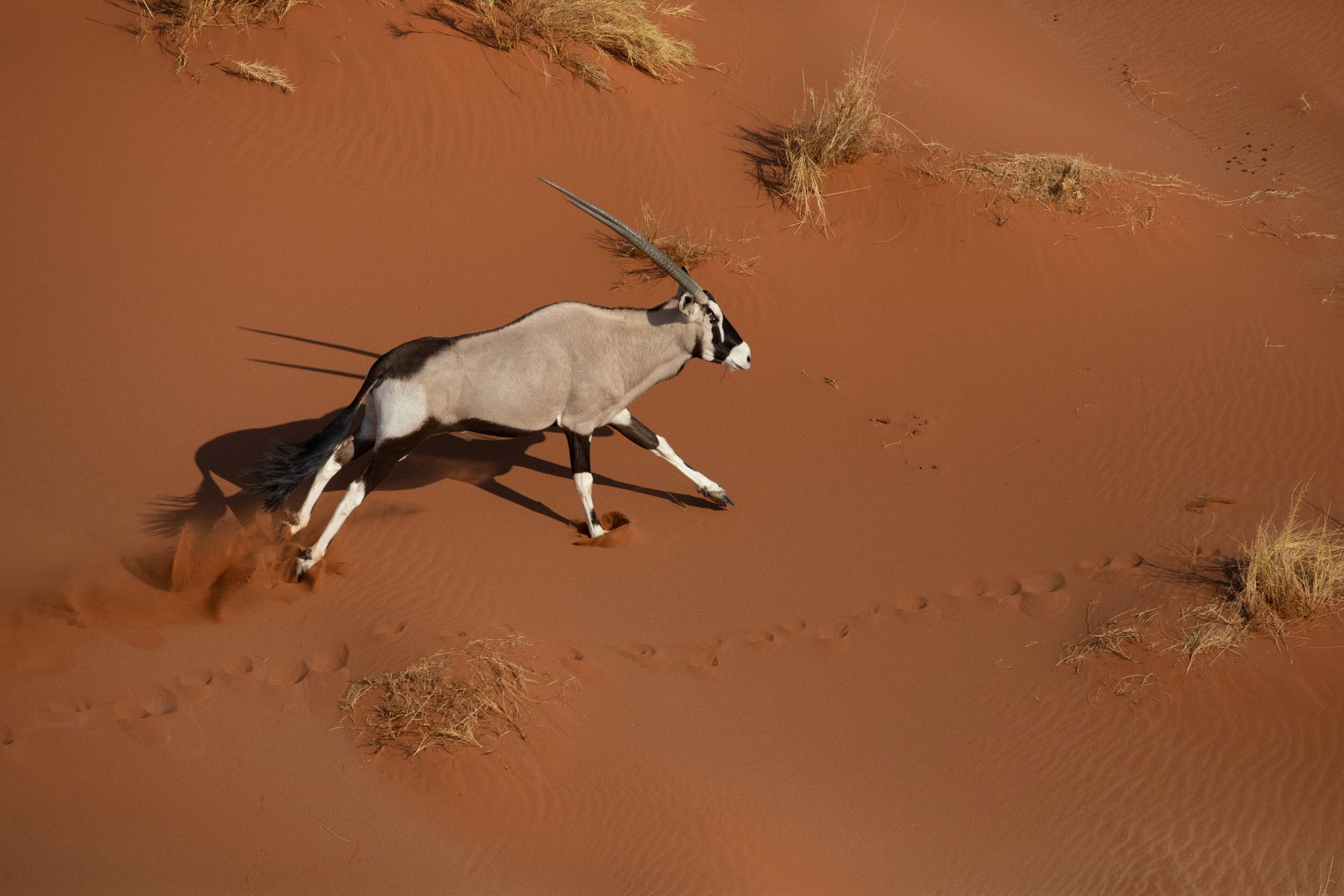
Aerial shot of an Oryx running through the dunes at Sossusvlei (Image by Inger Vandyke)
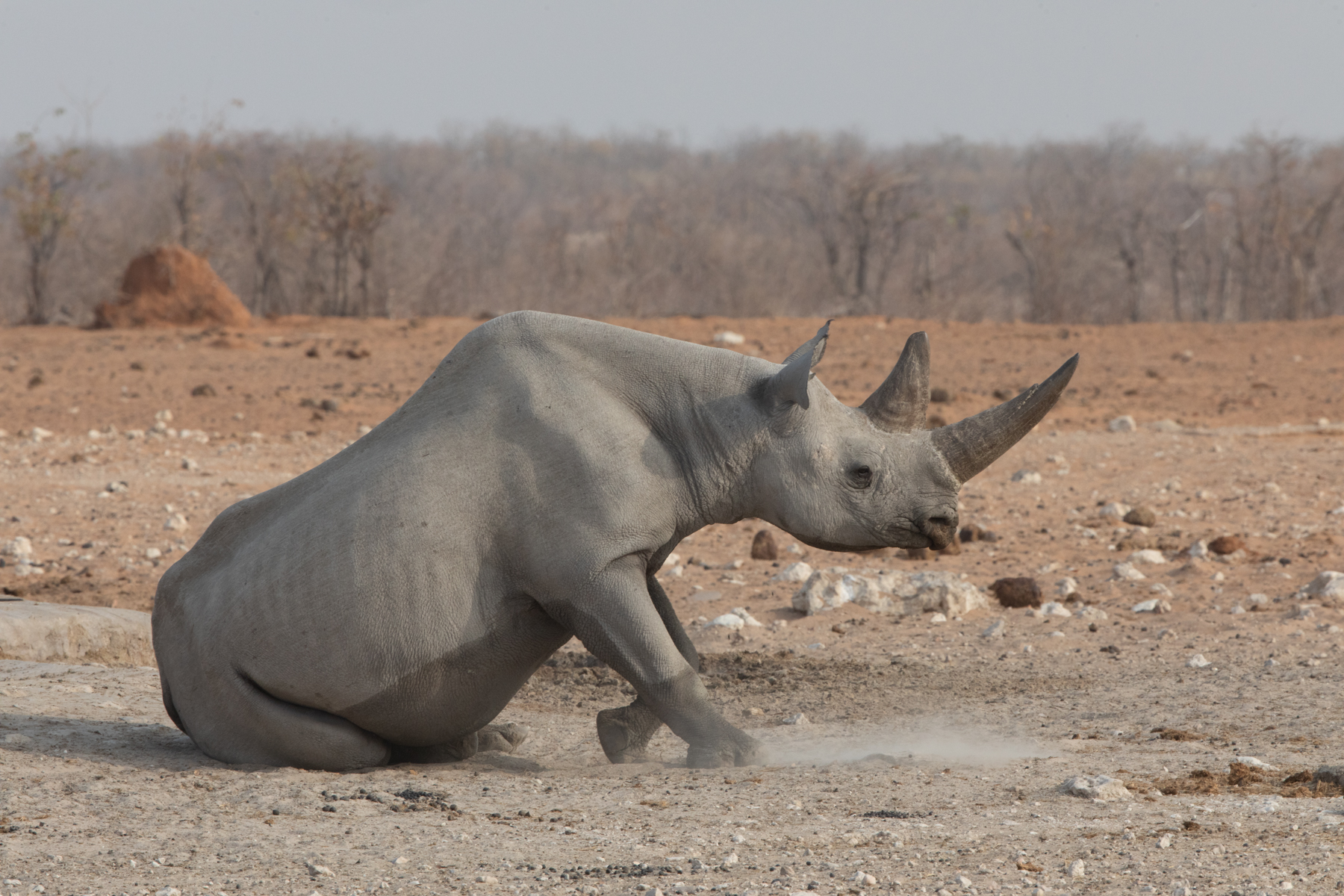
An elderly Black Rhino male in the western end of Etosha (image by Inger Vandyke)
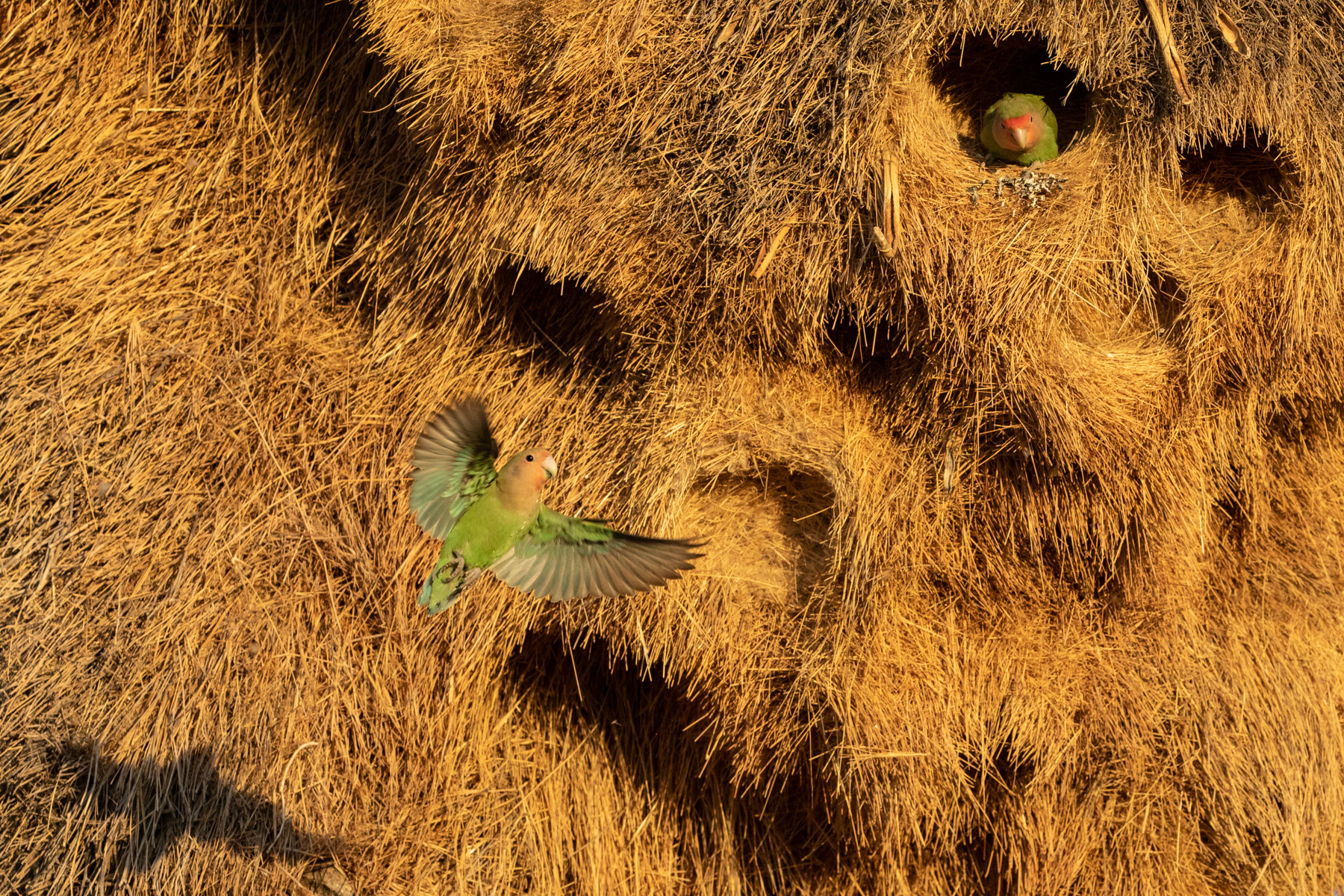
A colony of Rosy-faced Lovebirds using the nests of Sociable Weavers in the Quiver Tree Forest (image by Inger Vandyke)

The flamingoes of Walvis Bay. There's nowhere else on earth you can get shots like this of them against the dunes (Image by Inger Vandyke)
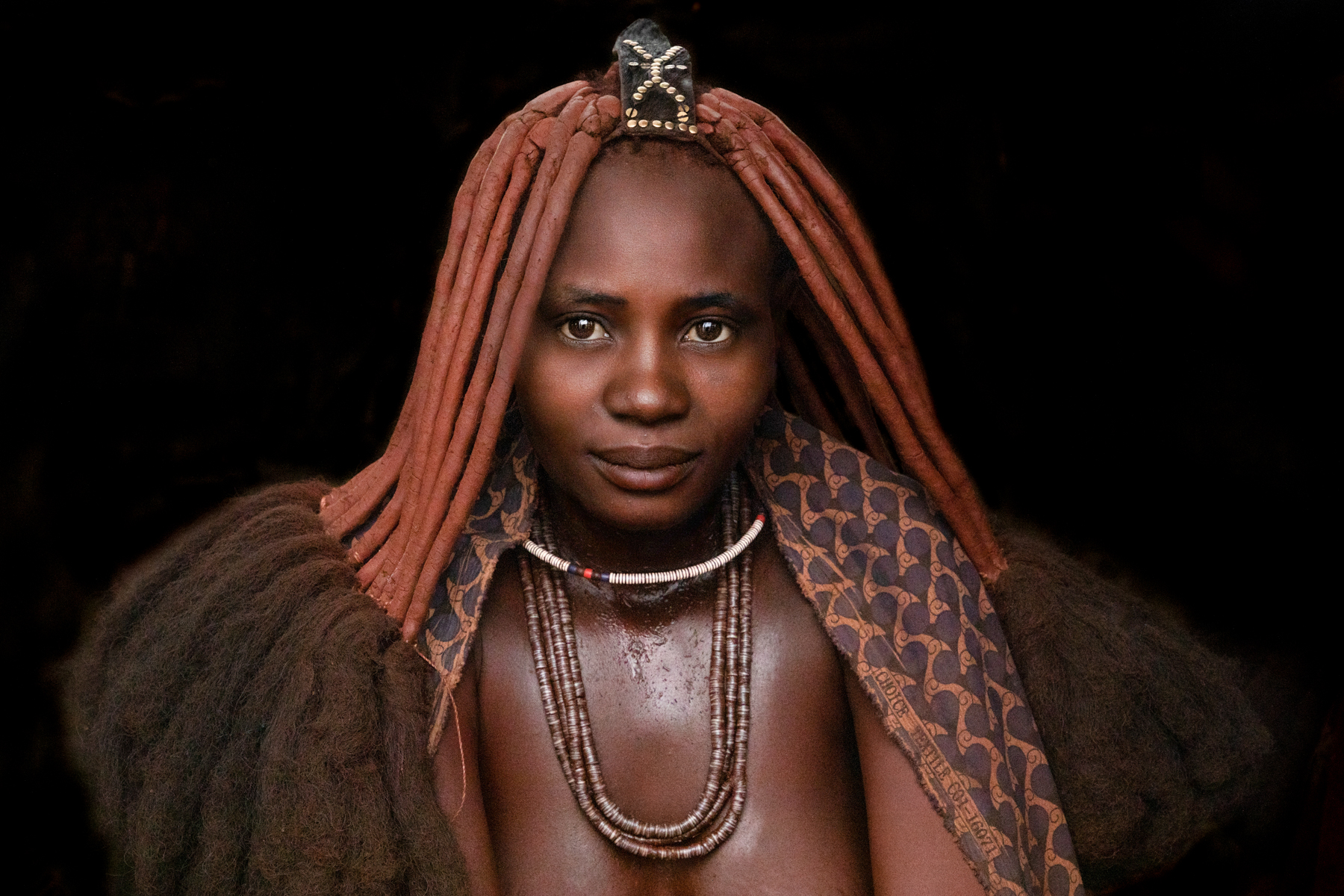
Portrait of a stunningly beautiful Himba girl (image by Inger Vandyke)

One of the Black-backed Jackals who visit the campsite at Nossob each night hoping for treats (Image by Inger Vandyke)

Portrait of a Peringuey's Adder (Image by Inger Vandyke)
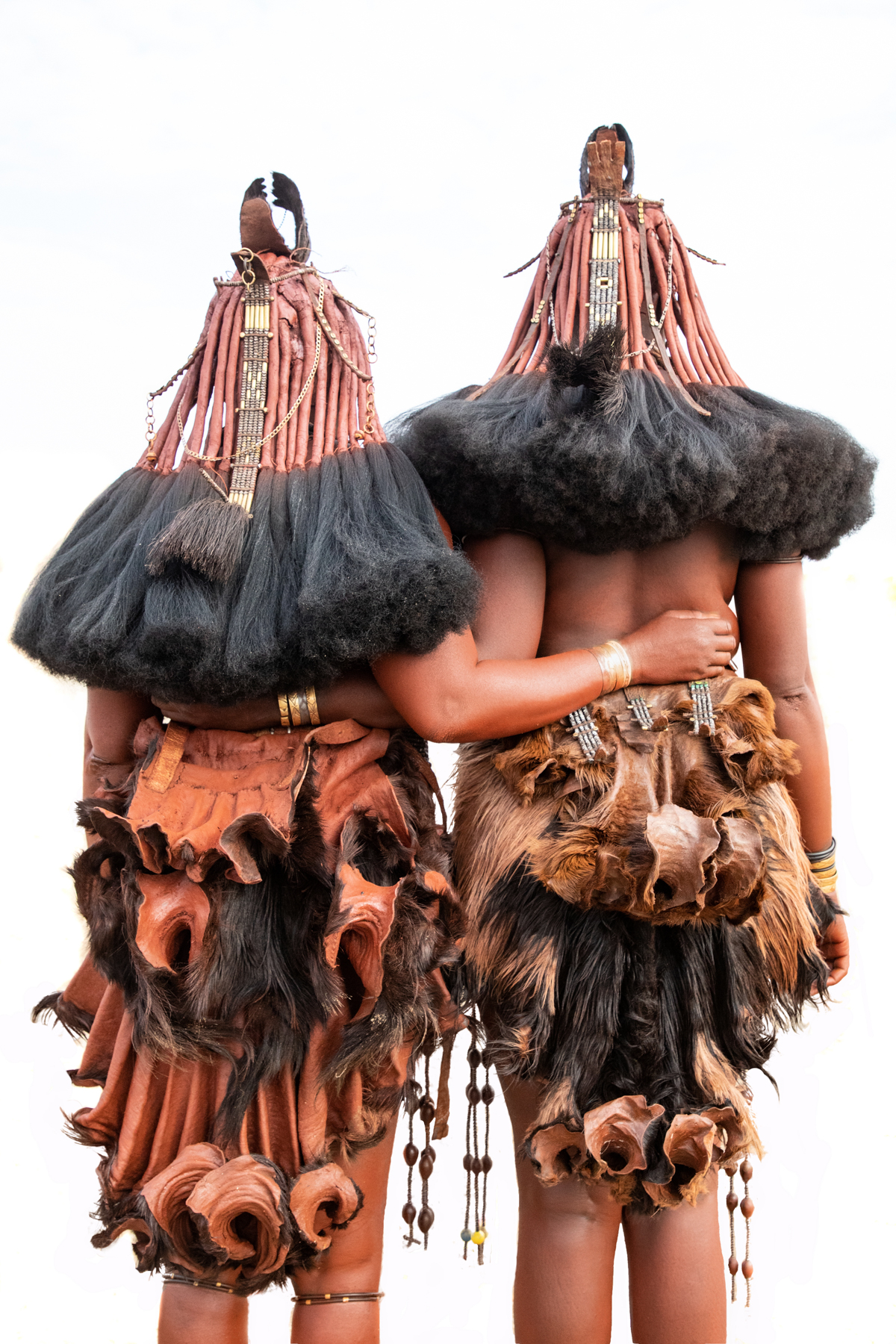
Himba woman are as beautiful from behind as they are from the front (image by Inger Vandyke)

A young lion drags what is left from its Zebra kill (Image by Inger Vandyke)

Oryx running through the desert in the Hoanib River area (Image by Inger Vandyke)

Devil's Fork (Image by Inger Vandyke)
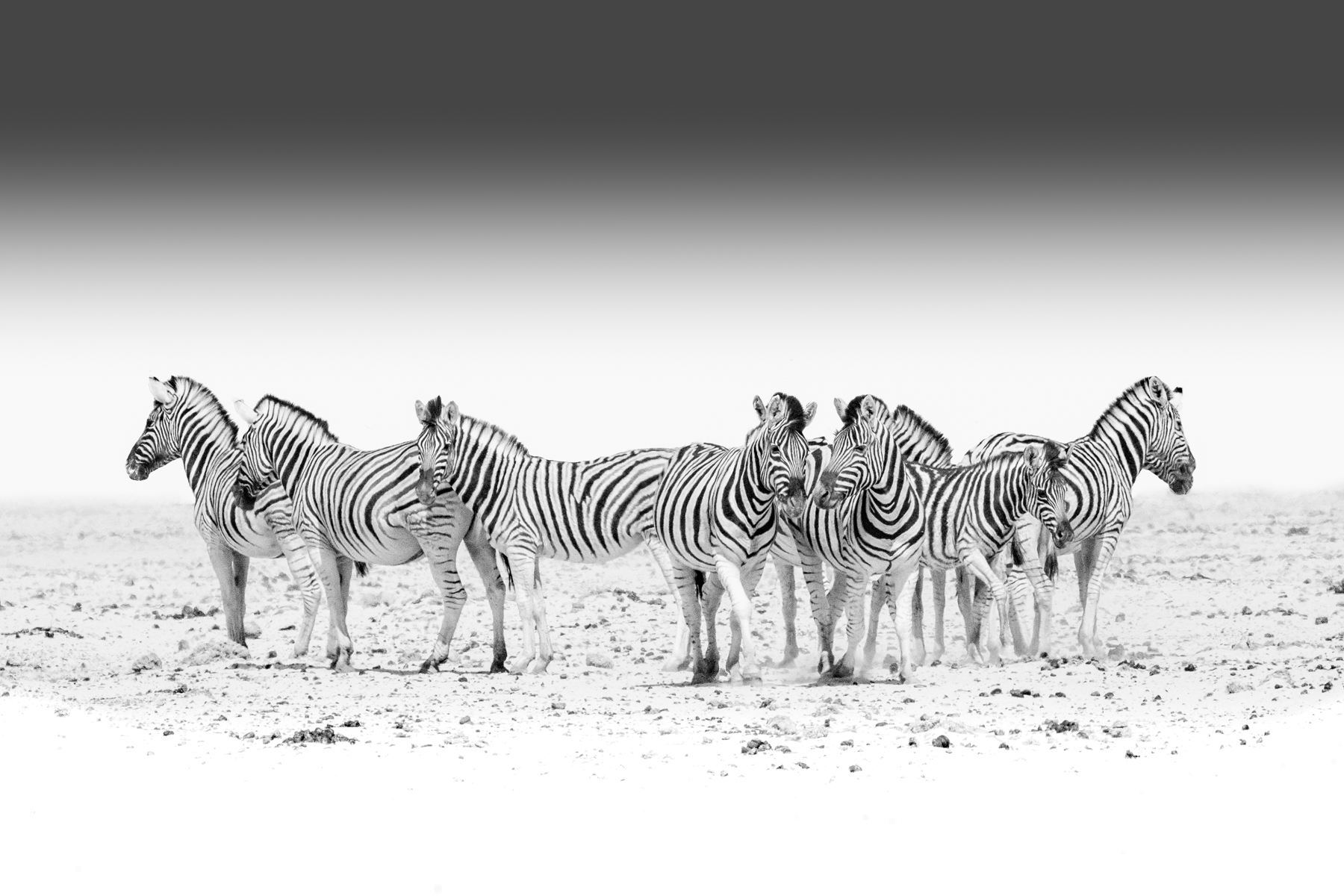
Zebras gather in the dust to wait their turn for a drink at the water hole (image by Inger Vandyke)
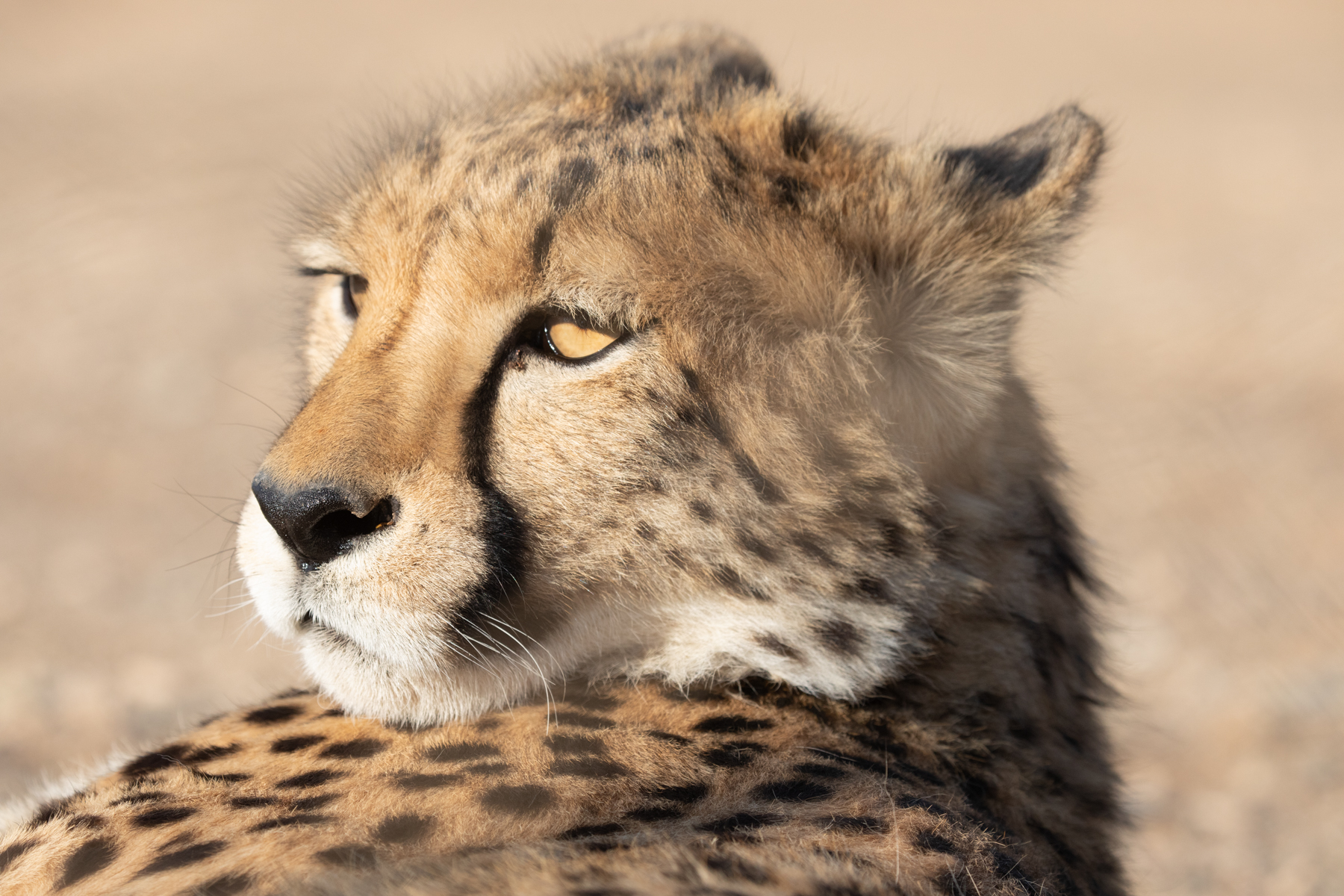
Portrait of a Cheetah (Image by Inger Vandyke)

The wreck of the Zeila is now a popular site for nesting cormorants on the Skeleton Coast (Image by Inger Vandyke)

One of the curious "Lone Men of Kaokoland" sculptures in the desert (Image by Inger Vandyke)
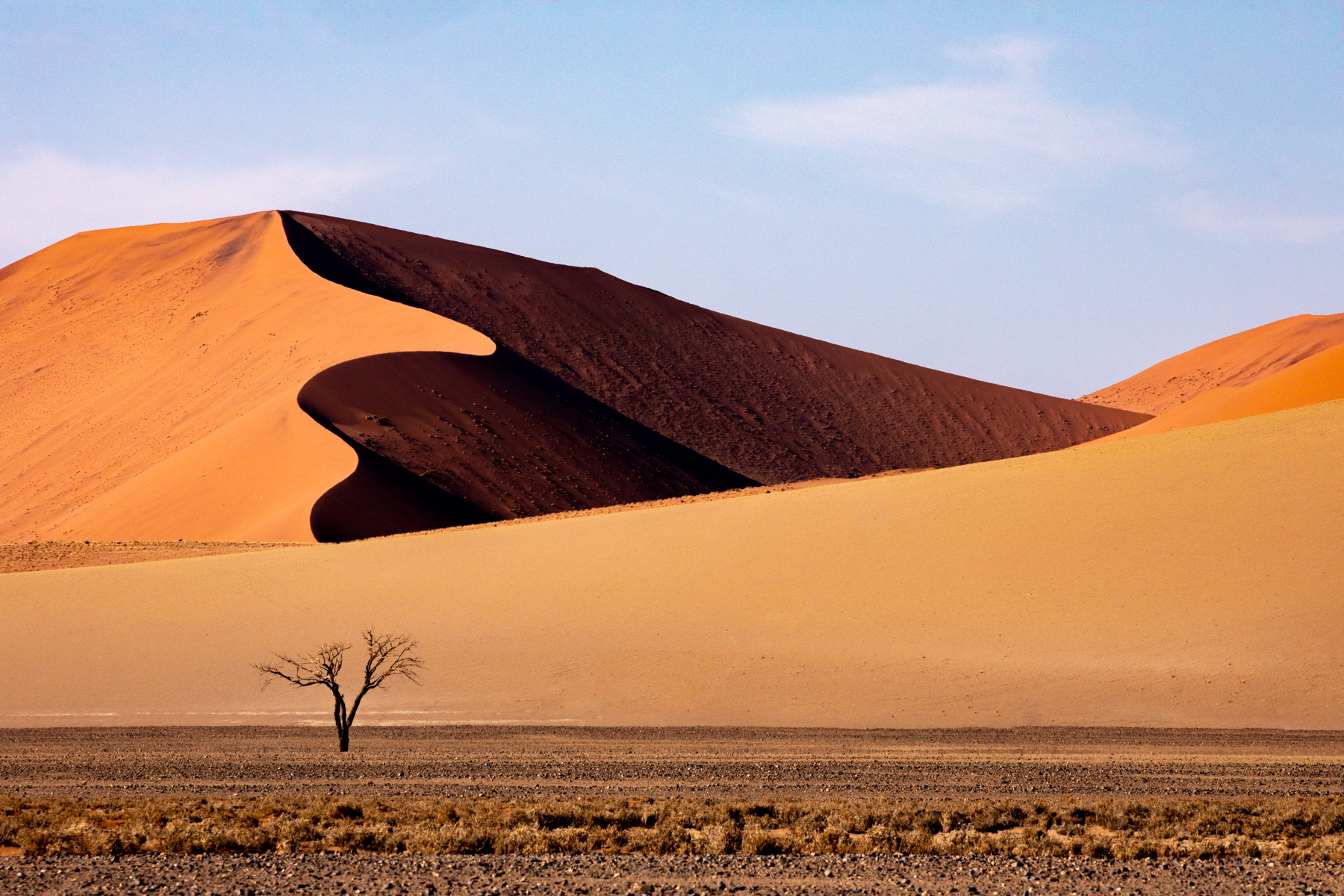
The simple beauty of landscape photography in Sossusvlei (image by Inger Vandyke)
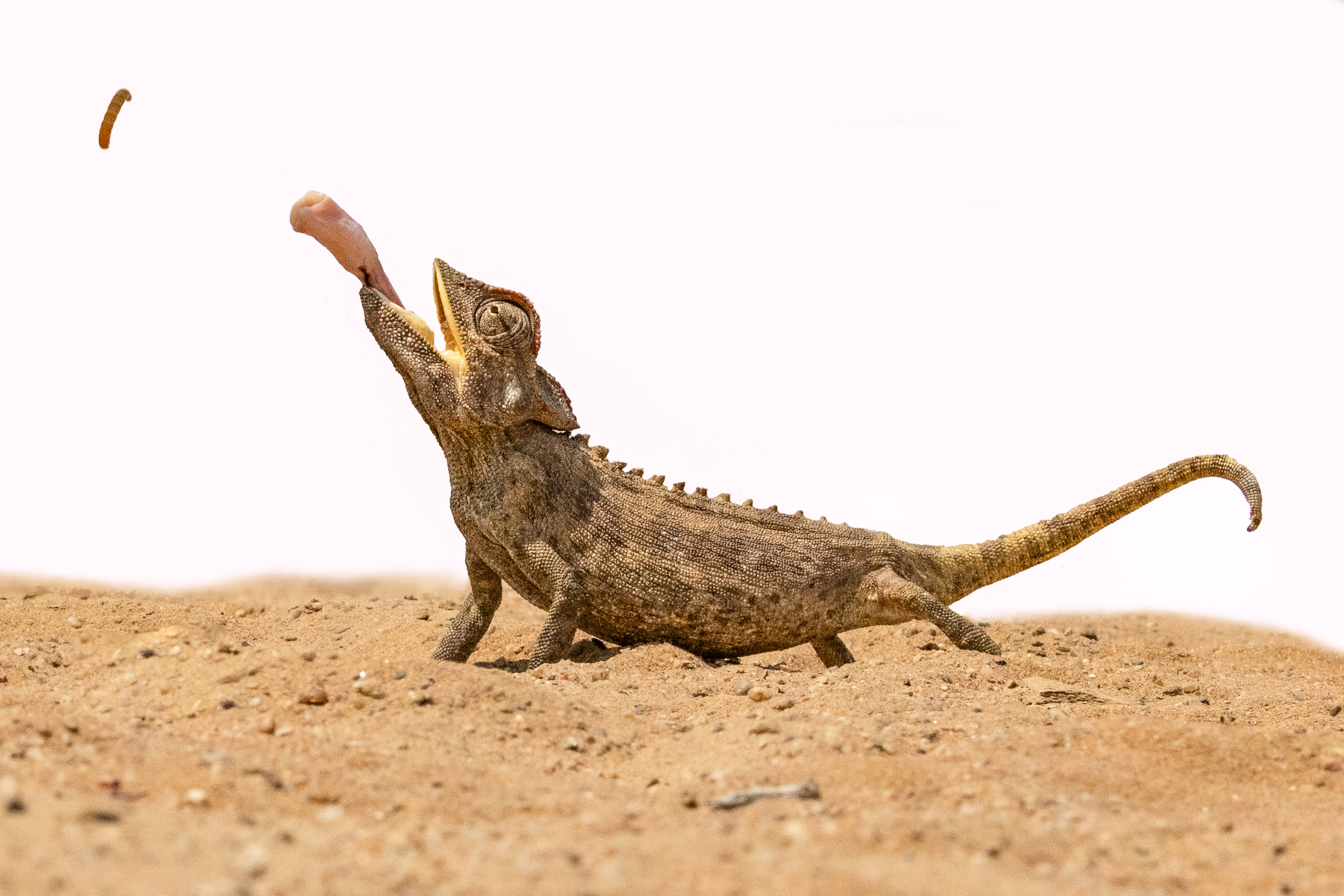
A Namaqua Chameleon catches its breakfast on our Living Desert trip, the ultimate Sandbox Safari (image by Inger Vandyke)

The stunning trees of Deadvlei (Image by Inger Vandyke)

A simple shot of an Ostrich (Image by Inger Vandyke)

A wandering, foraging Secretarybird in the Kalahari (Image by Inger Vandyke)

Portrait of an Etosha lioness (Image by Inger Vandyke)
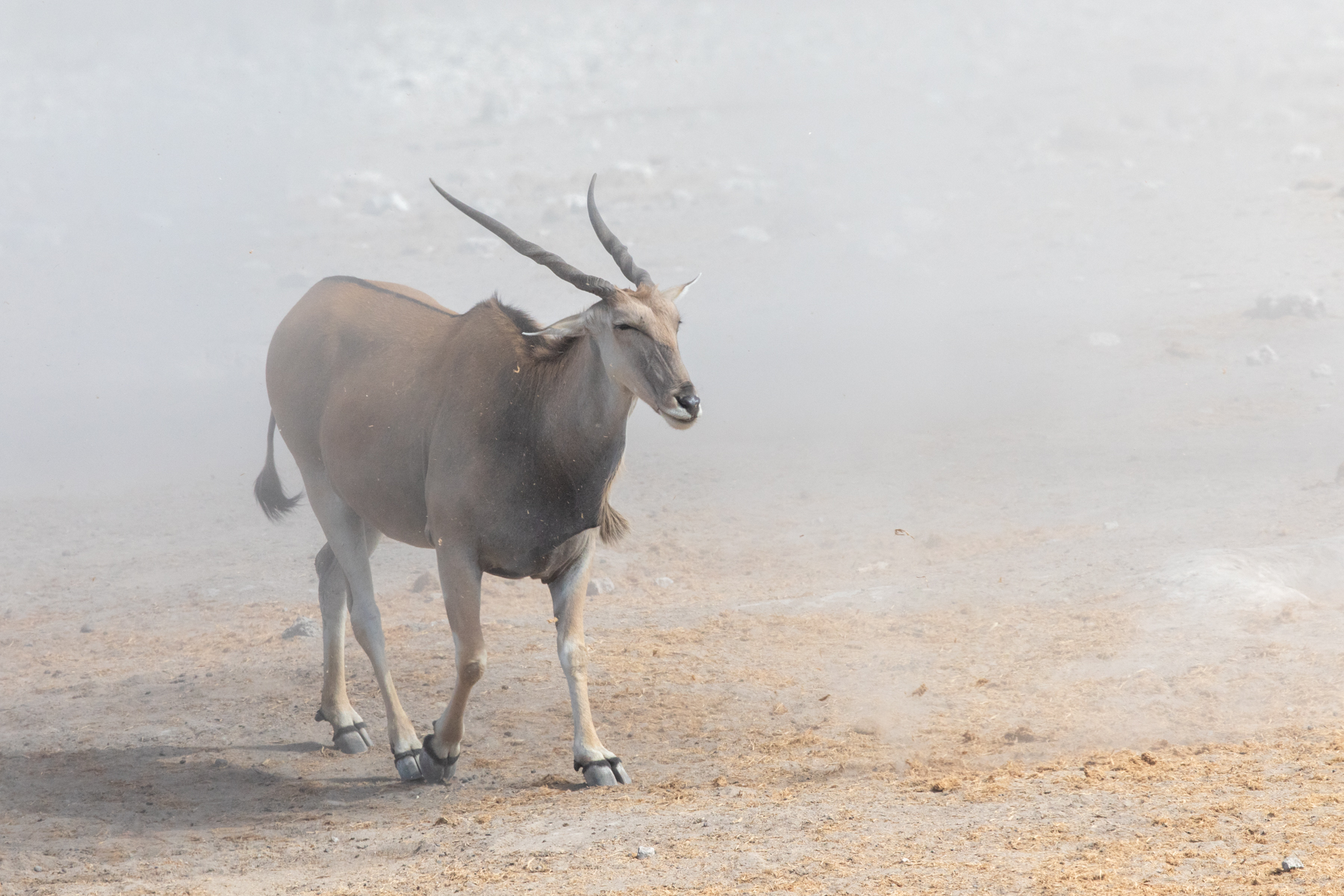
An Eland braces itself for the dust of a sudden whirlwind in Etosha (image by Inger Vandyke)

Peringueys Adders are the masters of camouflage in Dorrob National Park (Image by Inger Vandyke)

Portrait of a male Rosy-faced Lovebird on a Quiver Tree (Image by Inger Vandyke)

Detail of an old male Etosha Elephant (image by Inger Vandyke)
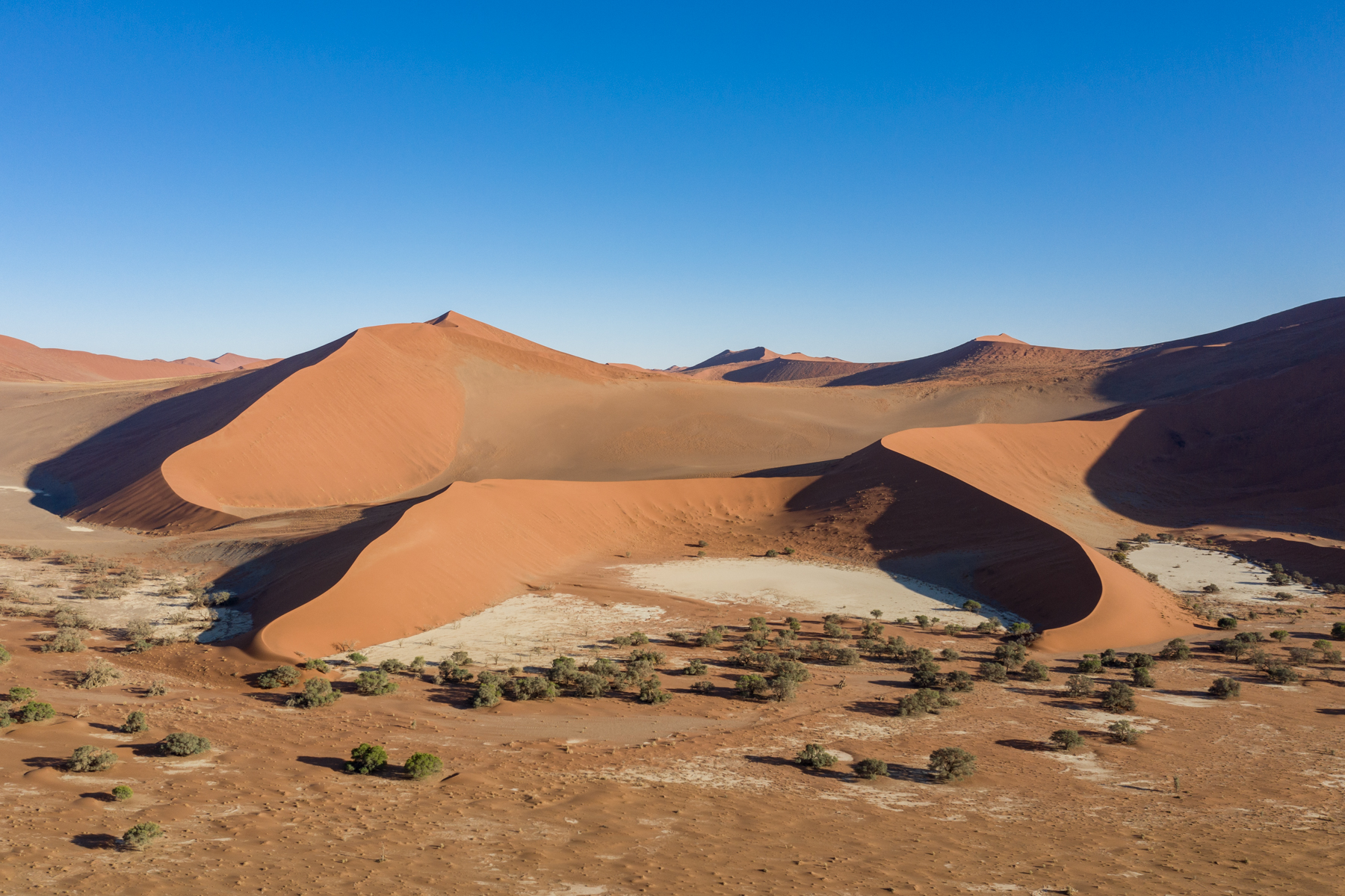
Stunning Sossusvlei - everywhere you turn there are beautiful images! (image by Inger Vandyke)

Even in old age Himba women are beautiful (Image by Inger Vandyke)

A pair of Helmeted Guineafowl take a drink in the late afternoon at Klein Namutoni (Image by Inger Vandyke)

Flamingos taking flight at Walvis Bay (Image by Inger Vandyke)

Dorrob National Park from the air (Image by Inger Vandyke)

Late afternoon cloud burst in Sossusvlei (Image by Inger Vandyke)

Portrait of a Yellow Mongoose in the Kgalagadi Transfrontier Reserve (Image by Inger Vandyke)

Portrait of a male Black-maned Lion in the Kalahari (Image by Inger Vandyke)
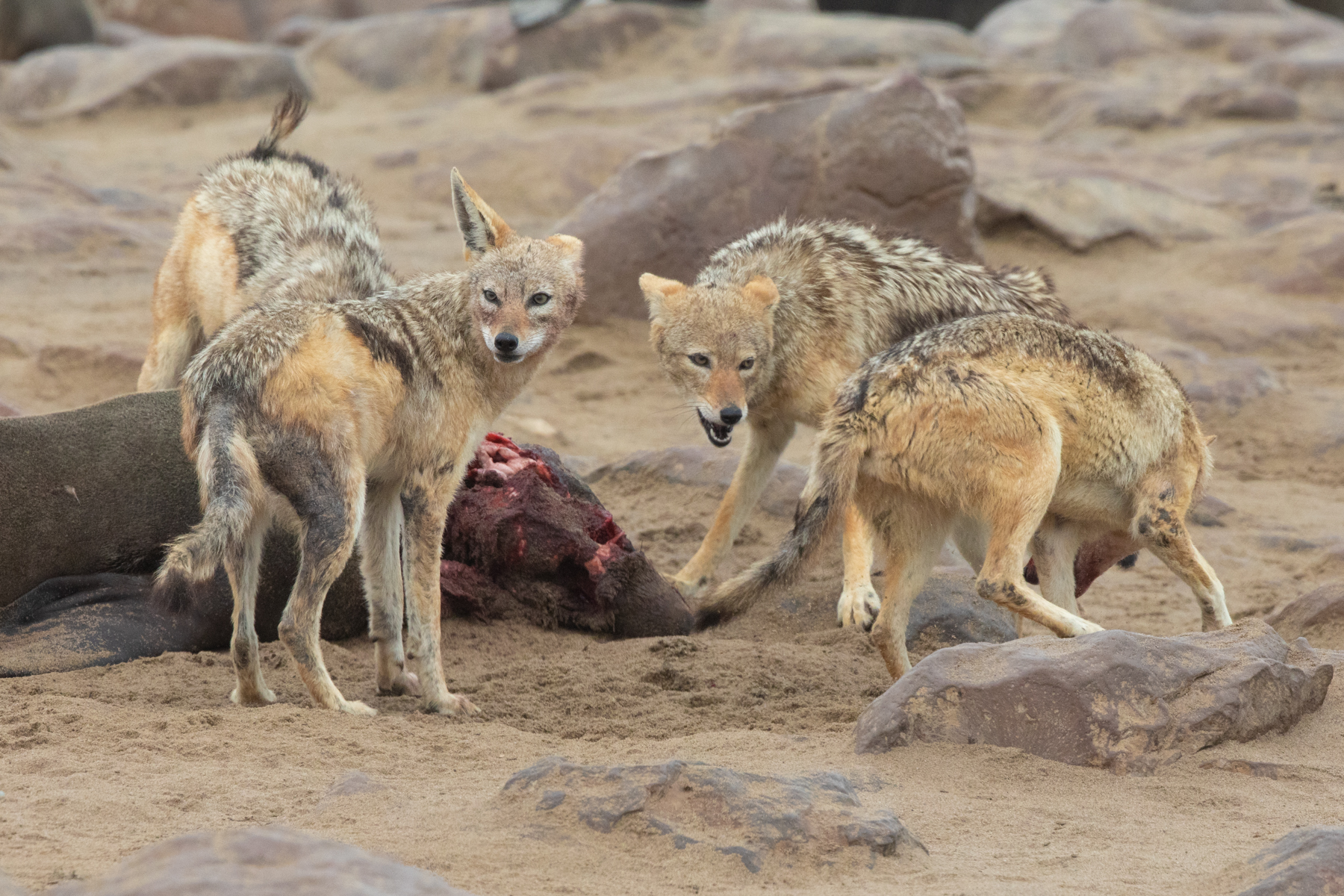
A pack of Black-backed Jackals argue over a dead seal carcass at Cape Cross (image by Inger Vandyke)

Portrait of a Grey Go-Away-Bird at Etosha (Image by Inger Vandyke)
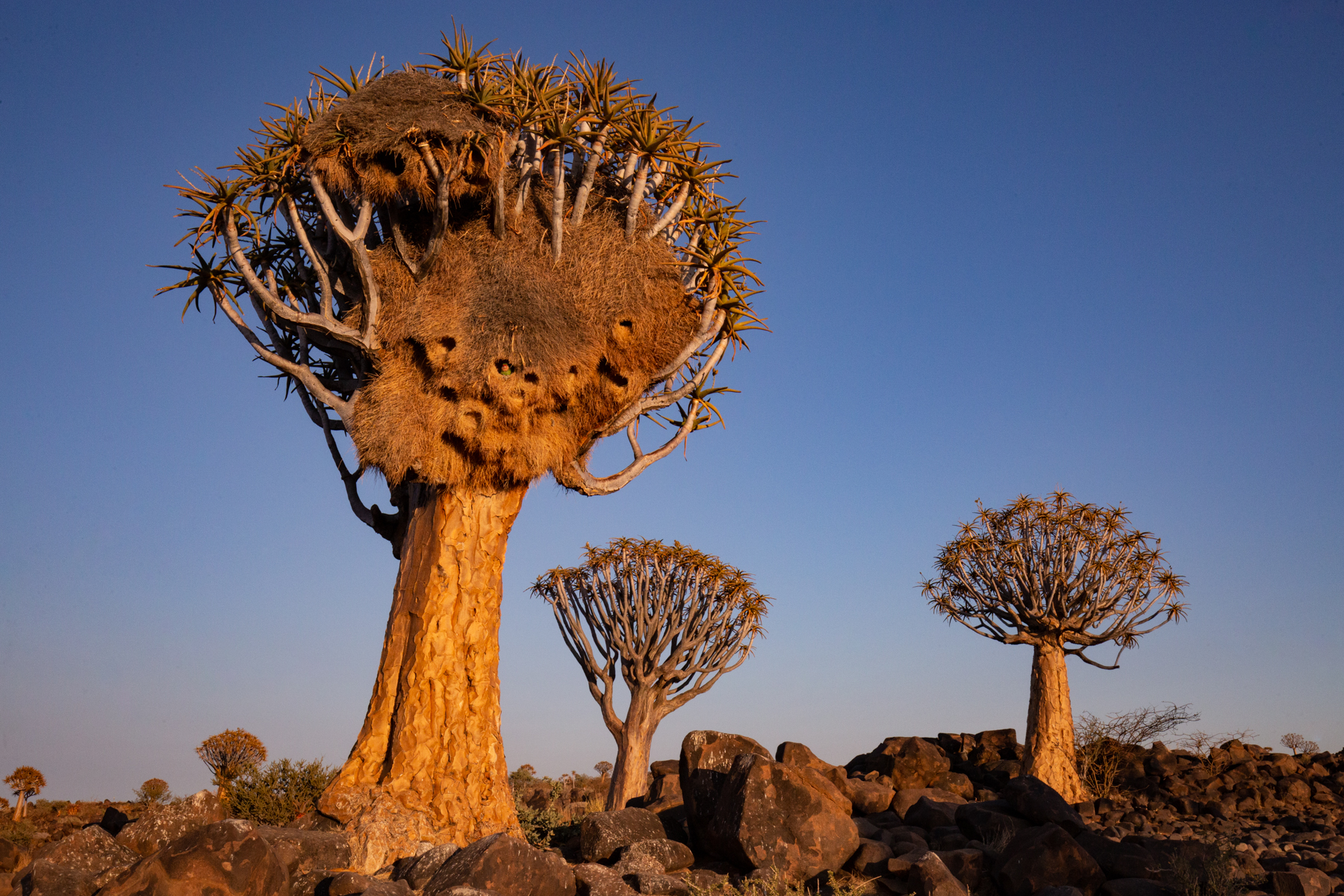
A shy Rosy-faced Lovebird peers out of its nest built by Sociable Weavers in the Quiver Tree Forest (image by Inger Vandyke)

A group of adult lion cubs finish what is left of their Zebra prey (Image by Inger Vandyke)

Oryx are common yet so very beautiful (Image by Inger Vandyke)
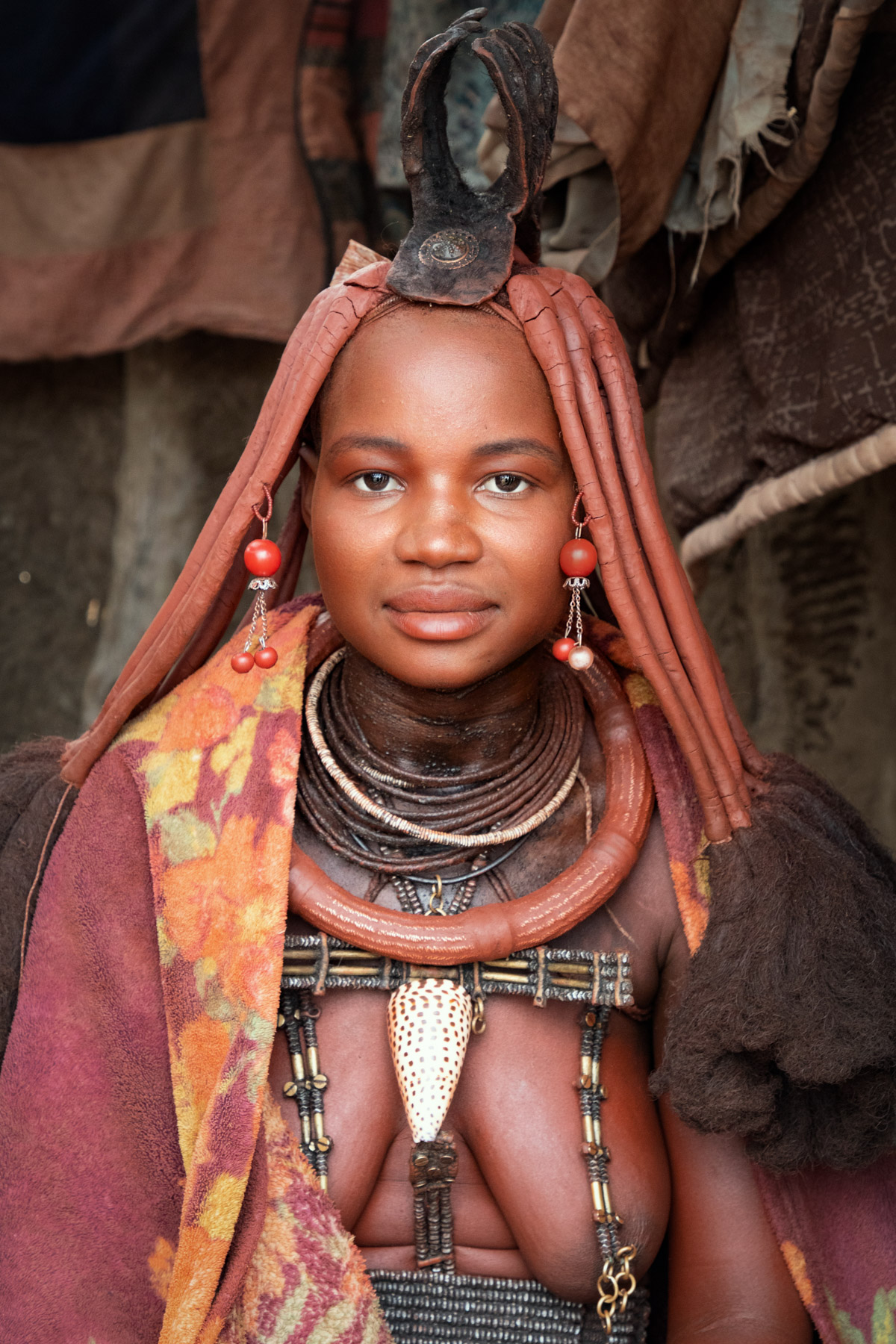
Portrait of a beautiful Himba girl in remote Namibia (image by Inger Vandyke)

A Himba mother and her baby shelter from the sun beneath a communal food storage construction (Image by Inger Vandyke)

An iconic shot of Deadvlei (Image by Inger Vandyke)

Portrait of a Spotted Hyena in the Kgalagadi Transfrontier Reserve (Image by Inger Vandyke)
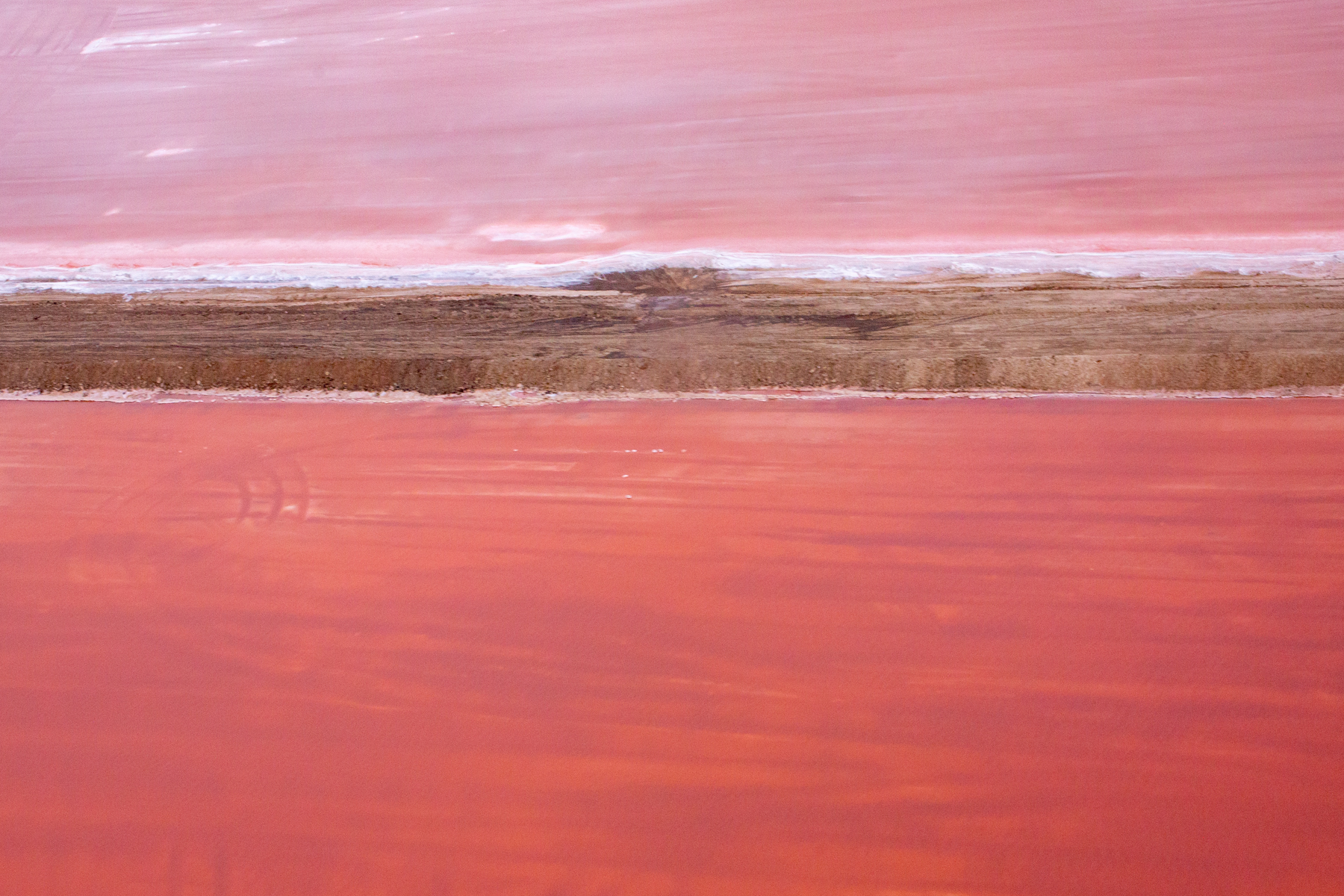
Aerial view of the salt pans at Walvis Bay (image by Inger Vandyke)

Some of the petroglyphs in Damaraland date back to 9000 years ago. We visited some that depicted both Oryx and Ostrich (Image by Inger Vandyke)

Himba children playing outside their home in remote Kaokoland (Image by Inger Vandyke)

A lone Quiver Tree in the beautiful Giant's Playground (Image by Inger Vandyke)

A large Etosha elephant wanders off into the bushes (Image by Inger Vandyke)

A handsome Mountain Wheatear in the rushes beside a stretch of water in the Hoanib ephemeral river (Image by Inger Vandyke)
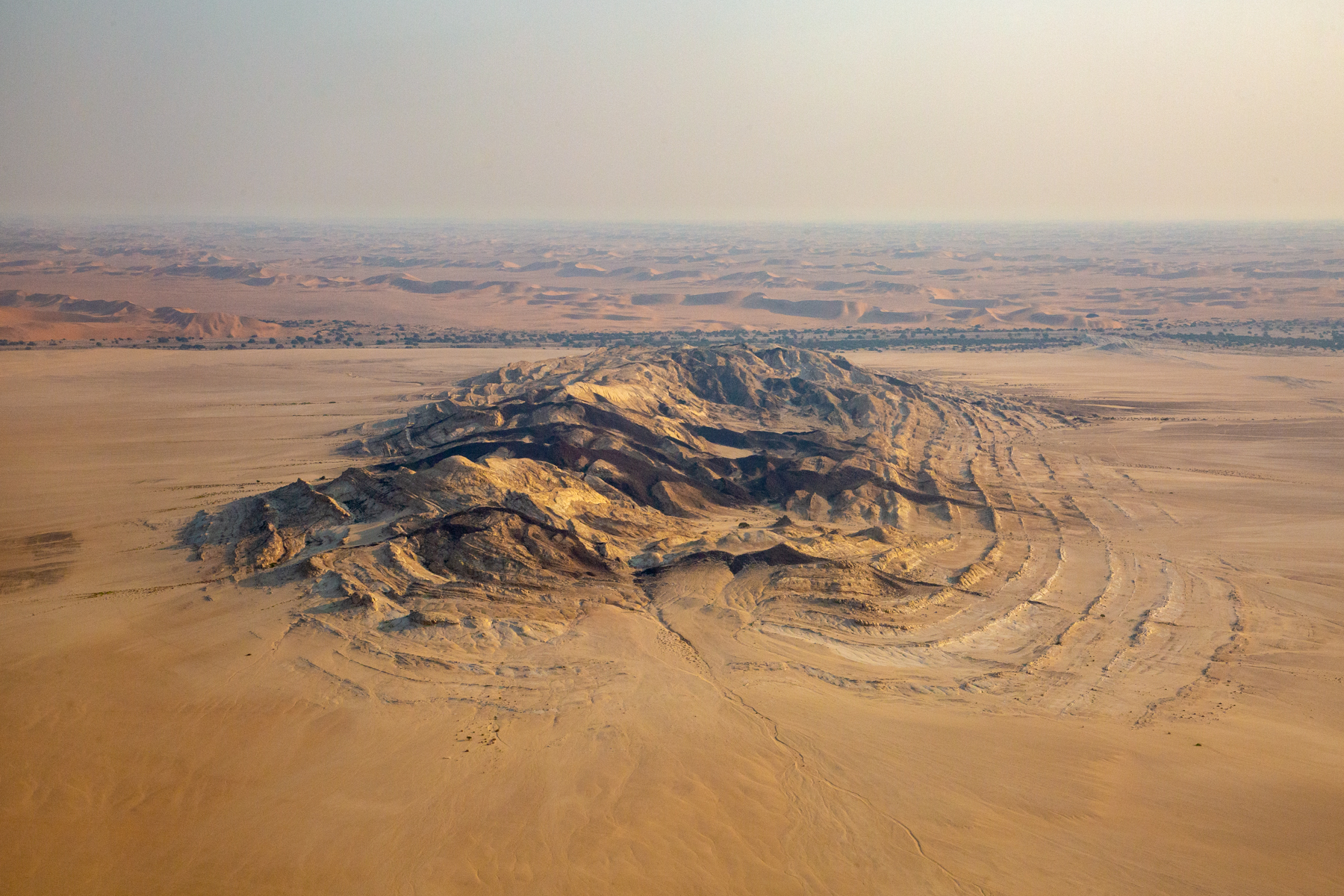
Dorob National Park from a scenic plane flight. Look at that fantastic geological formation! (image by Inger Vandyke)
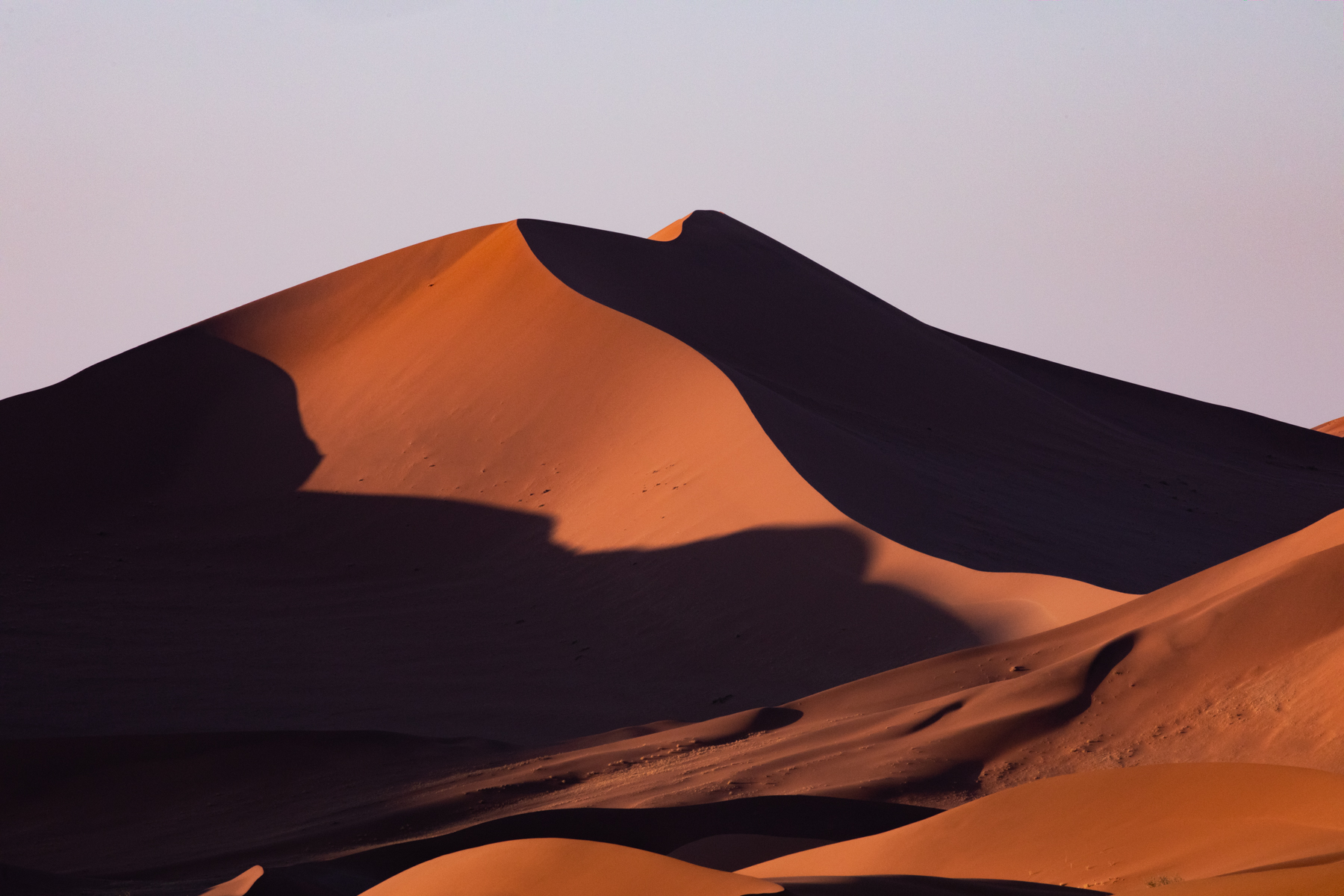
The quiet, dreamlike landscapes of Sossusvlei at sunset (image by Inger Vandyke)

The desert landscapes of the Hoanib are adorned by Oryx (Image by Inger Vandyke)
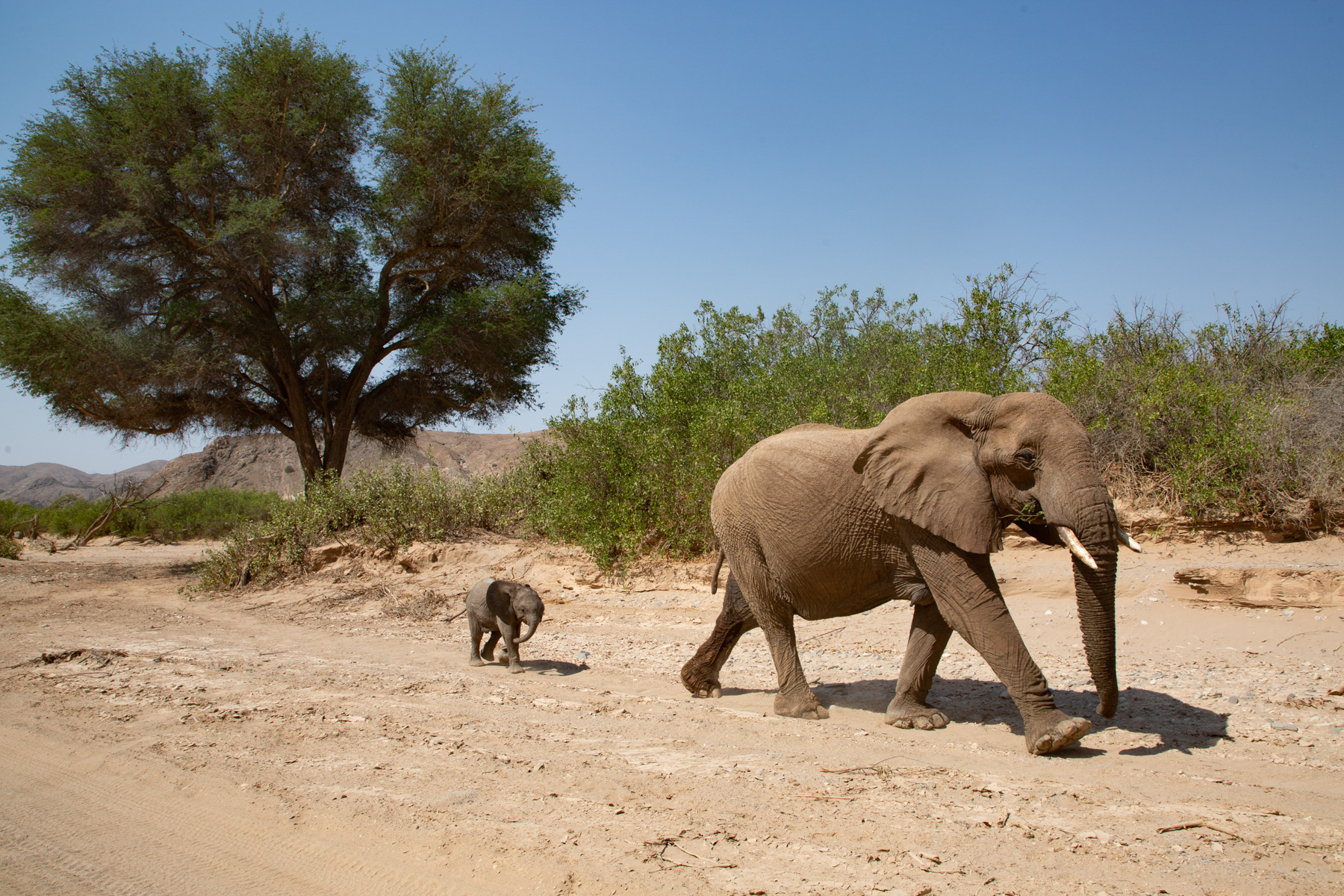
A mother desert elephant makes her way down the Hoanib Riverbed with her tiny baby (image by Inger Vandyke)
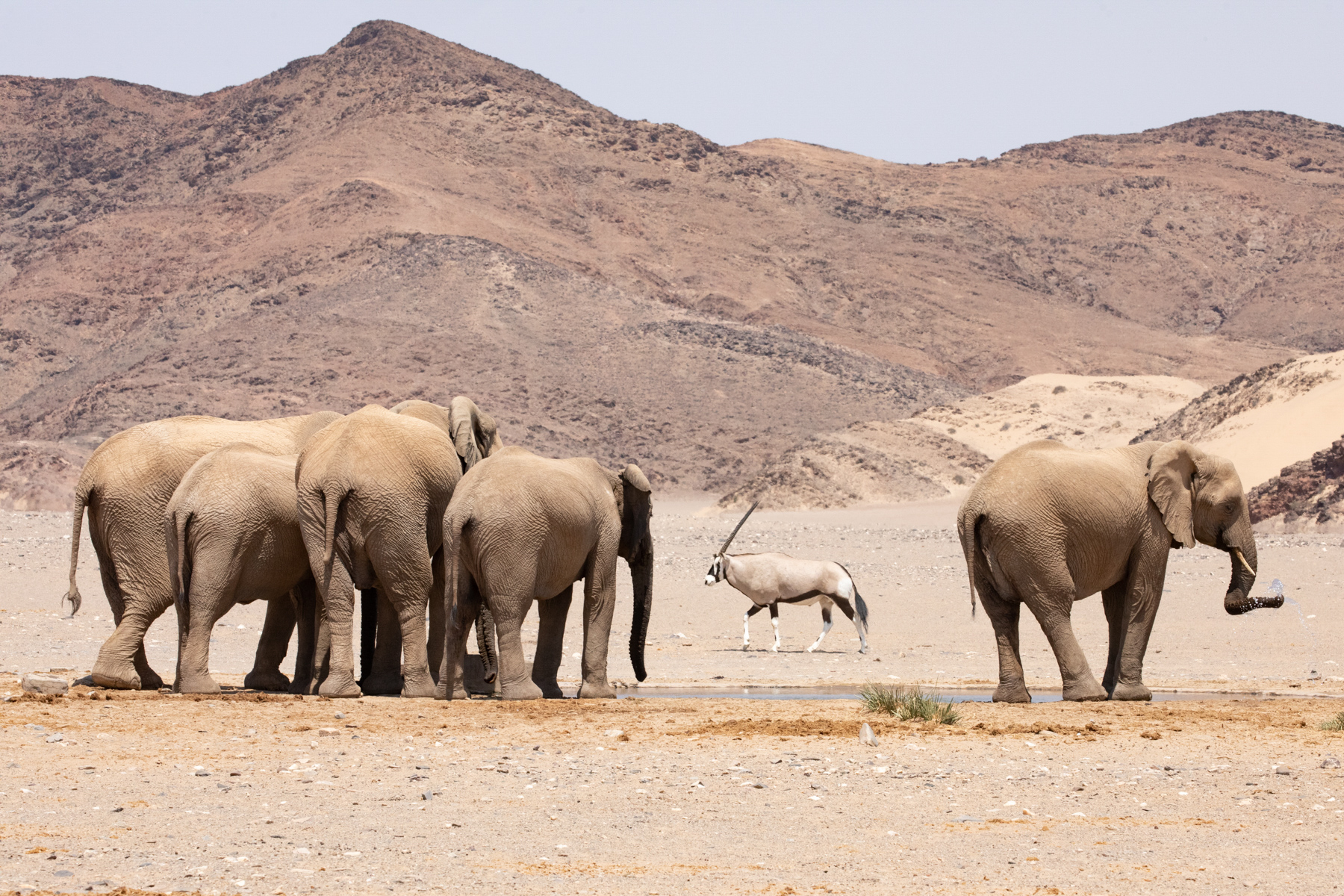
Desert Elephants are forced to share their drinking holes with other creatures including Oryx (image by Inger Vandyke)

Full moon in the Quiver Tree Forest at Keetmanshoop in Namibia (Image by Inger Vandyke)

The lichens of Namibia's coast have an extremely high level of endemism. The diversity of them is breathtaking (Image by Inger Vandyke)

One of two beautiful Desert Lions we found in the Hoanib Riverbed (Image by Inger Vandyke)

A spectacular sunset from Etaambura Lodge in remote Kaokoland (Image by Inger Vandyke)

A pair of Ruppell's Korhaans call to each other in the morning (Image by Inger Vandyke)
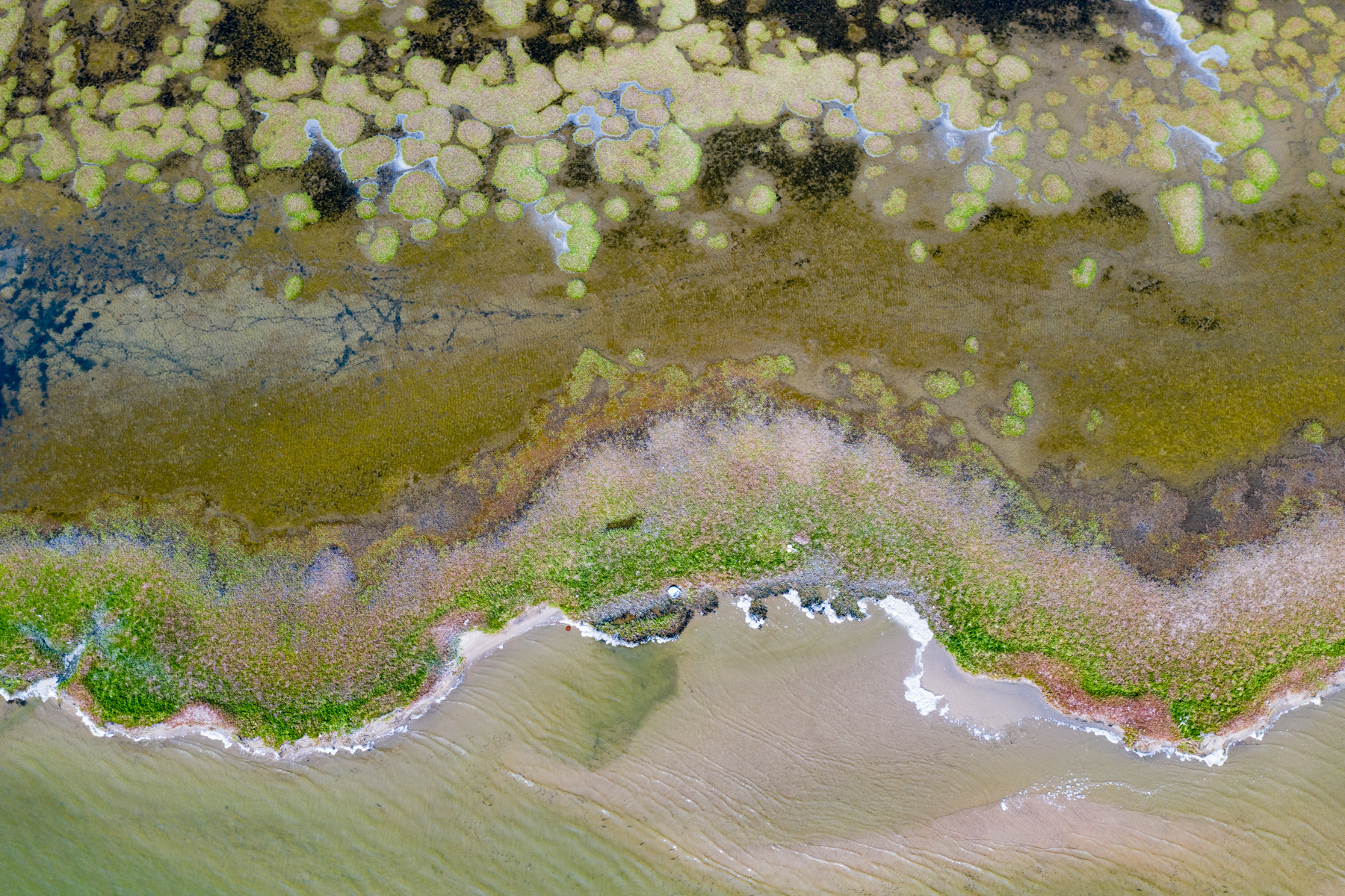
An aerial view of the coastline at Walvis Bay (image by Inger Vandyke)

A Himba mother plays with her young child in the shade of a food storage construction (Image by Inger Vandyke)
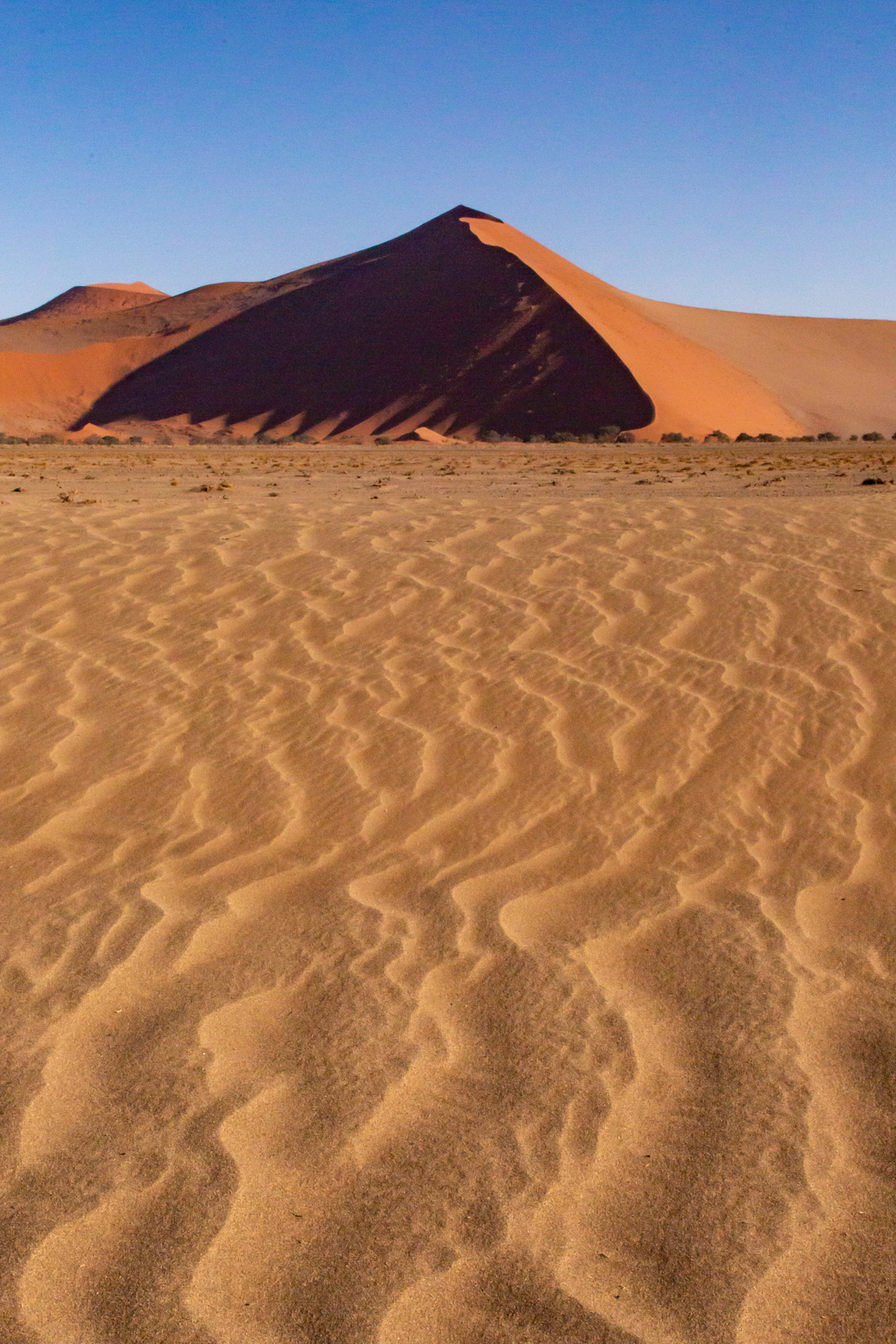
Ripples and dune details in Sossusvlei (image by Inger Vandyke)

Buses and climbers gather to walk up Sossusvlei's famous Dune 45 (Image by Inger Vandyke)
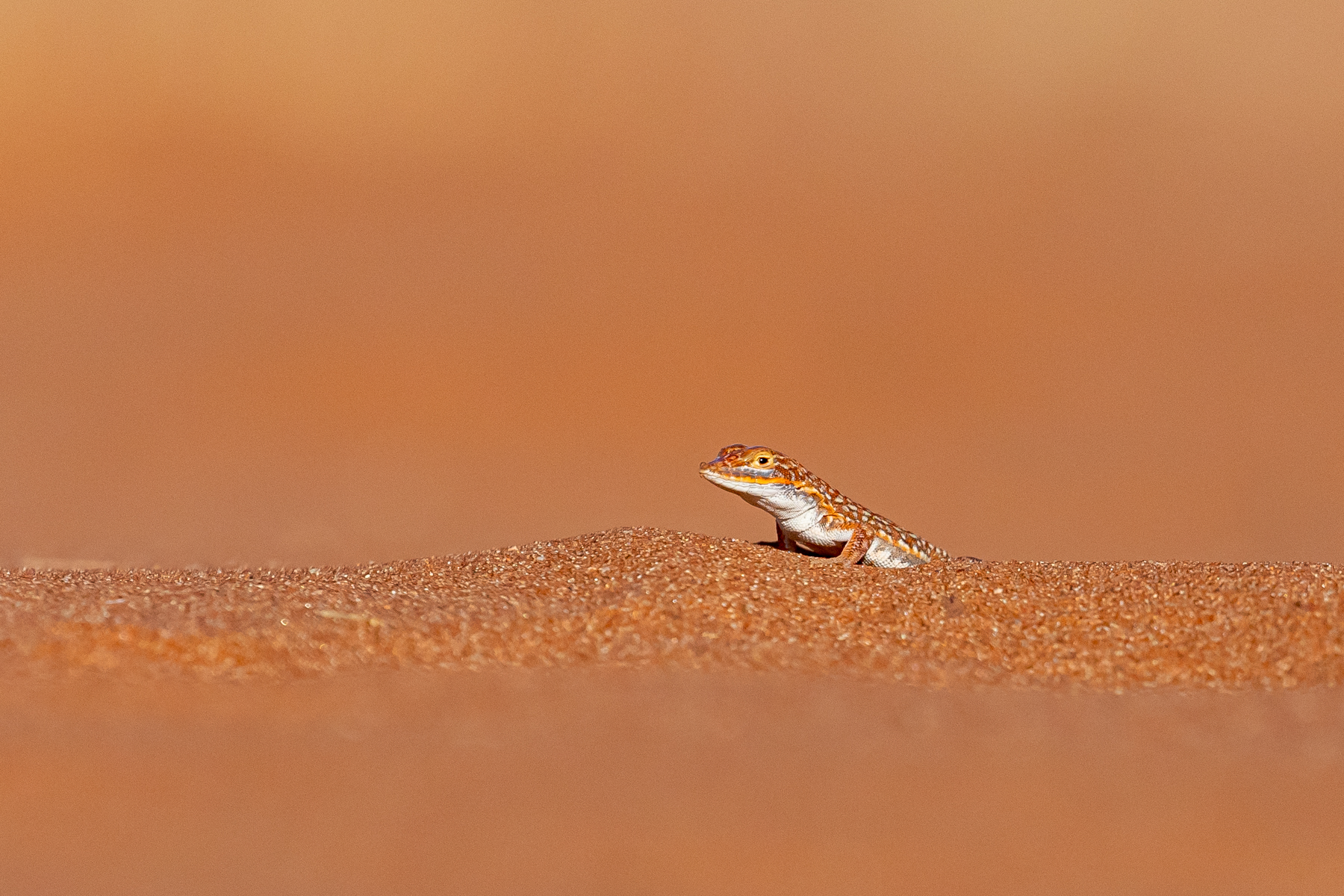
A cheeky Wedge-snouted Lizard runs around at our feet on Elim Dune in Sossusvlei (image by Inger Vandyke)

A group of tourists climb Big Daddy, the tallest of the dunes at Sossusvlei (Image by Inger Vandyke)

The stark beauty of a giraffe wandering near the gigantic Etosha pan (Image by Inger Vandyke)

A Kori Bustard takes a drink from a waterhole in Etosha (Image by Inger Vandyke)
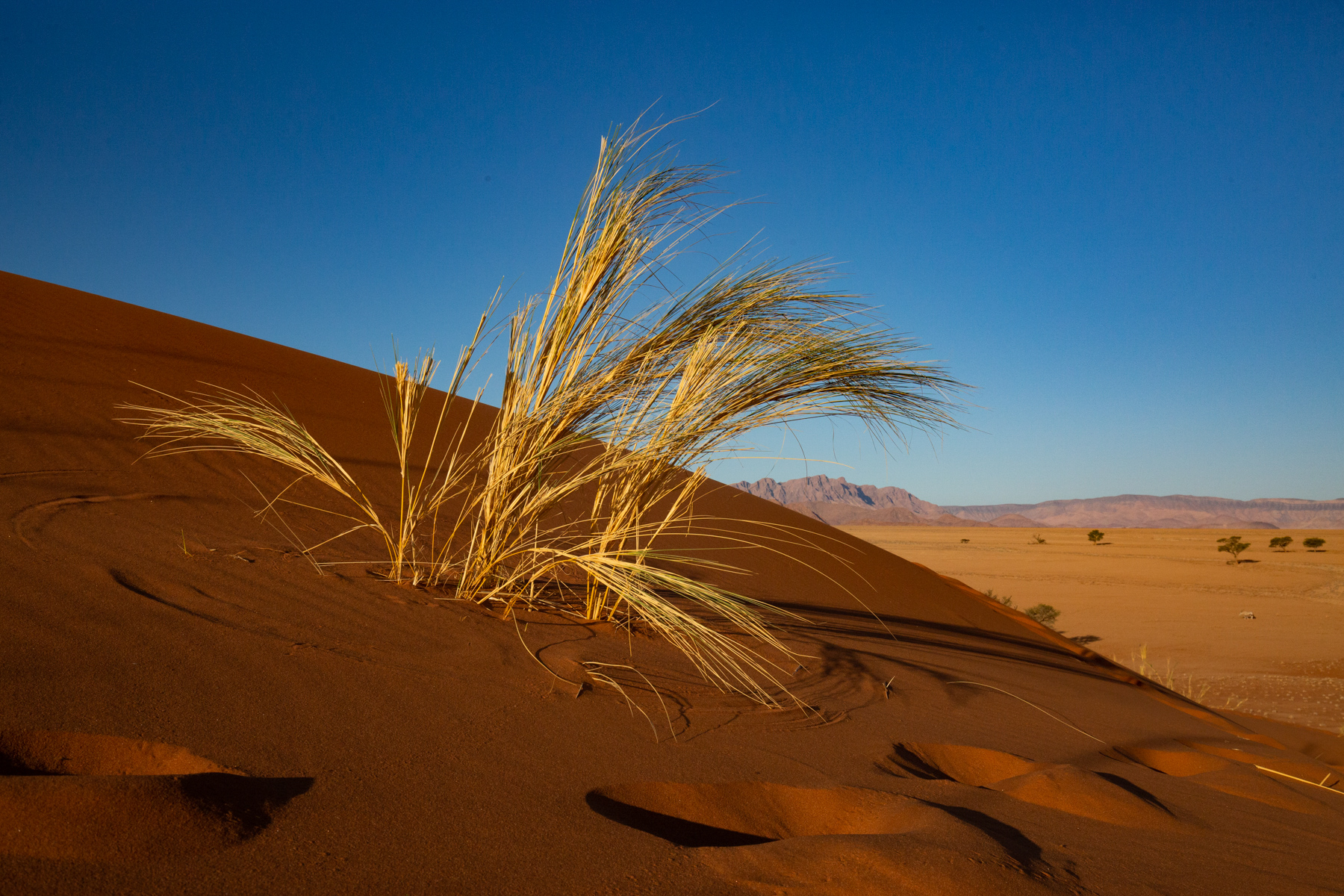
Dune grasses at sunset on Elim Dune in Sossusvlei (image by Inger Vandyke)
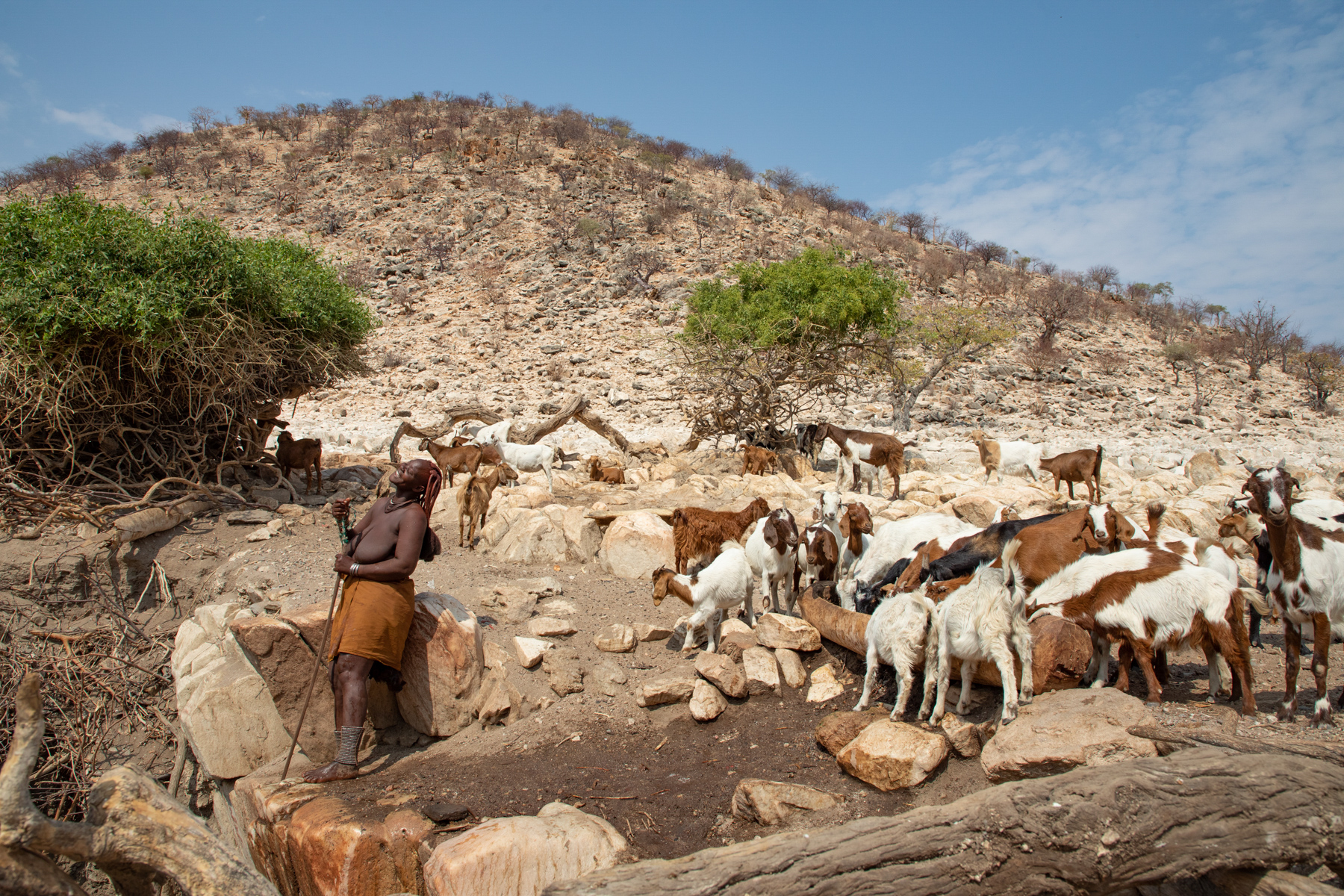
A laughing Himba woman draws water from her well to sustain her goats and sheep (image by Inger Vandyke)

A pair of Kalahari Black-maned Lions mating in the dust (Image by Inger Vandyke)

Black-backed Jackals argue over the remains of a zebra carcass in Etosha. Even the Pied Crows tried to steal their share! (Image by Inger Vandyke)
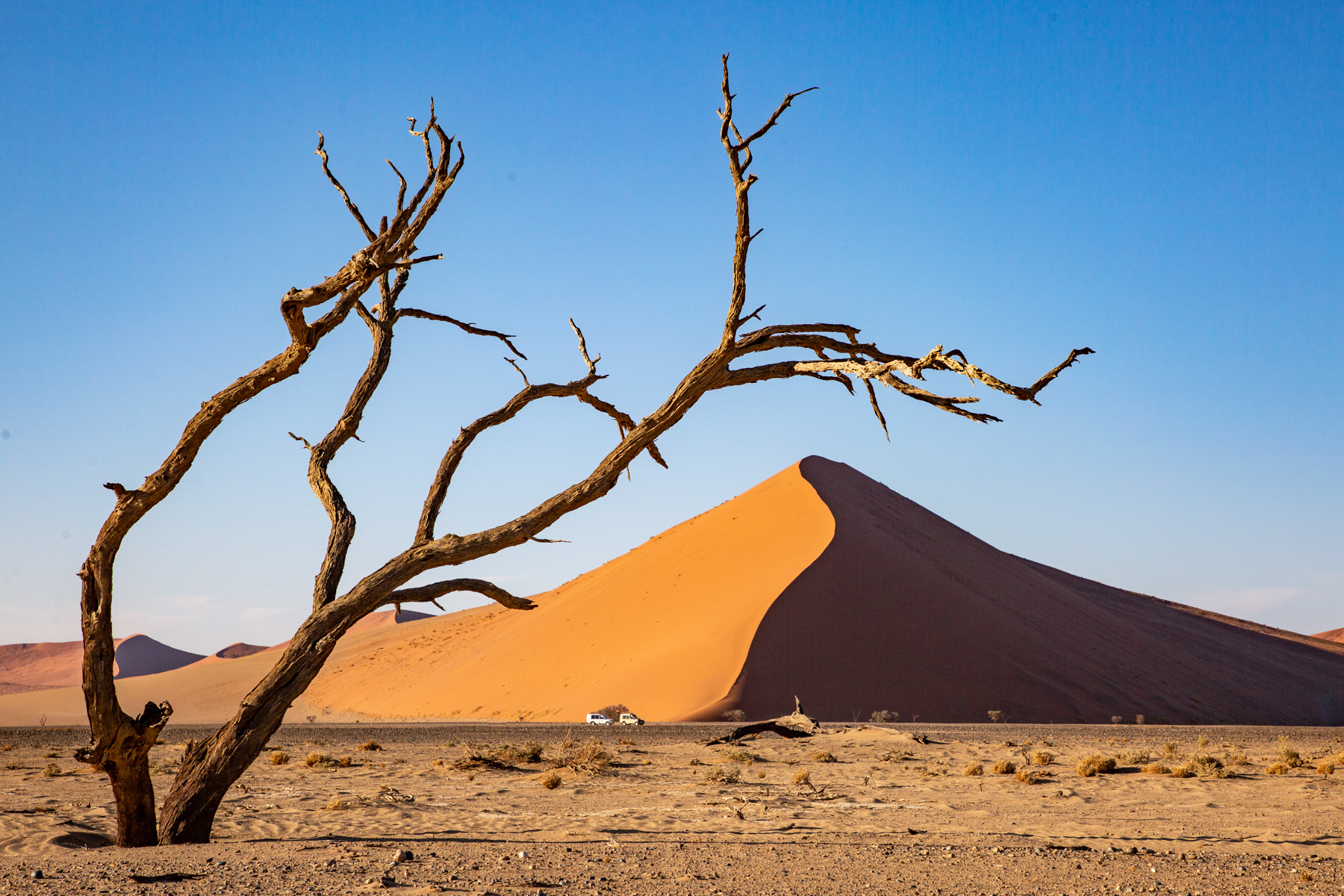
Sossusvlei is never an unattractive office. Our expedition cars lie waiting for us to finish our landscape photography there. (mage by Inger Vandyke)

Dune Lark portrait (Image by Inger Vandyke)

Aerial view of Etaambura (Image by Inger Vandyke)

Portrait of a Tractrac Chat in Dorrob National Park (Image by Inger Vandyke)

A herd of Desert Elephants gather at a waterhole in the Hoanib to drink (Image by Inger Vandyke)

Portrait of an old male Etosha Elephant near Olifantsrus (Image by Inger Vandyke)

Cormorants rest on the beach in the early morning fog of the Skeleton Coast (Image by Inger Vandyke)

When you hope for a perfect reflection image of a Red Hartebeest and your shot is photo-bombed by an African Shelduck! (Image by Inger Vandyke)
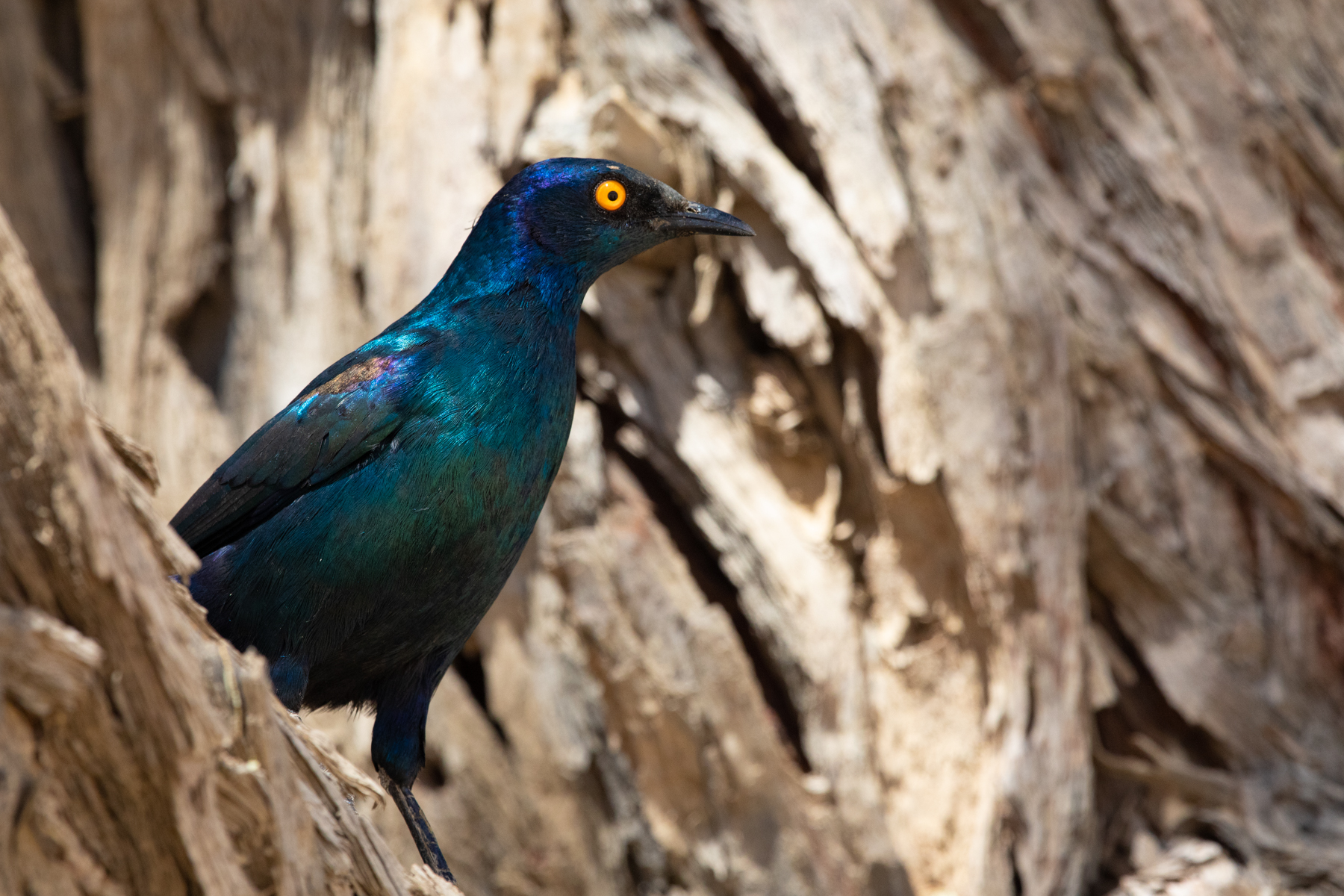
Cape Glossy Starling are beautiful but they love raiding picnic sites! (image by Inger Vandyke)

One of the Charitsaub cubs nudges its mother in Etosha (Image by Inger Vandyke)

Desert grasses at Elim dune in Sossusvlei late in the afternoon (Image by Inger Vandyke)
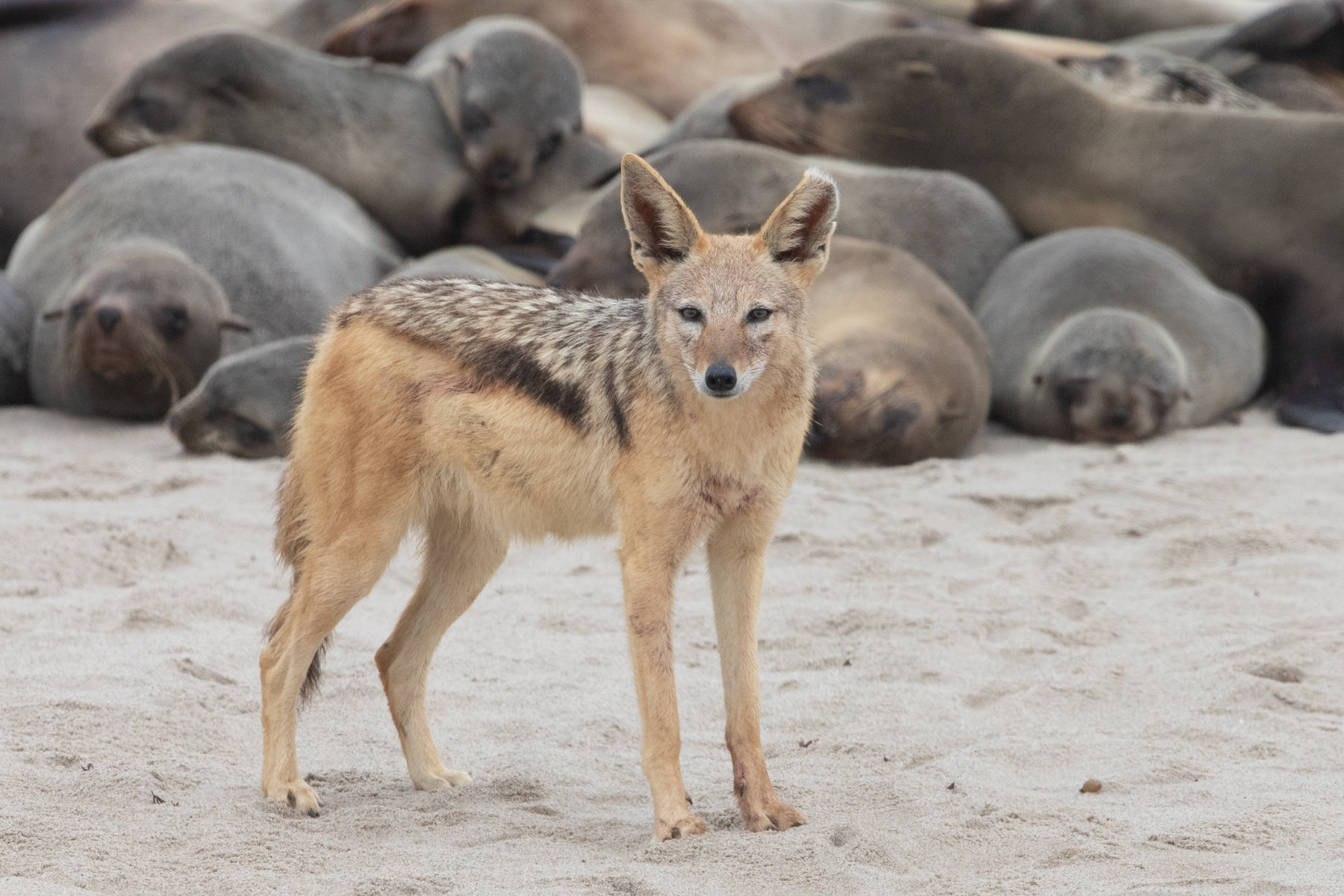
Portrait of a Black-backed Jackal in the Cape Fur Seal colony at Cape Cross (image by Inger Vandyke)
Our group for the 2019 Namibia and South Africa tour assembled in Windhoek at the lovely Villa Vista hotel which enjoys wonderful views over the city. A few guests had arrived early to overcome jetlag and had already bagged a few lovely photographs of the wildlife in suburban Windhoek including Grey Go-away-bird and Rosy-faced Lovebirds. Even the transfers in from the airport to the city yielded sightings of Ostrich, Yellow Mongoose, Warthogs and Chacma Baboons.
Despite the severe drought that had swept across southern Africa in the months preceding and during our trip, a wonderful group of guests joined a visually spectacular tour that included many photographic highlights.
Our welcome dinner for the tour was celebrated at the iconic Joe’s Beerhouse in Windhoek, a famed start and end point for many well known safaris in southern Africa.
KGALAGADI TRANSFRONTIER RESERVE
We left Windhoek at 8am after breakfast and started the long journey south towards the frontier between Namibia and South Africa. Spending only the necessary time for lunch, fuel and bathroom breaks, we were fortunate enough to reach the border at around 4pm where a quick crossing allowed us to check in at our established camp at Mata Mata and head out for a late afternoon drive in the Kgalagadi Transfrontier Reserve.
Normally a hotspot for Giraffe, it was curious that we didn’t encounter any on that first afternoon. We did, however, see our first herd of Wildebeest; singular Oryx, Springbok, Yellow Mongoose and we enjoyed watching a few Black-backed Jackals trying to feast on what was left of an Eland carcass. Towards the end of the drive we spotted a beautiful backlit Oryx which a few guests photographed well.
Retiring to our camp before the gates closed, we were delighted to watch flocks of birds, roaming Black-backed Jackals and Oryx descending on the campsite waterhole to drink at sunset.
On our first full Kalahari safari day we embarked on a drive slowly through the Transfrontier towards our next camp of the trip at Nossob after a breakfast surrounded by a beautiful flock of birds that included Cape Glossy Starlings, Groundscraper Thrush, Red-eyed Bulbuls and White-browed Sparrow Weavers. We even had a few Yellow Mongoose running around our camp, hoping probably for some tidbits to fall in their general direction.
Fortunately we had been granted permission from border authorities to creep back into Namibia at the moment the gates opened so we could visit the resident group of Meerkats who have taken up residence underneath the office building of the border in Namibia. We arrived as the Meerkats were engaged in their early morning burrow cleaning, sunning and foraging. Engaging with the Meerkats on their own terms, we managed to spend a little time with them before they went about their daily roaming and as they went, we ourselves departed and started our journey through the Kgalagadi. Our first day on safari finally produced our first giraffes, a foraging Honey Badger, Wildebeest, Oryx, Springbok and a wide variety of birds including our first sightings of Bateleur, White-backed Vulture and an elegant Martial Eagle roosting on a branch in the shade. We drove through spectacular valleys dotted with gnarled acacias and patches of red sand dunes so typical of this mesmerising landscape, especially in the nadirs of its ancient ephemeral rivers. It was in one of these nadirs we spotted a running Honey Badger so we followed him for as long as we could before he trotted off in a direction away from our vehicles.
Crossing from there towards Nossob, we found an African Wild Cat sheltering from the heat of the day at the crest of a local dune. Sadly he was in the shade and while we tried to edge closer, he eventually grew tired of us creeping up on him and he disappeared in to the dune grasses.
Since the Kgalagadi is home to some spectacular colonies of Sociable Weavers we also stopped to photograph some of their more artistic nesting trees where many birds communally raise their young.
We visited a few waterholes closer to Nossob in the hope of finding lions or other predators but it was rather quiet in the area around the camp so we settled in for a night of dining under the stars and falling asleep to the sounds of calling Pearl-spotted Owlets and Southern White-faced Owls.
Early the next day we drove west from Nossob towards the waterhole of Polentswa and we were delighted with some lovely sightings of a herd of Wildebeest approaching Langklaas waterhole in the dust. Joining them were several Oryx who were stunning in the stark beauty of this waterhole, allowing for lovely photos. As we drove around we were treated with sightings of White-backed Vultures on their nest, Kori Bustards and even brief glimpses of a Dwarf Beaked Snake and a Kalahari Senghi crossing the roads close to our vehicles.
Highlights of our afternoon drive on the eastern side of Nossob included watching a Honey Badger climb an Acacia tree, Martial Eagle wheeling the thermals overhead and catching the last daylight with a pretty collection of passerine birds at Rooikop waterhole.
Leaving Nossob, we drove a full day safari towards our next camp at Twee Rivierien, closer to the frontier with Botswana (the road we drove was parallel to the border). Our main highlights of the morning were birds including a group of Ostriches dust-bathing in the spectacular early morning light which made for wonderful photographs.
Shortly afterwards we sighted our first foraging Secretarybird wandering around the Kalahari grasslands looking for a late breakfast of skinks or snakes.
Further into the park we saw our first Spotted Hyenas near Dikbaardskolk slumbering close to the waterhole where several Oryx were drinking. We also encountered a somewhat beaten around Black-backed Jackal hobbling around the waterhole. Although we didn’t see what might have attacked him we felt he might have tried to tackle a predator greater than himself and fared worse for the encounter.
Stopping for lunch under the shade of a large tree we were entertained with several feathered picnic site raiders including Scimitarbills, Cape Glossy Starlings, Acacia Pied Barbets, Sociable Weavers and White-browed Sparrow Weavers. We even spotted a couple of Black-backed Jackals sniffing around the periphery of our lunch spot, hoping for some leftovers.
When we drove towards Twee Rivieren some of the classic Kgalagadi creatures became the highlight of our afternoon. We enjoyed our first sighting, albeit distant, of a Pale Chanting Goshawk companion hunting with a Honey Badger. Although not photogenic, watching this symbiotic hunting behaviour is unique to the Kgalagadi and always fascinating to watch as a local Honey Badger dug to unearth treats while his Goshawk friend waited for any escaping creatures to eat.
A passing car informed us of a Spotted Hyena further down the track so we left to take a look and actually had the reported Hyena cross directly in front of our vehicles to find a place in the shade to rest. At one point this lovely creature was face on to one of our stopped vehicles and restfully made eye contact with our group from a mere distance of two metres or so, until a speeding self-drive car scared it across the road and into nearby bushes to rest.
We decided to let it sleep and as we neared Twee Rivieren we spotted a group of parked cars that could only mean one thing – a sighting of some of the Kgalagadi’s famous predators. Pulling in alongside them, we realised they were all watching a (collared) pair of beautiful Black-maned Kalahari Lions sleeping in the shade. We stopped and waited, watching them to see if they would stir from their slumber. On several moments, the large male lion rose to take a swipe at the flies swarming around his face. Like a large kitten he would rise up and try to swat the flies with his oversized paws and a gnarly, angry look on his face. Each time he did this we got excited he might move and each time he dropped back down to sleep we all let out collective ‘sighs’. That was, until, the two of them decided to mate, which they did several times right before our eyes.
For some of the group these two lions were the first wild African lions they had seen and we stayed with them as long as we could until the gate closing times forced us to depart.
Needless to say we all arrived in to camp at Twee Rivieren delighted that we had finally seen wild lions on our trip!
We decided to undertake one last sunrise drive in the Transfrontier before we returned to camp for a late breakfast, border crossing and the drive north into Namibia to Keetmanshoop.
Our last morning safari in the Kgalagadi Transfrontier produced a Verreaux’s Eagle Owl perched deep in the foliage of a flowering Acacia tree on the main route through the park. We also encountered nesting Tawny Eagles, Yellow Mongoose, Ground Squirrels, a Black-backed Jackal sunning itself on an embankment and we even found our Lion pair from the previous afternoon wandering in the backlit grasslands of the road not far from where we found them.
We stopped to photograph some lovely African Hoopoes and an astonishing drinking male Bateleur before we returned to Twee Rivieren for breakfast and our group enjoyed some entertaining photography with the resident White-backed Mousebirds, Acacia Pied Barbets and some very tame Yellow Mongoose in between bites of breakfast.
THE QUIVER TREE FOREST AND GIANT’S PLAYGROUND
We crossed the border back into Namibia and drove towards the rural town of Keetmanshoop which is home to two spectacular sites, both on private land, the Giant’s Playground and the Quiver Tree Forest.
We dropped our luggage off at the Quiver Tree lodge before venturing around to the beautiful Giant’s Playground for some landscape photography, experimenting with different compositions and starbursts.
Finally we returned to the iconic Quiver Tree Forest, next to the lodge, for sunset where our group were delighted by our first sightings of Rock Hyrax in the stones at the base of the Quiver Trees and also a beautiful sunset.
The full moon during our stay created too much light pollution for any meaningful night photography so we enjoyed an early night before a sunrise start in the forest.
At sunrise we enjoyed a wonderful photography shoot in the Quiver Tree forest where some of us focussed on the setting moon and including that in compositions. Others focussed on one Quiver Tree that was home to nesting Sociable Weavers and oddly a small flock of Rosy-faced Lovebirds who had decided to take up nesting spots inside the Sociable Weaver nest. A brief visit from a Short-toed Rock Thrush was also a delight for the bird photographers in our group.
We had a couple of minor distractions in the form of the lodge’s resident pet Cheetahs who were beautiful to spend time around. Numerous Rosy-faced Lovebirds attending the lodge’s bird feeders also made for beautiful photographs.
After another late breakfast we embarked upon our journey towards Sossusvlei by road, a trip where we started to see our first Hartmann’s Mountain Zebra, Ruppell’s Koorhaan, Augur Buzzard and Ludwig’s Bustard. We also saw some semi-captive White Rhino at a roadside Game Reserve.
SESRIEM AND SOSSUSVLEI
Arriving at Sesriem after a spectacular drive we checked into the beautiful Sossus Dune Lodge and Inger took several group members out to Elim Dune while Sean embarked on the first round of scenic helicopter flights over the incredible Namib Naukluft National Park.
The dune explorers enjoyed encounters with Toktokkie Beetles, Oryx, Sociable Weavers and a cute little Wedge-snouted Lizard.The flyers were treated to sights of Oryx running through the red dunes, a pair of dust bathing zebra and many, many beautiful dune landscapes that beguiled everyone.

Tracking lost guests in the desert requires a combination of skilful cunning and a good sense of humour! (Image by Inger Vandyke)
The next day we spent our sunrise photographing some of the iconic dead trees of Sossusvlei area experimenting with different views and compositions in photography that included sand ripples, patterned stones and shadows in the sand. We encountered a pair of wandering Ruppell’s Korhaans during our landscape photo shoot.
Shortly before we returned to the lodge for a midday siesta we stopped at a known hangout for Dune Lark and, after some initial searching and a view of another Wedge-snouted Lizard we ended up having two Dune Larks run around so close to us that at one point it was hard not to stand on them!

A Dune Lark poses for the Wild Images paparazzi! (Image by Inger Vandyke)
On the drive back to the lodge we spotted a circling Lappet-faced Vulture in flight and over lunch we were treated to lovely views of the Mountain Wheatears flitting around the rocky hillsides beside the lodge. At one point a tame Oryx walked past the verandahs of our rooms while we rested!
Later that day we drove out to the iconic Deadvlei for sunset. To our huge surprise we virtually had the whole site to ourselves and we felt thankful we had avoided the sunrise crowds of photographers. It was surreal to explore this beautiful, quiet place and not have to worry about ‘cloning out’ other photographers from our shots. The walk in and out of Deadvlei was breathtaking, especially towards the end when the sun was setting and heavy shadows were cast across the dunes in this end of the park. One of our guests, Michelle, decided to walk back to the vehicles a little earlier than the group where she was rewarded with a stunning encounter of a beautiful Oryx in the red dunes. Mesmerised, the rest of the group met her after stopping to look at the footprints of tiny creatures in the sand and watch the incredible dunes intensify in colour with the end of the day.
On our last day in Sossusvlei Inger took five of our group members out of the park at sunrise to enjoy a final flight over the dunes by helicopter while the rest of the group enjoyed a late breakfast and some leisurely packing. Sadly one of the two helicopters we were supposed to fly had a flat battery so only one group embarked that day and they were treated to wonderful early morning views of the dunes and two incredibly spectacular encounters with sand climbing groups of Oryx in the park.
Finishing the flight the two groups met in Sesriem and drove to the nearest town of Solitaire to refuel the vehicles. Leaving Solitaire we drove out to Walvis Bay, making stops to visit some viewpoints of the ever changing scenery and also to visit the famous cave where geologist Henno Martin sheltered from World War II and undertook field work. While visiting the cave in particular we were delighted to see a rather pregnant looking Oryx who had decided to take cover from the sun and rest in the shade of the cave. Although Henno Martin passed away in 1998 we somehow felt he must have been pleased to see such a beautiful creature visiting and resting in the cave that was his home for two and a half years.
WALVIS BAY
Driving down to Walvis over a massive expanse of desert we arrived in time for lunch and an afternoon session of photographing Walvis Bay’s Lesser and Greater Flamingoes both on the coast and in the dunes of Dorrob close to Walvis Bay town. We also found several species of migratory waders.
Finally we arrived in Swakopmund during the late afternoon and after checking in and taking a rest, we enjoyed a wonderful dinner by the sea at the renowned Tug Restaurant.
SWAKOPMUND AND THE LIVING DESERT
Today we enjoyed one of the highlights in general of the Wild Images tour to Namibia – a true “Sandbox Safari” to find some of weird and wonderful little critters in Dorrob National Park. After breakfast we boarded two 4WD vehicles and made our way into the desert just south of Swakopmund where we learned about the corrosive nature and the origins of the dunes in Dorrob, which is a much younger system than the dunes of the Namib Naukluft we’d seen in the preceding days. We stopped to visit the remains of the graveyard of horses and we learned how the Skeleton Coast dunes are formed before we went off in search of desert creatures.

Chantal, Frederic and Michel angling for the best shot of a Peringuey’s Adder! (Image by Inger Vandyke)
We initially found a Namaqua Chameleon asleep on a clump of Dollarbush in the early morning fog but we decided to let him sleep, noting his location before we ventured off to find other things to photograph. The dune-scapes of Dorrob National Park are always mesmerising for landscape photography, even in difficult light. Exploring the red-purple garnet sand ripples on the golden dunes and learning about the different mineral composition of the sands of Dorrob were side highlights to the creatures we met that included Toktokkie Beetles, Fitzsimon’s Burrowing Skink, Shovel-nosed Lizard and a beautiful Peringuey’s Adder.

Johanne getting the best angle on a desert critter! (Image by Wild Images guests Chantal and Frederic)
Later in the morning when the sun rose higher we returned to the Namaqua Chameleon we had met earlier in the day. He was awake by then and, in the knowledge that photographers bring food, he got so excited by our presence that he virtually combat-rolled out of his Dollarbush to enjoy a breakfast of Mealie worms. While trying to keep the resident Tractrac Chats away from his breakfast we all enjoyed trying to get that ‘iconic’ shot of a chameleon feeding with his long tongue.
These morning safaris are always a highlight of our trips as they introduce our guests to the stunning diversity of a landscape that otherwise appears lifeless.

Tricia happy with her Toktokkie Beetle photos (Image by Inger Vandyke)
Later that day, several of the guests who had their flights cancelled in Sossusvlei opted to do a late afternoon scenic flight over the Skeleton Coast while the rest of the group enjoyed an afternoon at rest in Swakopmund. The flyers were caught in an early encroaching fog that is so typical of coastal Namibia but still they managed to see some incredible dune landscapes, watch the Walvis flamingos from the air and see first hand how coastal communities thrive on the edge of one of the world’s harshest deserts.
CAPE CROSS AND THE SKELETON COAST
We left Swakopmund after breakfast to continue our journey into northern Namibia. Our first stop of the day was at the wreck of the Zeila, a trawler that became stranded on the coast of Namibia in August 2008. It is now a popular place to see a Skeleton Coast wreck first hand and it has also become home to numerous nesting cormorants. A few of us engaged with the local Damara vendors or semi-precious stones present at the site and we even came away with a few ‘treasures’ after a bit of jovial haggling and selecting.
Driving further north we arrived at Cape Cross shortly after the gates opened to the reserve. It was the middle of the annual cull at Cape Cross which actually attracted many Black-backed Jackals to this colony of Cape Fur Seals, the largest of its kind in the world. While we wandered around photographing the seals, it was perhaps the jackals that amused us all the most as they fought for their share of seal carcasses, rolled in the sand and played with each other amongst the seals. Running around the colony were several Sand Plovers, Kelp Gulls and we even spotted a foraging Cape Wagtail amongst the seals!
Eventually the smell and sensation of the colony determined how long we stayed and we jumped in our cars to drive north along the Skeleton Coast. We stopped for lunch at the wreck of the South West Seal on the beach and we explored the remains of an old, failed oil rig that was also sitting in the desert rusting away over time.

Michel was excited to discover the old oil rig in the desert of the Skeleton Coast! (Image by Inger Vandyke)
PALMWAG CONCESSION
Turning inland towards the spectacular region of Torra we visited some of the ancient petroglyphs of Damaraland and also several Welwitschia, the oldest plants on earth.
Our eventual destination for the day was the oasis-like lodge of Palmwag. We stopped shortly before the lodge to refuel and enjoy a brief visit with the resident Himba and Muhakaona girls selling jewellery on the roadside before we arrived at the lodge in perfect time for a stunning sunset and drinks by the boma before dinner.

On the road in Palmwag Concession (Image by Inger Vandyke)
Waking up to an unusually foggy morning we packed up our vehicles and headed into the beautiful concession of Palmwag for an early safari. While the fog obscured many of the views in the beginning we did manage to capture some rather eerily beautiful images of trees in the early mist. As it lifted we saw many beautiful landscapes in Palmwag characterised by red basalt and large clumps of Euphorbia (Euphorbia damarensis). We chanced upon a very young giraffe who seemed to have become separated from its parents but we feel it might have eventually found its way again. Our lunch break was under the trees to escape the sudden heat of the day. Birds seen that morning included Ludwig’s Bustard, Ruppell’s Korhaans, Sabota Lark, Gray’s Lark (out of its normal mapped distribution area), Pale-winged Starling, Speckled Dove, Groundscraper Thrush, Black-chested Snake Eagle, Rock Kestrel, Rosy-faced Lovebirds and the first Gabar Goshawk of the trip. Our mammal list included Giraffe, Kudu, Springbok, Hartmann’s Mountain Zebra and Black-backed Jackal.
As we left the concession we noted a dust storm forming in the distance so we drove towards our lodge at Khowarib. We were held up briefly by a flat tyre on this trip but we arrived at the lodge just in time to avoid the worst of the storm, enjoy a swim, do some birding and become acquainted with the lodge’s resident dogs – Tommy and Roxy!
HOANIB RIVER
Today we spent a full day in the spectacular landscapes of the Hoanib, one of Namibia’s most beautiful ephemeral rivers that flows out towards the Skeleton Coast when it is full. After a short drive through the desert the landscapes started to change with incredible geological formations dotted with ancient acacias and patched of sand dunes. In this vast and wild landscape the first creatures we saw were Giraffes and Ostriches. Stopping by a small stream of water we watched species of birds including White-backed Mousebirds, Three-banded Plovers and a pretty Mountain Wheatear enjoying a refreshing drink.
Further into the river and a few giraffe sightings later we finally met our first desert elephants, one of the rarest elephant types in all of Africa. We found a mother elephant with her tiny baby who represented the newest member of her herd. We followed them quietly and enjoyed watching the baby trying to learn how to dust bathe in front of us. When they disappeared into a clump of bushes we drove further down the riverbed stopping for troupes of Chacma Baboons, a Steenbok and our first sightings of Monteiro’s Hornbill.
A few kilometres further and we met a herd of desert elephants on their way to a nearby solar-powered bore-fed waterhole. We followed them to the waterhole and enjoyed simply spending time with them quenching their thirst at this rare place in the desert. Joining them at the waterhole were two boisterous Oryx who proceeded to chase each other around, play fight and challenge the elephants for a spot to drink at the waterhole. It was an incredible sight with a starkly beautiful backdrop. Eventually we left these creatures to drink so we ourselves could enjoy our lunch under some trees nearby.
After lunch we heard from another vehicle that two desert lions had been spotted in the river, closer to the river mouth at the coast. We made a decision to go and find them and we weren’t disappointed. Hidden away under a rock ledge, we found two beautiful Desert Lionesses. While both were collared we still managed to get some beautiful images of these lions as they rested in the shade. Enthralled by this encounter we eventually turned our vehicles around and we met up again with the mother and baby elephant we’d seen earlier in the day as we drove along the river.
Instead of returning the exact way we came in, we decided to take a detour and follow the path of the Ganamub River out of the valley. It turned out to be a good choice as the scenery in this detour was some of the finest desert scenery we’d seen in Namibia so far.
KAOKOLAND
Leaving our lodge at Khowarib we decided to refuel our vehicles at Sesfontein but when we arrived we realised that we had to wait a little while for the fuel truck to arrive in town and supply the local fuel station. This allowed the members of our group to do some lovely bird photography, enjoy some refreshments at a nearby lodge and have a stroll through town. We were in Sesfontein during their annual clean up day so the elders of the town were heavily engaged in cooking food for volunteers as children ran down the main street of the town with large plastic bags tucked in their trouser pockets to attend the clean up. As the residents of the town assembled, they were given instructions about where they were to clean up the town for the day and a few of us were asked by locals also to support the children’s soccer team of Sesriem by way of donation for the money was needed to send their local team to compete in Swakopmund.
After we finally fuelled up our cars we started the long drive north to the remote Himba community of Onjuva.
Driving through the incredible, heat shimmered landscapes of northern Namibia we made stops to view a large male bull elephant in the desert near the Hoarasib River at Purros, we found our first Skeleton Coast Meerkats, several Ludwig’s Bustards and we managed to see shimmery Oryx and Springbok in the heat.
As we got closer to our lodge we started to see a few of the “Lone Men of Kaokoland” sculptures in the desert so we stopped to photograph these. We also, sadly, found a dead porcupine on the way to the lodge and while we couldn’t see a direct cause of death we assumed this poor creature probably died in a collision with a car.
Arriving at our lodge “Etaambura” (its name means “The first place to see the rain” in Otjiherero), the height and spectacular views over the surrounding countryside of Etaambura literally took our breaths away. On the way to the lodge, I challenged some of the guests to guess if they could see it. As it turned out Etaambura is so well hidden in the boulders and desert vegetation high on a hill that no single person could determine exactly where it is. That is the beauty of Etaambura. From up there you can see everything yet no one can find you. It is a literal high point of our tour.
We relaxed up there until sunset before we enjoyed sundowners on the spectacular balcony of the lodge and a dinner prepared for our group on an open fire.
The next morning Inger took half of the group down to meet some of the local Himba people living in Onjuva. We visited the family of local headman Uapenga who Inger knows quite well, having met them on previous visits. We enjoyed some photography in his village alongside visiting a traditional Himba gravesite and a walk to a local well that thankfully still had water in it. Sadly the Himba people of Onjuva were struggling in the drought but it seemed that Uapenga’s family were navigating their way reasonably well in the terrible conditions. Sean took the rest of the group birding and doing photography on foot around the lodge.
Meeting up for lunch and a rest at Etaambura, we enjoyed a walk with our guide, Henry, who showed us some of the medicinal and perfume plants that Himba people use as part of their culture.
We split again for our afternoon with Inger taking half the group to visit another group of Himbas in another part of Onjuva valley. This group weren’t doing nearly as well as the Himba’s of Uapenga’s family. Himba people by their very nature are quiet and resilient but the well we visited after the gravesite was only occupied by a few stoic people and limited livestock. Afterwards we visited another community of Himbas that had set up camp near the mobile health clinic in the valley. Although our gifts of food were gratefully received it felt these people could barely muster the energy for a more enthusiastic response so we left them to quietly continue with their day.

Frederic and some happy Himba kids after he showed them his photos! (Image by Inger Vandyke)
Returning to the lodge we were blessed with an absolutely spectacular, cloud-dappled sunset (complete with Rock Hyraxes!) and despite the whispy layers of clouds present, Sean guided a few of our group members on a star photography session when the clouds broke a little.
The clouds returned and imbued our sunrise with the most beautiful colours. Etaambura is a hard place to leave. Being entirely solar-powered and only having access to water that is trucked in from a borehole at the bottom of the hill, the most noise you hear at this lodge is the sound of the wind and the local birds singing in the bushes.

Chantal and Johanne preparing for another dusty drive in Namibia (Image by Inger Vandyke)
We had to leave, however, and as we drove out we enjoyed encounters with quite a few giraffes, a pair of Ruppells Korhaans engaged in a courtship display and also a beautiful sighting of a Ludwig’s bustard.
We needed to drive south again towards the town of Purros, deep in the ephemeral riverbed of the Hoarasib where we enjoyed an afternoon safari with many, many giraffes, Springbok and Oryx. Sadly the desert elephants of the Hoarasib eluded us but our campsite in the riverbed allowed us to enjoy some lovely birding and also beautiful sundowners by an open fire.
We left before sunrise the next morning to embark on a long journey that saw us driving out of Purros back to Sesfontein for fuel. We drove from there, past the lodge at Khowarib, through the concession at Palmwag and over the Grootberg Pass to the bustling and lively town of Kamanjab. It was here that we stopped to refuel our cars again, buy some bracelets from a rather insistent group of Zemba women from Angola and buy some drinks and snacks before we entered Etosha.
It was just a short drive from Kamanjab to the Galton Gate of Etosha so we opted to enter the park shortly before lunch which we enjoyed in the shelters near the gate office. While we dined we were amused by several fighting pairs of Rock Agamas on the ground near our picnic table.
ETOSHA
After lunch we were finally on safari in Etosha. Vehicles and cameras prepped we started on the longer drive through the western end of Etosha to slowly reach our first camp of the reserve at Olifantsrus.
That afternoon Etosha really delivered some exceptional experiences with our first dazzles of zebra and Swallow-tailed Bee-eaters seen on the drive in.
The Waterhole Action
Rietvlei – Our first waterhole stop in Etosha produced a herd of elephants who had recently concluded a session of bathing and drinking. We watched in amusement as some of them opted to scratch their bottoms and bellies on some termite mounds before they sauntered off into the bushes. Other creatures seen at Rietvlei included giraffes and young Kudu.
Jackalswatter –As we sat and watched for creatures at Jakkalswatter, we enjoyed encounters with drinking Zebras, fighting giraffes and a small group of Eland. We also encountered some migrant Palaearctic birds including Stilts, Common and Wood Sandpipers and a Greenshank.
On the drive between waterholes we found a large number of vultures hanging around what was left of the carcass of a young elephant that had died. Amongst them were White-backed and Lappet-faced Vultures. Since the light was harsh we continued our drive to search for waterholes with animal activity.
Okawao – At possibly the most beautiful of our afternoon waterholes we arrived at Okawao to find a lone old Black Rhinoceros bull who was resting on the side of the waterhole., a large herd of Red Hartebeest drinking and also a pair of Kori Bustards drinking while they rested on their tarsi. We spotted a sunning young Bateleur in a distant tree with its wings spread open hoping that the warmth of the sun would kill off feather lice and mites.
Reflection photography was stunning here as we caught some beautiful shots of giraffe, zebra, springbok and hartebeest reflections in the mirrored surface of the pool.
We reluctantly drove towards our camp for the night but as we arrived at the gate we were thrilled by an encounter with a large bull Etosha elephant gently grazing on bushes almost next to our vehicles. Such a close encounter moved several of us to tears. This old male, with his battlescars and wrinkled trunk won the hearts and day for all of us.
Later that night several guests visited the floodlit waterhole of Olifantsrus where they found a mother and baby rhino drinking in the darkness.
After breakfast at sunrise on our second day in Etosha, we left Olifantsrus as soon as the gates of the camp opened onto the reserve. We stopped briefly to photograph a lovely Anteater Chat on a termite mound in the early morning sun before we visited the first waterhole of the day – Tobiroen.
Tobiroen – We found three male eland as we arrived in Tobiroen. Even though we were compromised shooting in to the light we enjoyed getting some shots of them and a dazzle of zebra in the dust.
We decided to leave Tobiroen to find a waterhole with better light or at least one where we could park the vehicles in a position with the sun behind us. On the road we saw springbok, hartebeest, 3 giraffes, 7 young kudu, a Steenbok and numerous zebras.
Teespoet – Arriving at Teespoet Waterhole we found it rather quiet with only a Northern Black Korhaan present and 2 Steenbok on the road into the waterhole.
Sonderkop – The abundance of life improved a lot at Sonderkop with 4 Oryx, 30 or so Eland, 4 zebra, around 40 Red Hartebeest, between 30 to 50 Springbok and we were amused to find a young Tawny Eagle trying to hunt for birds on the wing. Also present were mixed flocks of Burchell’s and Namaqua Sandgrouse.
Driving between Sonderkop and the spectacular waterhole of M’bari we encountered a solo Black Rhino and a solo Etosha Elephant.
M’bari – Quite possibly one of the most incredible waterholes in Etosha, we enjoyed several hours of full animal traffic at M’bari waterhole that morning. We arrived to find four young lions resting after devouring the last pieces of a zebra kill. Watching them play with the carcass, come to the waterhole to drink and then wander off into the nearby dust filled bushes was the perfect introduction to the treats M’bari bestowed upon us that morning. As they left what remained of their carcass was fought over by numerous Black-backed Jackals and Pied Crows who hovered over the whole scene hoping for a small tidbit from the carcass. As time passed at M’bari we watched giraffes, ostrich, large herds of Springbok and zebras and a herd of Eland join the throngs to drink. While we looked out for fighting zebras, the lesser numbers of these creatures meant that no fights were taking place. We did, however, photograph a lovely pair of rutting Oryx in the dust near the waterhole. In the distant dust we saw a solo Elephant and many creatures waiting for their turn to drink at this popular waterhole.
We eventually tore ourselves away from the action at M’bari. Lunch was calling and we managed to find a lovely picnic site in a fenced off area that we shared with some Four-striped Mice, Ground Squirrels, Cape Glossy Starlings and Sociable Weavers.
Driving from our picnic site to the vast Etosha Pan we stopped briefly to watch a Scrub Hare shelter from the heat of a day under a thin bush. We also photographed some lovely Spike-heeled Larks.
Arriving at the pan we saw ostrich, oryx, giraffes and numerous larks which we photographed in this starkly beautiful environment.
Driving towards our next camp at Okaukuejo we stopped at the popular waterhole of Nebrownii, close to the entrance of Okaukuejo camp.
Nebrownii – It was an oddly quiet afternoon at Nebrownii but we did manage to have a lovely encounter with a journey of giraffes, several ostrich and a lone Black-backed Jackal who visited the waterhole to drink and indulge itself in a neighbouring salt-lick near the water. In the distance we saw a couple of distance clay elephants who seemed to have already enjoyed their drink at Nebrownii and were wandering off into the wilderness.
Arriving at Okaukuejo we enjoyed a bit of shopping for drinks and snacks. All important sundowner drinks were arranged and towards the end of the day our group encamped at the spectacular waterhole of Okaukuejo to watch the sunset. This waterhole is famous in Etosha as being on of the premier photo destination and gathering places for wildlife and the afternoon we spent there certainly lived up to its reputation. We were blessed with encounters at sunset including visiting giraffes, a herd of mixed-age elephants both drinking and dust bathing in the golden light, fantastic reflection images of giraffes and a solo Black Rhino. We even saw oryx, jackals and guineafowl all coming down to drink. It was superb, the light was incredible and the whole experience left us speechless. Later that night guests on our trip saw more rhino and even a night-drinking leopard at the waterhole in Okaukuejo. It was an outstanding way to end a spectacular day in Etosha.
Leaving Okaukuejo at gates open on our third day in Etosha we first visited Nebrownii to see if there was any action but sadly we found nothing so we drove further into the park. We spotted two Spotted Hyena on the drive to Nebrownii but that was the most exciting sighting. Driving around to the waterhole of Gemsbokflakte we encountered another Spotted Hyena and three giraffes. We also enjoyed some encounters with Northern Black Korhaans, Red-crested Korhaan, around a dozen zebras, 4 elephants, a rhino, Ground Squirrels, 3 Kudu, a Kori Bustard and a lovely Greater Kestrel in the bush on perfect light.
At Homob Waterhole we encountered around 40 or so guineafowl, and around 20 or so Wildebeest resting on the road on the way towards the pan. There was a very strong east wind blowing on this morning so we drove down towards the waterhole of Salvadora on the Etosha Pan to see what we could find there. Spotting a number of parked cars we pulled up alongside them to find that a Lioness was hiding in the distant bushes with her three tiny cubs. We waited for a while to see if we could get better views of them to no avail.
So we drove around to see if we could see the well known pride of Lionesses at Charitsaub waterhole. The number of vehicles at Charitsaub indicated that a pride of lions were present and when we arrived we were delighted to find seven lions of various ages resting under a tree at the waterhole. We stayed with them for a little while to get photographs before we heard about a lion kill on the main road so we decided to leave and visit that. We made some stops at the beautiful solo Acacia Tree at Salvadora and we photographed the zebras on the plains near the main road. Arriving at the lion cubs at their Wildebeest kill we realised they were a bit too distant for good photos so we continued on our way.
We decided to drive the Rietfontein loop to try and find its resident leopard. While we had no leopard luck on the drive we did see some springbok, oryx, zebra, giraffes and guineafowl.
Later on Rhino drive we finally saw our first Black-faced Impalas in Etosha, a young male Kudu and some springbok before we drove to our camp at Halali for a siesta, some birding and lunch.
Before our afternoon drive we decided that we would head back to the groups of lions to see if there was any action but it seemed the roadside lions on a kill were still sleeping in the sun next to it, the mother with her three cubs was still resting in the bushes but as we approached the Charitsaub pride we were delighted to find a couple of the pride youngsters playing around in the rushes near the waterhole which made for some beautiful backlit shots. We stopped at Rietfontein waterhole to photograph some drinking giraffes and a Black Rhino who seemed to be working on the basis of “well if I can’t see you, you can’t see me” as it tried to hide behind the stick of a dead tree at the edge of the waterhole.
We stopped to photograph some zebras in the late sun and a couple of Steenbok before we arrived back at Halali just before the gate closed. That night a few guests went to the camp waterhole to find Rhinos visiting with their babies to drink which is always a highlight.
On our last full day of safaris in Etosha we left Halali at the opening of the camp gates. We decided to first visit the waterhole of Goas, a known leopard haunt, but found it surprisingly free of any mammals. We did, however, enjoy encounters with a male Kudu on the way there and at the waterhole itself we found a large flock of guineafowl, Egyptian Geese, Red-billed Teal, a White-backed Vulture and a pair of Little Grebes.
We decided to drive around towards the pan which seemed to be where most of the wildlife was hiding. We encountered large herds of wildebeest, zebra and springbok. Mingled amongst them all were small herds of impalas. As we edged our way around the pan a number of parked cars indicated a predator sighting so as we joined them we found a couple of lionesses with their small cubs at a kill of a young rhino. We stayed with this group for a while and enjoyed watching the small cubs climbing over their mothers then resting between their mothers and the carcass before we left them to continue our drive.
On the track around the pan we saw a small herd of Red Hartebeest, African Grey Hornbill, Steenbok and also a lovely Short-toed Thrush in lovely light. The highlight of that drive, however, was our encounter with two large Etosha elephant bulls grazing in the nearby bushes. Photographing them over the course of around 45 minutes we eventually left to drive around to the waterhole of Kalkheuwel.
Arriving there we found a rather sickly looking Spotted Hyena sitting on his own in the pool. He was surrounded by mammals including many impalas and zebra. They seemed to take note of his presence but they didn’t seem frightened at all. We worked out in the end, as we saw him leave the waterhole with large droplets of saliva hanging from his muzzle, that he may have had rabies. After he left, the waterhole activities resumed at full pace and we watched many kudu, impalas, guineafowl and Goaway birds visit this busy place. A highlight was watching three elephants enjoy a drink between all of the activity.
As we drove from there towards Namutoni we spotted a running Honey Badger but he was definitely on a mission so he was quite hard to photograph.
Driving slowly towards Namutoni camp we made two stops, the first one at Chudob waterhole where we finally saw our first Warthog in Etosha! It seems the drought had really affected Warthog in the park as normally this far into our trip we have seen many of these endearing little creatures. At the waterhole we also saw drinking impalas and lines of zebra drinking with lovely reflections.
We made a brief stop at Koinachas waterhole before we arrived at Namutoni for lunch but we only found a couple of Springbok there.
Over lunch we were joined by one of Namutoni’s resident groups of Banded Mongoose who were highly entertaining and forced a few of us to give up our lunch so we could spend time photographing them.
That afternoon, on our last sunset safari in Etosha we first visited Chudob to see if there was any action happening there. On our arrival we found two elephants drinking, 3 giraffes, around 25 guineafowl, our morning warthog was still there and we watched a group of Eland come down to drink. Oddly as we watched these eland the waterhole was hit by a sudden whirlwind of dust which swept the Eland up in a sea of murk. It must have got them a bit excited though as shortly after the whirlwind left, a couple of the Eland began to rut right in front of us. We enjoyed visits to the waterhole by impalas, zebra and kudu before we left for the drive out to Twee Palms on the Etosha pan, searching for Cheetahs.
Again the Cheetahs were absent but we did find a lovely family of Warthogs, many giraffes, a herd of wildebeest, zebras, and two distant elephants on the Etosha pan. We saw Fork-tailed Drongos and finally our first Lilac-breasted Roller in Etosha. The drought seemed to create a lack of insects and thus, the numbers of insectivorous creatures that rely on that source of food dropped in accordance.
Unperturbed by the quiet drive out to Twee Palms we returned back towards Namutoni and headed to Dik Dik drive at the end of the lovely waterhole of Klein Namutoni. On the circuit we were treated to encounters with no less than a dozen Damara Dik Diks! These endearing, bambi-like creatures stole all of our hearts and we found it hard to turn ourselves away from them to return to Klein Namutoni for sunset but returned we did and we enjoyed some lovely late afternoon encounters with a Spotted Hyena, giraffes, drinking Kori Bustards, drinking guineafowl, drinking zebras and a beautiful pair of African Shelducks before the gate closing time forced us to leave.
Birds seen on our last drive around Dik Dik included Violet-eared Waxbills, Yellow-bellied Eremomelas and Long-billed Crombecs.
Our last gasp of time in Etosha and as we left Klein Namutoni Sean spotted one of the most remarkable animals of our trip – a near daylight African Porcupine was foraging on the side of the road near the waterhole! We stopped to photograph this incredible creature and as we did he even did a display ‘drumming’ of his spines right before our eyes. It was a true highlight of our time in Etosha and a fitting end to our last afternoon on safari there!

Our incredible group! Johanne, Libby, Frederic, Chantal, Jane, Tricia, Bob, Correne, Michel, Michelle, Diana, Sean, Cesar, Uentjipa, Kaunjanderua (Image by Inger Vandyke)
WINDHOEK
We managed to squeeze in a last morning drive around Dik Dik drive at Etosha before we started our long drive to Windhoek. Apart from some lovely encounters with Goaway birds and more Dik Dik we all delighted in spending time at a den of resident Spotted Hyenas. Although it was largely obscured by bushes some of us managed to giggle at the hyena cubs playing in their den, watching their heads bob up and down as they chased each other around. At one point an adult hyena checked on them and we were thrilled when one of the really young cubs climbed up on a log just long enough for us to photograph him before he dropped back down.
Everyone was sad to leave our incredible few days in Etosha and on the drive out towards the Von Lindquist gate we caught our last glimpses of impalas and giraffes before we drove the long journey back to Windhoek.
Our last evening meal was celebrated with drinks, frivolity and a fine meal at the River Crossing Lodge just outside of Windhoek.



















































































































































































